
- DESTINATIONS
- SEARCH FOR TOURS or QUICK LINKS
- TOUR CALENDAR
- REPORTS & PHOTOS
- BIRDS OF A FEATHER SERIES
- PHOTO GALLERY ARCHIVE
- GUIDES & STAFF
- LATEST NEWS
- HEALTH PROTOCOLS
- PRIVATE TOURS
- JOIN OUR MAILING LIST
- ABOUT FIELD GUIDES
- INFO & POLICIES
- TRAVEL RESOURCES
- GUIDING CAREERS
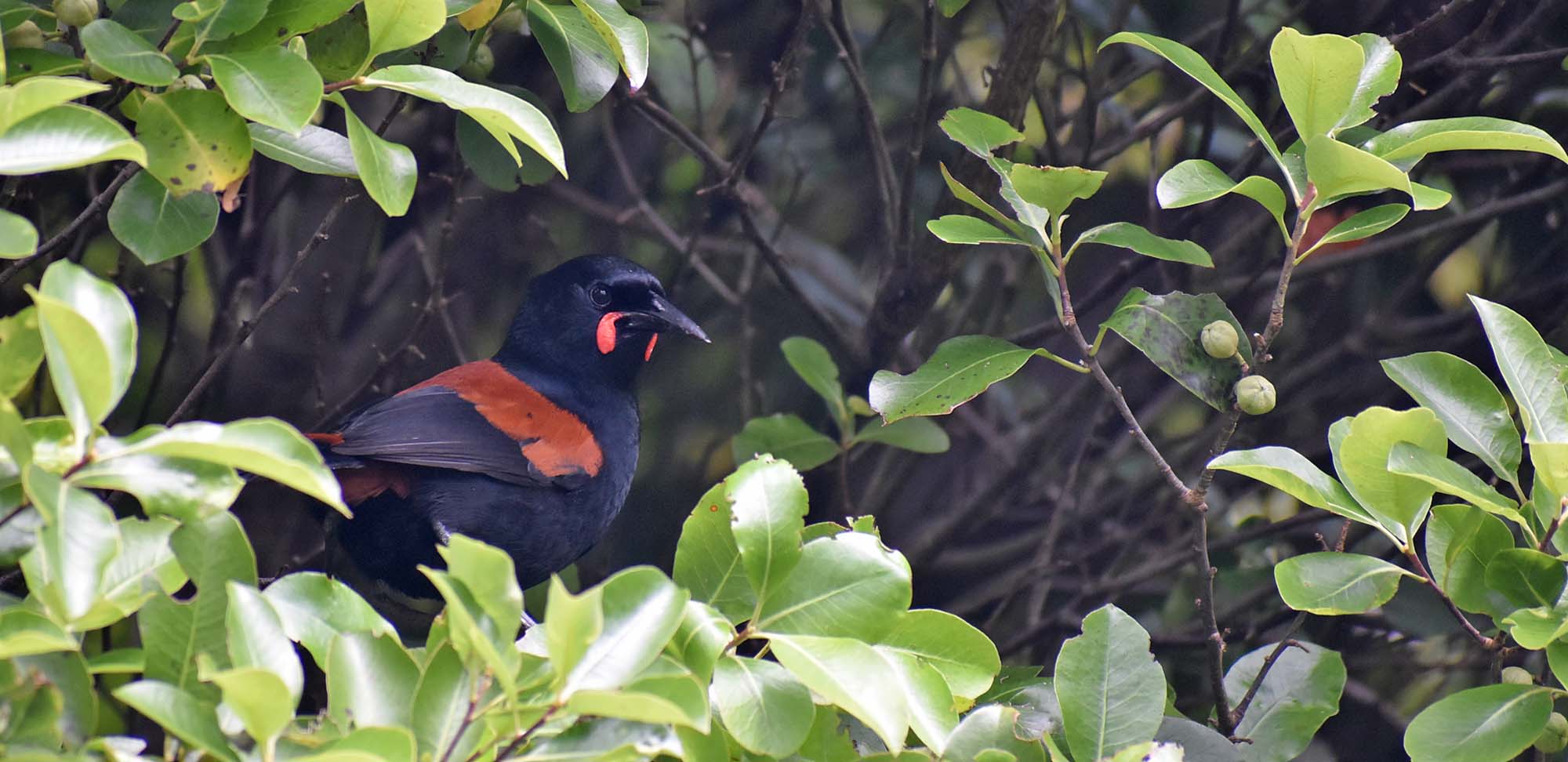

New Zealand
With its picturesque mountains, meadows, and fjords, New Zealand, or Aotearoa ("the land of the long white cloud" in Maori), is an enchanting land that has remained isolated for millions of years, a fact reflected in the near-absence of native land mammals and in the ancient derivation of its avifauna. This is the home of such primitive and endemic families of birds as the amazing kiwis, New Zealand wattlebirds, and the New Zealand wrens. Although New Zealand supports relatively few species of native landbirds, it boasts some forty-five endemics, some of which, such as saddlebacks, Kokako, and Stitchbird (itself a new family), are among the most endangered birds on Earth. It's also richly endowed with seabirds and is one of the cradles of seabird evolution.
Our tour visits some of the wildest and loveliest parts of the islands, with an emphasis on the endemic landbirds, seabirds, and shorebirds. If you are someone who doesn’t like the idea of 12-hour or overnight pelagic trips but want to see albatrosses and other tubenoses, this may be the tour for you! Boat trips off South and Stewart islands and visits to several coastal sites will allow us to experience close at hand the tremendous variety of marine birds and mammals of this region on boat outings lasting less than 4 hours! The short sea-trip off Kaikoura is one of the best pelagics in the world, where you will be nearly within arm’s length of albatrosses and petrels just minutes from shore!
Our travels will take us to many places of great scenic beauty on both North and South islands, from incredible glacier-ringed Milford Sound in Fiordland National Park to the deep-water upwellings off the seaward Kaikouras, the wild and remote Stewart Island, the Northern Royal Albatross nesting colony at Taiaroa Head on the Otago Peninsula, the impressive volcanos of Tongariro National Park, the Firth of Thames with its roosting shorebirds and, finally, Tiritiri Matangi Island, home to a wonderful collection of native landbirds!
Hauraki Gulf Pelagic Extension The short optional extension after the main tour includes an all-day pelagic on the Hauraki Gulf off the northeast coast of the North Island, with New Zealand Storm-Petrel, rediscovered in 2003 after it was believed extinct for 50 years, as the main target.
ITINERARIES • TOUR STATUS • DETAILS • SPACE REQUESTS
- 2025 (PDF expected Feb 2025)
DEPARTURES • We have 3 departures currently scheduled through 2026, with details including limits, guides, fees, and space available listed below.
Nov 9-27, 2024 Guided by: Dan Lane & local guide Tour Manager: Karen Turner Tour Limit: 12 Status: Open - Space is still available on this tour, and we are accepting provisional bookings. No deposit is required until you receive the itinerary. Click below to book space. Tour Fee: $8575 Deposit: $850 REQUEST SPACE OR MORE INFO
Nov 9-27, 2025 Guided by: Dan Lane & local guide Tour Manager: Karen Turner Tour Limit: 12 Status: Provisionally full; waitlist available - The itinerary has not been finalized for this tour. The trip has provisionally filled but, if you are interested, we can waitlist you for the trip. As we do not require deposits until the itinerary and price are finalized, we often have folks drop off a tour when the deposit is required, and so space opens up! Click below to be waitlisted for this tour with no obligation; if you are waitlisted, we will also notify you in case of an added departure of this tour. Tour Fee: Fee TBD / 2024=$8575 REQUEST WAITLIST OR MORE INFO
Nov 8-26, 2026 Guide: TBA Tour Manager: TBA Tour Limit: 12 Status: Open - Space is still available on this tour, and we are accepting provisional bookings. No deposit is required until you receive the itinerary. Click below to book space. Tour Fee: Fee TBD / 2024=$8575 REQUEST SPACE OR MORE INFO
Enjoy looking through the 3 most recent Field Guides triplists for this tour linked below!
- 2023 (Nov departure guided by Dan Lane)
- 2022 (Nov departure guided by Dan Lane)
- 2018 (Nov departure guided by Dan Lane)
- 1800-BIRDING freecall

New Zealand Birding Tour
Tour Spot Available
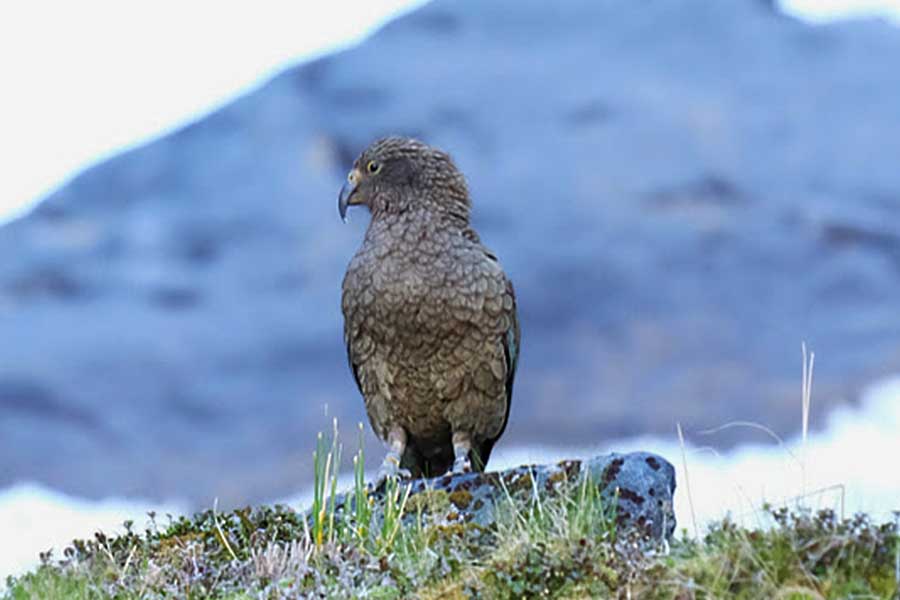
Join us on our birding tour across beautiful New Zealand. Leaving from Auckland and ending in Invercargill, this 14-day tour covers both the North and South Islands and takes in all the best birding spots. We aim to visit such places as Tiritiri Matangi, Miranda, the Central Plateau and Pureora Forest, Manawatu Estuary, Kaikoura, the South Island mountains, Stewart & Ulva Islands, Twizel and Central Otago.
Read on below for more info on our scheduled New Zealand birding tours. We also offer custom tours, privately guided, min. 4 days. Please contact us to discuss.
Birdwatching in New Zealand
New Zealand has many unique bird species and we’ll be looking for representatives of the endemic families – kiwis, NZ parrots, NZ wrens, NZ wattlebirds, NZ creepers, and the stitchbird; in addition, expect species such as Wrybill, New Zealand pigeon, Keas, Kakas, Shags, Wekas and Tuis, Penguins, and even Bellbirds and a variety of seabirds – including Albatrosses – during a half-day pelagic. Expect to see over 120 species: this trip is surely a treat that shouldn’t be missed!
The tour includes a relaxed, bird-rich pelagic trip; night-spotting for Kiwis; spectacular scenery; great camaraderie & good food. Optional add-ons available. (unfortunately, no discounts are available on this tour).
Does our scheduled New Zealand birding tour not suit your timeframe? We also offer custom tours, privately guided, min. 4 days. Please feel free to contact us to discuss.
Featured Birds
- Kaka, Kea, Tui, Stitchbird, Bellbird
- Yellow-eyed & Fairy Penguin
- 4 spp of Shag; Wrybill
- Weka, Kiwis, Takahe, Kokako
- Red-fronted & Yellow-fronted Parakeet
- Rifleman, NZ Pigeon, NZ Dotterel
- Saddleback, Whitehead, Fernbird
- North Island Robin, Sth Island Robin
- Brown Teal, Blue Duck, Tomtit
- sea-birds such as albatrosses, shearwaters, Fairy Prion, Common Diving Petrel, White-fronted Tern, Black-billed & Red-billed Gull
- Paradise Shelduck, Sth Island Pied Oystercatcher
- …and many more!
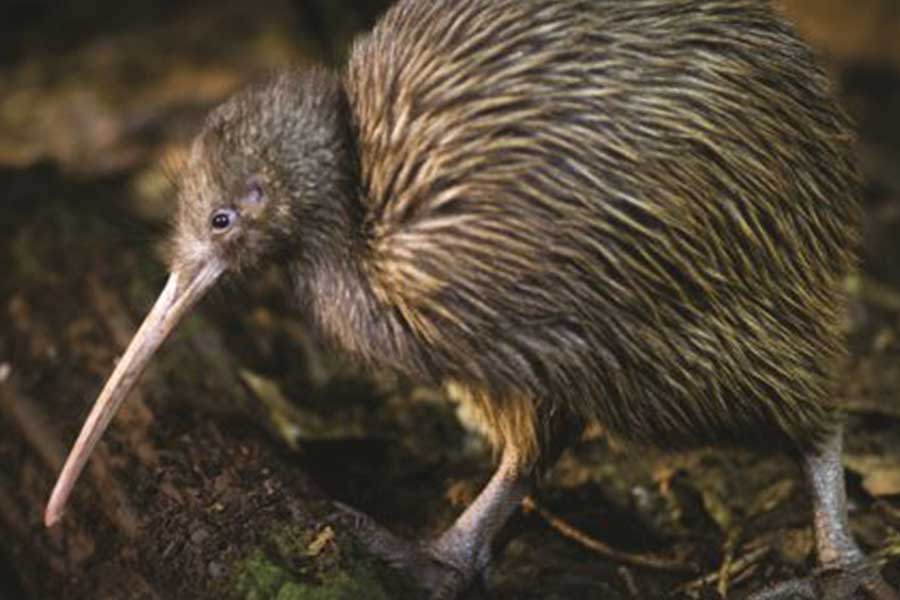
New Zealand: Endemic Extravaganza
Go to: New Zealand Birding Tours | Birding Tours in Australasia | Tours by destination - List
Dates and Costs
30 November – 14 December 2024
Price: NZ$13,980 / $8,752 / £6,983 / €8,161 per person sharing (6 – 10 participants)
Single Supplement: NZ$1,870 / $1,171 / £935 / €1,092
* Please note that currency conversion is calculated in real-time, therefore is subject to slight change. Please refer back to the base price when making final payments.
29 November – 13 December 2025
Price: NZ$15,520 / $9,716 / £7,752 / €9,059 per person sharing (6 – 10 participants)
Single Supplement: NZ$2,075 / $1,299 / £1,036 / €1,212
Recommended Field Guide
(Please also read our blogs about recommended field guides for the seven continents here )
Tour Details
Duration : 15 days Group Size : 6 – 10 Tour Start : Auckland, North Island Tour End : Invercargill, South Island
Please note: The trip leaves Auckland in the morning (approximately 10am) on Day 1; therefore guests should arrive in Auckland a day early. If you need information about Auckland hotels, in the area where it would be easiest for you to be picked up, please notify us, and we will be happy to be of assistance.
Price includes:
All accommodation (as described above from Day 1 through Day 14 see note below) Meals (from dinner on Day 1 until breakfast on Day 15) Expert tour leader and fully licensed local guide National park/birdwatching reserve/protected areas entrance fees Inter-island ferry (Wellington-Picton and Invercargill-Oban-Invercargill) Private transportation during the tour and transfers (possibly shared) to and from the airports Pelagic trips (Kaikoura and Stewart Island) Locally guided kiwi excursions (Tawharanui, Kapiti Island, and Stewart Island) Boat trips as described in itinerary (Gulf Harbour-Tiritiri Matangi-Gulf Harbour, Marlborough Sounds, Otago Harbour, and Stewart Island-Ulva Island-Stewart Island)
Price excludes:
International or domestic flights to get to Auckland and from Invercargill Any pre- or post-tour accommodation, meals, or birding/sightseeing/etc. excursions Optional glowworm cave boat trip on Lake Te Anau (estimated at NZ$120 per person in 2024) Optional boat trip on Milford Sound (estimated at NZ$100 per person in 2024) Visa if required Items of a personal nature, e.g. gifts, laundry, internet access, phone calls, etc. Soft/alcoholic drinks (drinking water is safe from the taps, please bring a refillable water bottle) Personal travel insurance Gratuities ( please see our tipping guidelines blog )
2024 Featured Guide:
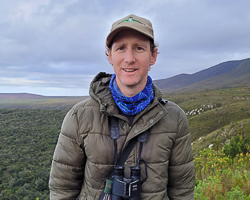
2025 Featured Guide:
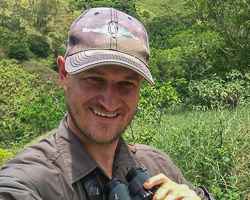
New Zealand Birding Tour: Endemic Extravaganza November 2024/2025
This New Zealand birding tour offers a once-in-a-lifetime experience and one that will live long in your memory. We really love visiting this top birdwatching destination, and we are sure you will too. New Zealand is one of the most remote places on earth, and during 8o million years of isolation a fascinating and unique fauna has evolved. In the absence of mammals, except for bats and marine species, birds became the dominant animals, and they evolved to fill most available niches. Many became flightless, and some grew to be giants, including a huge eagle and the giant browsing moas. Sadly, with the occupation of New Zealand by Polynesians about 800 years ago and Europeans in the 19 th century, many of the endemic species became extinct, including the eagle and the moas. Of those species that survived, some are still common, others are rare but still found on the larger islands, and many are only found in carefully managed populations on small predator-free islands. The stories of how New Zealanders have protected their birds are extraordinary, and these stories play an important role in our New Zealand birding tour.
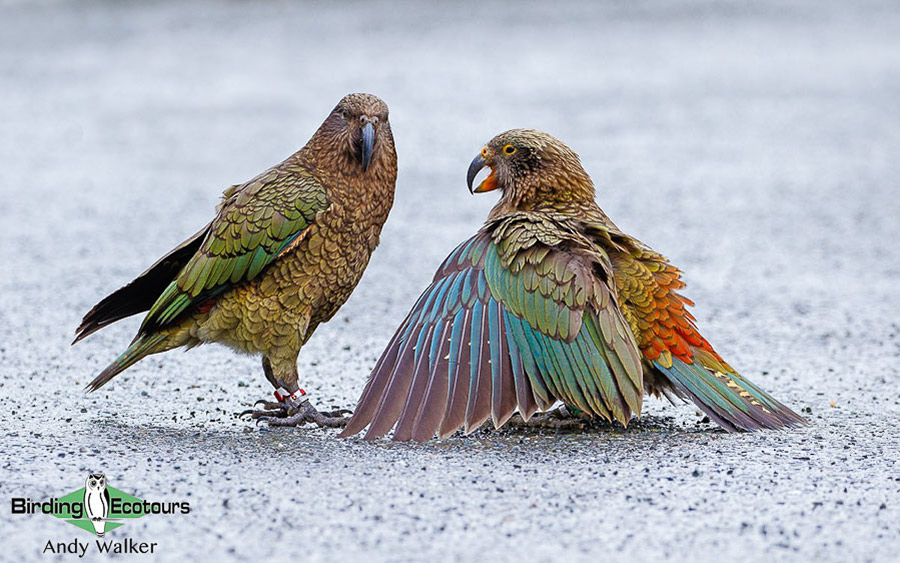
This New Zealand bird tour itinerary is designed to find numerous New Zealand endemic bird species, as well as species introduced by Europeans and the many species that have naturally colonized from Australia. Located in the Southern Ocean, New Zealand is also rich in oceanic species of birds and mammals, and our bird tour includes pelagic trips at key locations.
The tour starts in Auckland from where we will pop over to the excellent Tiritiri Matangi Island , the first of three predator-free islands we will visit, to see rare endemics, including North Island Saddleback and Stitchbird , we will then start our journey south, our first stop on this journey being at the wader haven at Miranda.
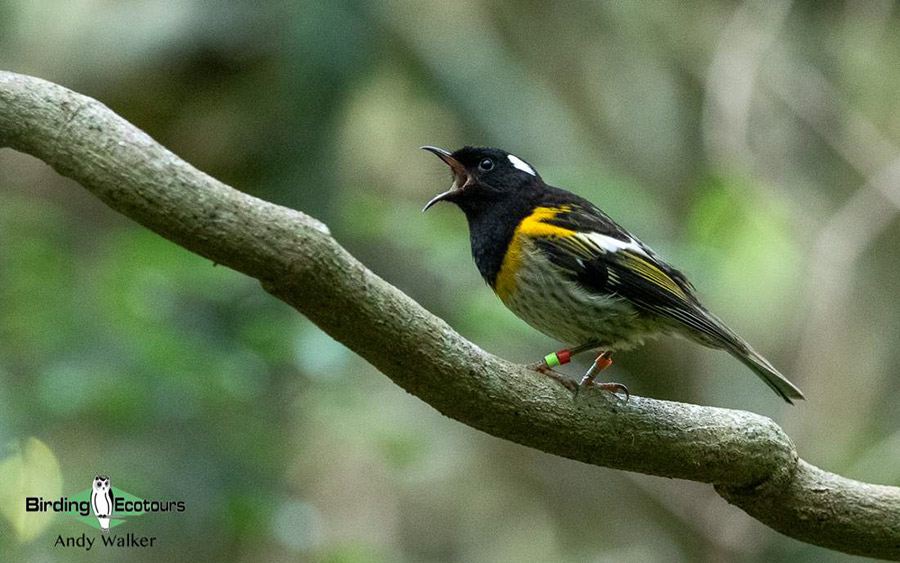
Among the migratory waders we should find at the excellent Pūkorokoro Miranda Shorebird Center and surrounding area, is the only bird in the world with a sideways curving beak, the Wrybill . In the temperate rainforests of the central North Island, such as at the stunning Pureora Forest Park , we hope to find North Island Kokako , New Zealand Kaka , and other forest endemics. In the nearby fast-flowing rivers we look for the very rare Whio – the Blue Duck .
Leaving the volcanic plateau, we will cross over to Kapiti Island , not too far from the city of Wellington on the southernmost tip of North Island. An overnight stay on Kapiti Island will offer us the chance of more highly sought-after endemics, including the gorgeous Little Spotted Kiwi .
After crossing Cook Strait, from Wellington to Picton, by ferry (offering good seabird opportunities), our tour continues on the South Island. During a boat trip in the Marlborough Sounds we visit a colony of New Zealand King (Rough-faced) Shag , which is only found in this isolated location and on Motuara Island, another predator-free reserve.
At beautiful Kaikoura, on the east coast of South Island, a unique phenomenon provides the ideal location for an easy pelagic cruise. This is the only place in New Zealand where there is no continental shelf, and the sea plummets 3,280 feet (1,000 meters) just offshore. Albatrosses, shearwaters, and petrels can be seen just minutes from the shore and give fantastic close views, and marine mammals are abundant. This experience is sure to be a tour highlight.
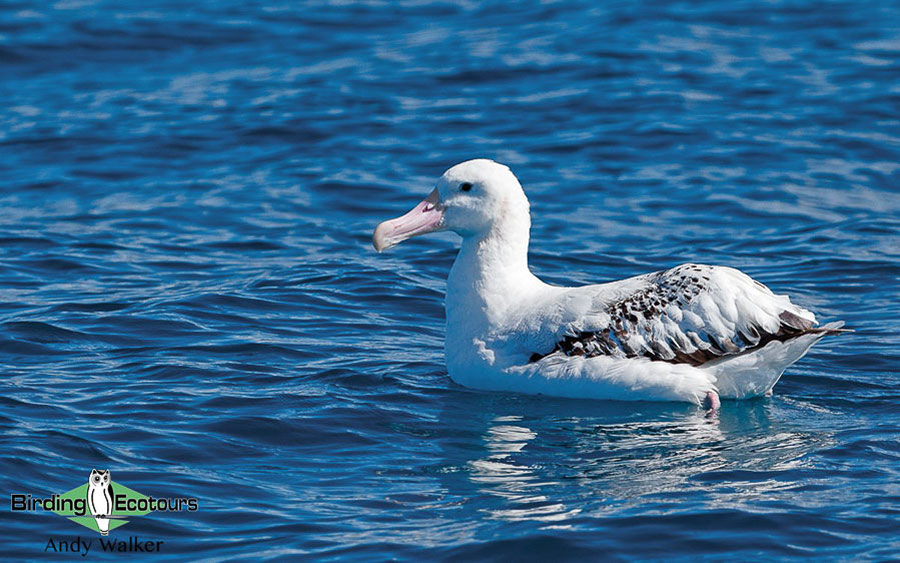
We will leave Kaikoura towards the town of Twizel. This region takes some beating for its beauty, with its many turquoise lakes, braided rivers and the grand, snow-capped peaks of Aoraki Mount Cook National Park . Birding here is a breathtaking experience, as we seek out mega birds such as the Critically Endangered (BirdLife International) Black Stilt , the unique Wrybill , on its breeding grounds, and the striking Double-banded Plover .
Dropping down to the extreme south of South Island we will visit several spots, such as Taiaroa Head and the Royal Albatross Center , the only mainland breeding site of Northern Royal Albatross and a unique opportunity to observe these birds on land at their nests. There is also a colony of the endemic Hoiho – the Yellow-eyed Penguin here.
We will take the short ferry ride across to Stewart Island , New Zealand’s third-largest island. A different set of seabirds are on offer on our pelagic trip here and we will also look for Southern Brown Kiwi . From Stewart Island a short boat ride will see us visit the delightful Ulva Island , which is like stepping into an ancient forested world, and it’s great for rare endemic birds.
To end our tour, we will visit the dramatic fjord called Milford Sound , New Zealand’s most stunning natural attraction, looking for Fiordland Penguin and, amongst the rocks en route, the tiny alpine New Zealand Rockwren . This must-see destination needs to be seen to be believed.
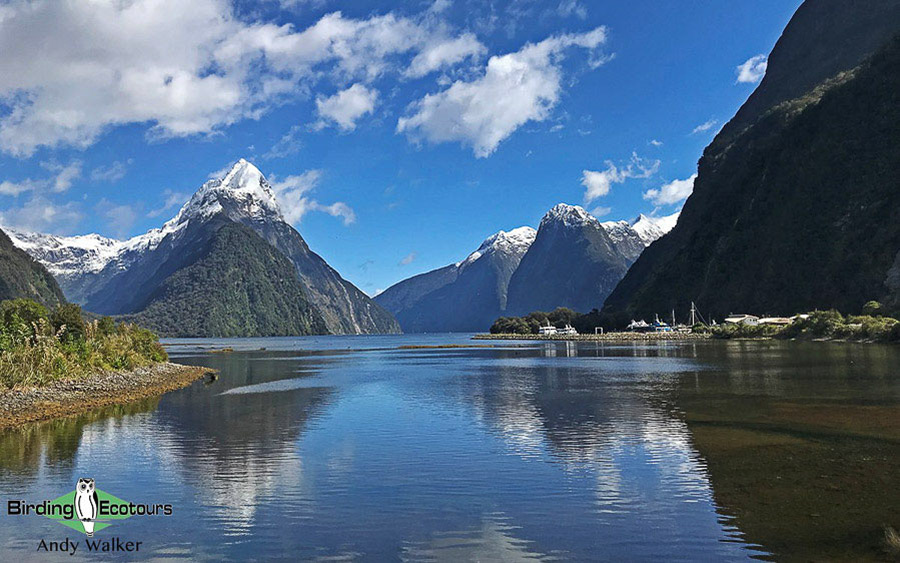
The food in New Zealand is legendary, especially the wonderful fresh seafood, the accommodations are varied and interesting, and the scenery is simply some of the most spectacular on the planet and will take your breath away. Combine the above with the incredible New Zealand endemic birds and we are certain you will have a great birding tour.
Itinerary (15 days/14 nights)
Day 1. auckland to gulf harbour.
A non-birding day. After your morning arrival into Auckland, New Zealand’s capital, on North Island, we will meet and transfer to the picturesque Gulf Harbour, just north of Auckland. We will check into our comfortable lodge in the afternoon for the first two nights of the tour. This location forms an ideal base for our first day of New Zealand birding, tomorrow. If you would like to arrive into Auckland a day or two before the tour (maybe to relax after your flights, get over any jetlag, or do some sightseeing, such as checking out fascinating Hobbiton for example – great for any fans of the Lord of the Rings movies and also some nice birds there!), we can organize extra accommodation for you, just let us know when you book the tour.
Overnight: Whangaparoa Lodge , Gulf Harbour or similar
Day 2. Tiritiri Matangi Island
In the morning we will take a short boat ride to the excellent Tiritiri Matangi Island, a protected haven for threatened species and home to New Zealand’s oldest operating lighthouse. Tiritiri Matangi is a predator-free island, meaning the island is free of rats, possums, hedgehogs, cats, and stoats etc., thus providing a haven for many rare birds (many have been introduced or re-introduced to boost populations). We will visit several such islands during this tour. The restoration of the island started over 40 years ago and the progress made is incredible. We will spend the day on this picturesque island, enjoying everything it has to offer.
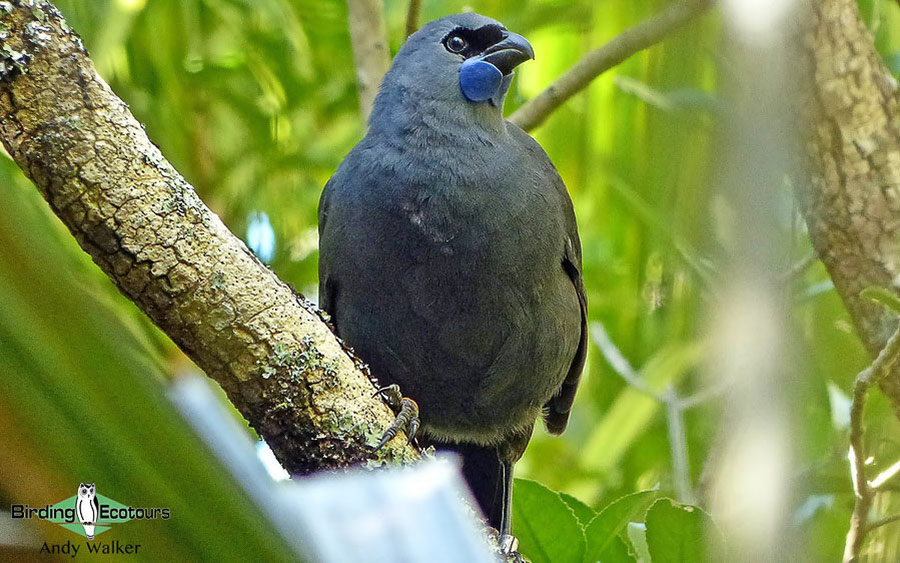
This excursion will offer up our first chance for many exciting localized native land birds, many with intriguing and enticing names, such as North Island Kokako , Stitchbird , Whitehead , New Zealand Fernbird , North Island Saddleback , along with the more familiar-sounding North Island Robin . We will also come across more widespread endemic species such as Tui (a large spectacular honeyeater with an amazing duet), New Zealand Bellbird , New Zealand Fantail , and Grey Gerygone .
The island is also great for rare endemic non-passerines such as the hulking South Island Takahe (a giant swamphen), Brown Teal , and Red-crowned Parakeet . We may also find the widespread endemic Morepork (a Ninox hawk-owl) and the very cute Little Penguin .
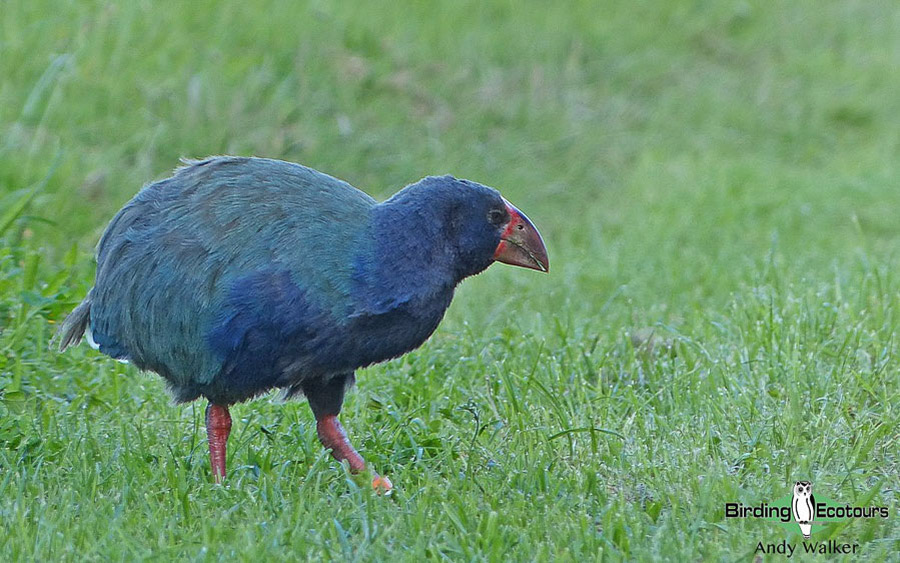
In the evening, back on North Island, we will take a trip out nearby our accommodation to look for North Island Brown Kiwi , our first example of this extremely bizarre (even by New Zealand standards), endemic family.
Day 3. Pūkorokoro Miranda Shorebird Center
Leaving Gulf Harbour behind us for the final time we will drive to the south of Auckland and the excellent Pūkorokoro Miranda Shorebird Center , an important feeding ground and roosting area for many shorebirds (waders) which migrate from the tundra of the Arctic to avoid the northern winter. One of the most famous northern migrants is Bar-tailed Godwit (read about the fascinating migration of this species here ), others can include Far Eastern Curlew , Sharp-tailed Sandpiper , and Red-necked Stint . There are also several interesting endemic shorebirds likely to be present here too, such as the unique Wrybill (though we are likely to see more on their breeding grounds when we get to South Island), South Island Oystercatcher , and New Zealand Plover .
We will continue our journey to Lake Rotorua where we can find New Zealand Grebe and New Zealand Scaup among other waterfowl such as Paradise Shelduck , Australasian Shoveler , and Grey Teal . Rotorua is on the central plateau of North Island with plenty of geothermal activity, we will also visit Waimangu Volcanic Valley , and the nearby boiling mud ponds!
Overnight: Rotorua
Day 4. Pureora Forest Park and Tongariro National Park
The forests at Pureora Forest Park are often referred to as the ‘dinosaur forests’, because they are dominated by ancient conifers in the Podocarpaceae family. Podocarps were the dominant trees in Gondwana 100 million years ago and are still dominant in some of New Zealand’s rainforests today, and no more so than at Pureora. Our morning will be spent in this, one of the finest podocarp forests in the country, where we will experience the haunting call of the North Island Kokako in its natural, misty rainforest environment. We will have most of the day here and will also look for New Zealand Kaka (an endemic parrot), Yellow-crowned Parakeet , Whitehead , North Island Robin , New Zealand Falcon , New Zealand Pigeon , the gorgeous Tomtit , Shining Bronze Cuckoo , with luck the secretive migrant Pacific Long-tailed Cuckoo , Sacred Kingfisher , and New Zealand’s smallest bird, Rifleman .
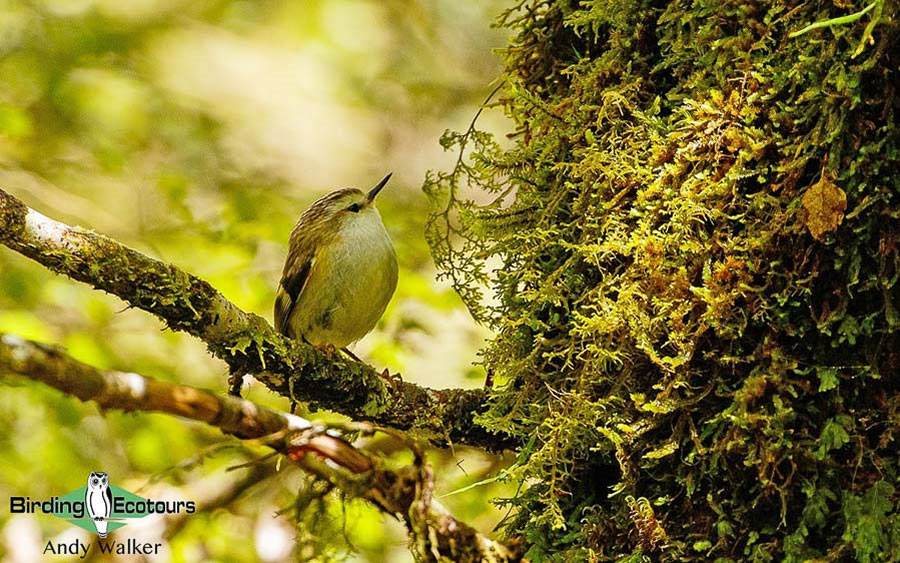
Later in the day we will finish up in Tongariro National Park , New Zealand’s oldest national park, where we will look for the rare Whio – or Blue Duck . They like the fast-flowing rivers coming off the volcano here and they are a very interesting, ancient species.
Overnight: Whakapapa Village
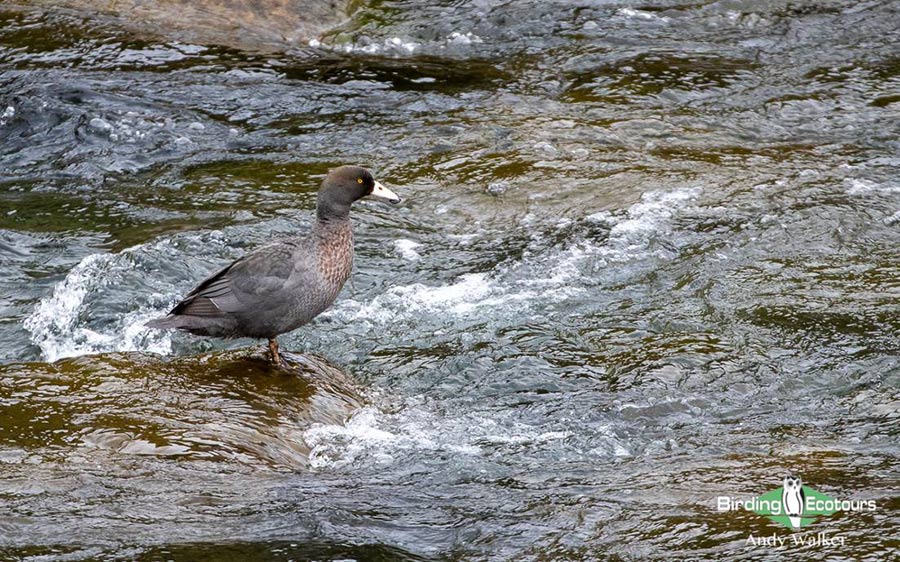
Day 5. Kapiti Island
We will drive south off the volcanic plateau and arrive at Paraparaumu Beach where we will take a short boat ride across to the island sanctuary of Kapiti Island for an overnight stay. While on this small island we will be looking for further views of South Island Takahe , North Island Saddleback , Stitchbird , Tui , Whitehead , Red-crowned Parakeet , North Island Robin , and New Zealand Kaka . However, the main reason for an overnight stay here is to seek out the nocturnal Little Spotted Kiwi as well as Morepork , and Little Penguin .
Overnight: Kapiti Island
Day 6. Kapiti Island to Wellington, ferry to Picton, South Island
We will have the early morning on Kapiti Island, perhaps enjoying views of the species listed above, or something different such as a Variable Oystercatcher , Paradise Shelduck , White-fronted Tern , or a flock of Kelp Gulls before bidding farewell to the island in the mid-morning.
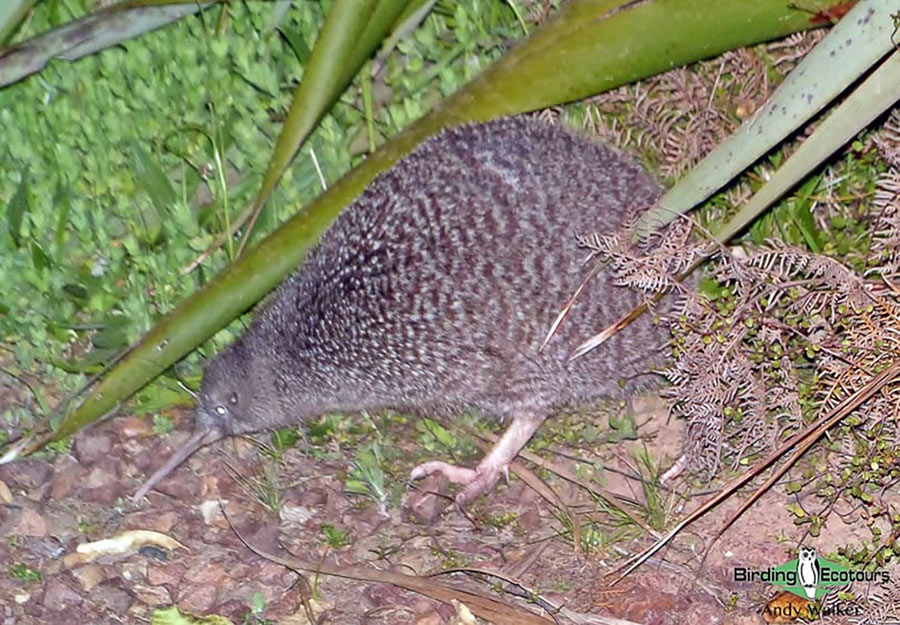
We will then board the large ferry in Wellington on the southern tip of North Island bound for Picton at the northern tip of South Island. The crossing of Cook Strait takes around three hours and it provides another seawatching opportunity with possibilities including Fluttering Shearwater , Hutton’s Shearwater , Sooty Shearwater , Flesh-footed Shearwater , Black Petrel , Westland Petrel , Broad-billed Prion , Fairy Prion , Common Diving Petrel , Parasitic Jaeger (Arctic Skua), Northern Giant Petrel , Antipodean Albatross , and Shy (White-capped) Albatross . We will stay overnight near the ferry terminal in town.
Overnight: Picton
Day 7. Marlborough Sounds (Queen Charlotte Sound) then to Kaikoura
Our morning will be spent birding our way through Queen Charlotte Sound. We will have seen some of the area on the ferry the previous evening, as we came into Picton, but this will be a more specific birding trip and we will make our way to a small rocky island where a small colony of the very localized New Zealand King (Rough-faced) Shag breeds and roosts. We could also see the widespread Australian Pied Cormorant and Little Cormorant , and we may also encounter the interesting Weka , a flightless member of the Rallidae family.
In the mid-afternoon we will drive down the east coast of South Island to the famed town of Kaikoura (a pelagic paradise), where we will spend the next two nights.
Overnight: Kaikoura
Day 8. Kaikoura Pelagic
With a backdrop of steep mountains and the sea that plummets into a deep ocean trough, Kaikoura is not only spectacular to look at but also a perfect habitat for pelagic animals. Sperm Whales are resident, Humpback Whales are seasonal visitors, Dusky Dolphins are abundant, the tiny, rare Hector’s Dolphin is frequently seen, and there is a New Zealand Fur Seal colony close to the town. Pelagic birds, including albatrosses and giant petrels, are often seen from the shore. Hutton’s Shearwater breeds near the tops of the 8,200-foot (2,500-meter) mountain range behind the town and can often be seen in vast flocks wheeling around just offshore. Not surprisingly, Kaikoura’s economy is based on whale watching, swimming with dolphins, and albatross viewing, as well as commercial diving for crayfish and pāua (abalone).
An early-morning outing on the ocean from Kaikoura is the best possible way to start the day. Because conditions are so perfect for pelagic birds, we do not need to travel far, or for long, but we do see a lot of species. Possibilities include Antipodean Albatross , Northern Royal Albatross , Southern Royal Albatross , Shy Albatross , Salvin’s Albatross , Buller’s Albatross , Black-browed Albatross , Southern Giant Petrel , Northern Giant Petrel , Common Diving Petrel , Westland Petrel , White-chinned Petrel , Hutton’s Shearwater , Buller’s Shearwater , and the abundant Cape Petrel .
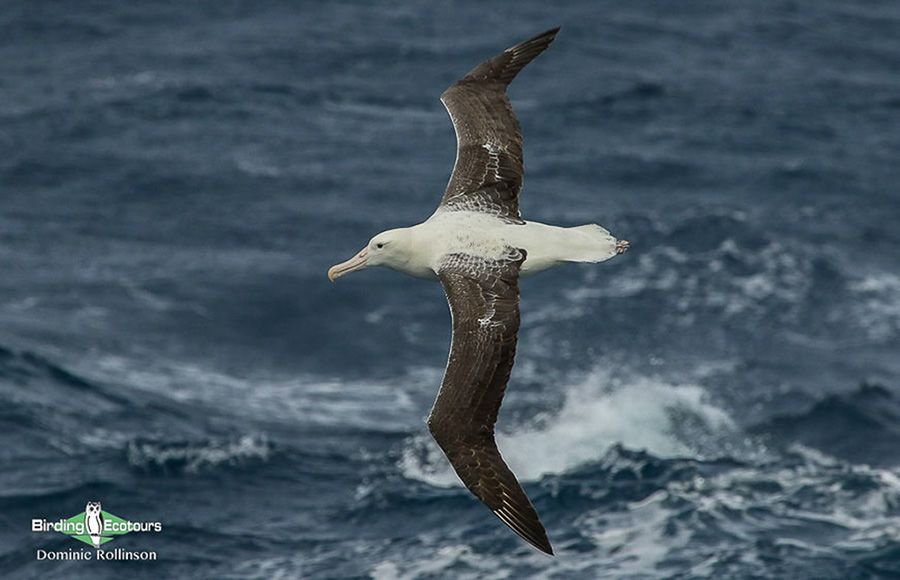
The afternoon will be at your leisure to take a stroll on Kaikoura Peninsula or edit the hundreds of photos you will have likely taken on the boat trip!
Day 9. Kaikoura to Twizel
As well as targeting pelagic species at Kaikoura, we will also look for a rare introduced species, Cirl Bunting . Throughout our tour we will also see a number of species introduced from Europe, including Eurasian Skylark , Common Chaffinch , Yellowhammer , European Greenfinch , European Goldfinch , Common Redpoll , Common Blackbird , Song Thrush , House Sparrow , and Dunnock . These birds might not be of too much interest for European birders but might be so for birders from other parts of the world.
After our birding in Kaikoura, we will drive south to the town of Twizel.
Overnight: Twizel
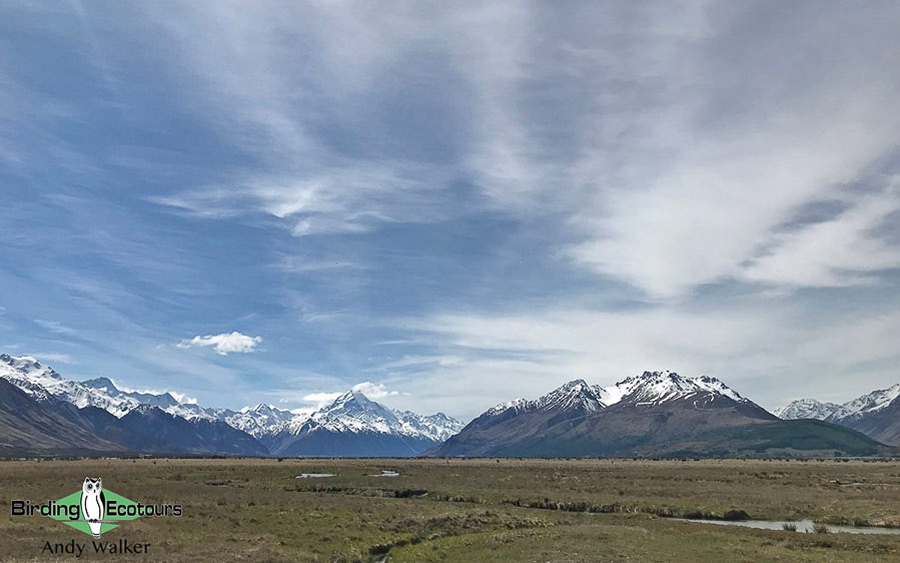
Day 10. Twizel to Dunedin
There are many great birds on offer this morning, gorgeous Black-fronted Tern , New Zealand Pipit , South Island Oystercatcher , Paradise Shelduck , and Swamp Harrier . However, there are three species of endemic shorebird to be found here, and these will form the focus of our attention. The Kaki or Black Stilt , which is one of New Zealand’s rarest birds, breeds along the rivers in this area, and we will spend time looking for this elusive bird. Like so many rare New Zealand birds it owes its survival to micro-management by conservation authorities, who operate captive breeding facilities, and private conservation groups.
We will also search around the braided rivers for breeding Wrybill and the pretty Double-banded Plover (a New Zealand breeding endemic which migrates to Australia during the non-breeding season).
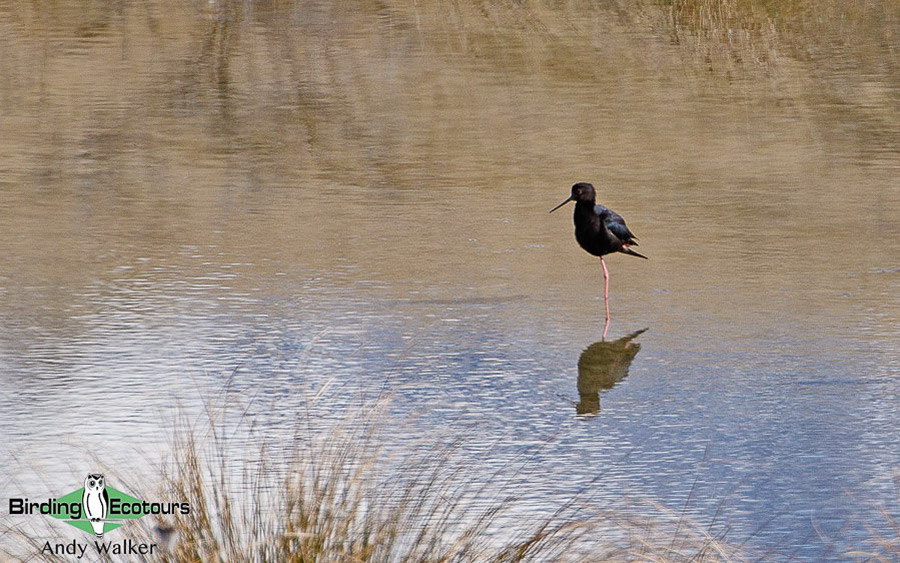
After concluding our birding here, we will continue to the city of Dunedin on the south coast of South Island. A charming cruise from Otago Harbour will take us around Taiaroa Head, the only mainland breeding site of Northern Royal Albatross , a huge bird with a wingspan of over 120 inches (three meters)! Here too, we will look for Spotted Shag , Otago Shag (another very localized endemic), and Silver Gull (of the endemic form, sometimes split and referred to as Red-billed Gull). Here we will also be on the lookout for Hoiho – Yellow-eyed Penguin and Little Penguin , both of which breed in the area.
Overnight: Dunedin
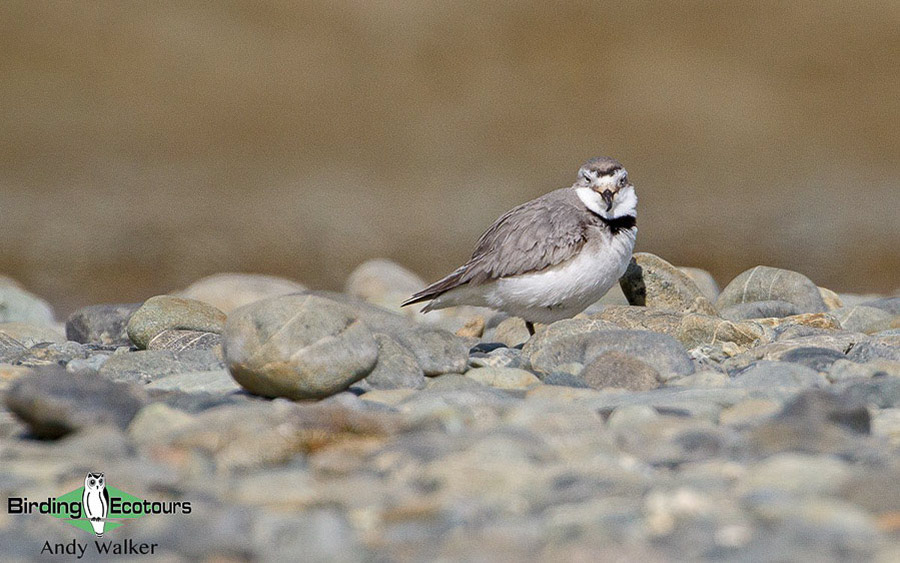
Day 11. Stewart Island
We depart Dunedin for Invercargill, where we will board the fast ferry to Stewart Island. We will base ourselves in the village of Oban for two nights on this gorgeous, almost pristine, island. Although not a pelagic trip as such, this ferry ride does offer an extra chance for a few new seabirds, maybe Australasian Gannet , Salvin’s Albatross , or Buller’s Albatross .
The main activity in Oban will be a nighttime quest to find Southern Brown Kiwi , potentially the final of New Zealand’s kiwis on our trip. We will have enjoyed some great food during the tour and the fresh seafood in Oban is sure to rate as some of the best.
Overnight: Oban
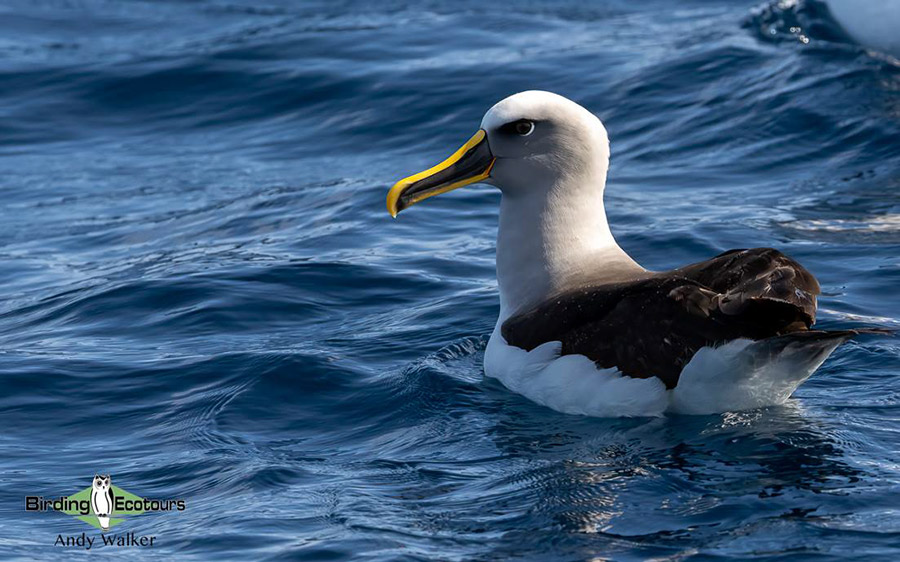
Day 12. Stewart Island birding, Paterson Inlet and Ulva Island
A charter boat will pick us up and we will delve into the South Pacific and Paterson Inlet. We will look for Yellow-eyed Penguin , Fiordland Penguin , Little Penguin , Foveaux Shag (a new English name for what was previously Stewart Island Shag, after the split of Otago Shag, a bird we will have looked for on the Otago Peninsula a few days prior), Buller’s Albatross , Shy (White-capped) Albatross , Salvin’s Albatross , Brown Skua , and Common Diving Petrel .
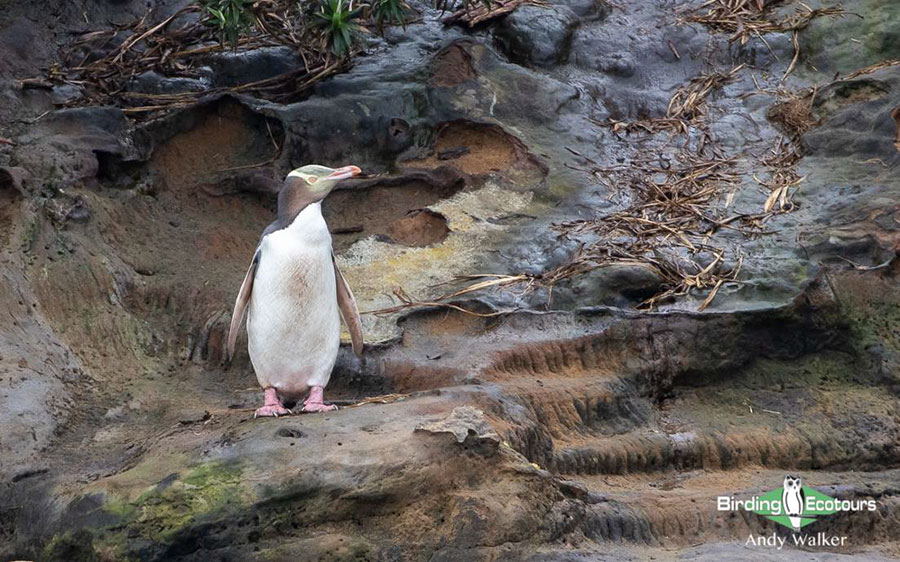
A treat awaits us in the afternoon on the island sanctuary of Ulva Island . This primeval forest on the island is amazing and a great trail network allows easy exploration. The island comes complete with some really special birds and many of these are extremely approachable allowing for great photo opportunities.
We will be on the lookout for as many of the specials as possible during our visit, depending on what we have seen over the previous two weeks of the tour. Potential targets include South Island Robin , South Island Saddleback , Yellowhead , Pipipi (New Zealand Brown Creeper), Tomtit , Grey Gerygone , Morepork , Yellow-crowned Parakeet , Red-crowned Parakeet , New Zealand Kaka , New Zealand Pigeon , New Zealand Bellbird , Tui , New Zealand Fantail , Variable Oystercatcher , and Weka .
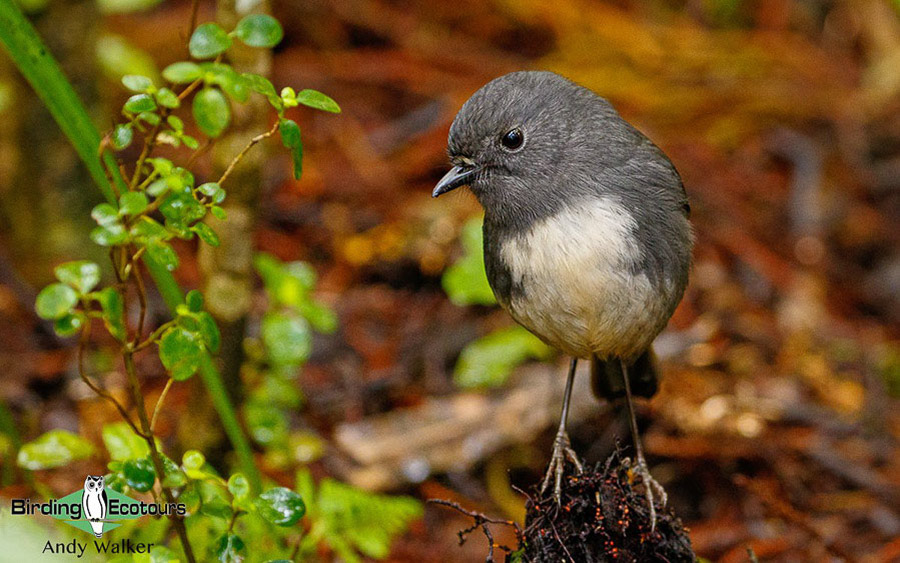
Occasionally New Zealand Sea Lions might haul themselves out of the ocean onto the beaches of Ulva Island, a rather spectacular sight.
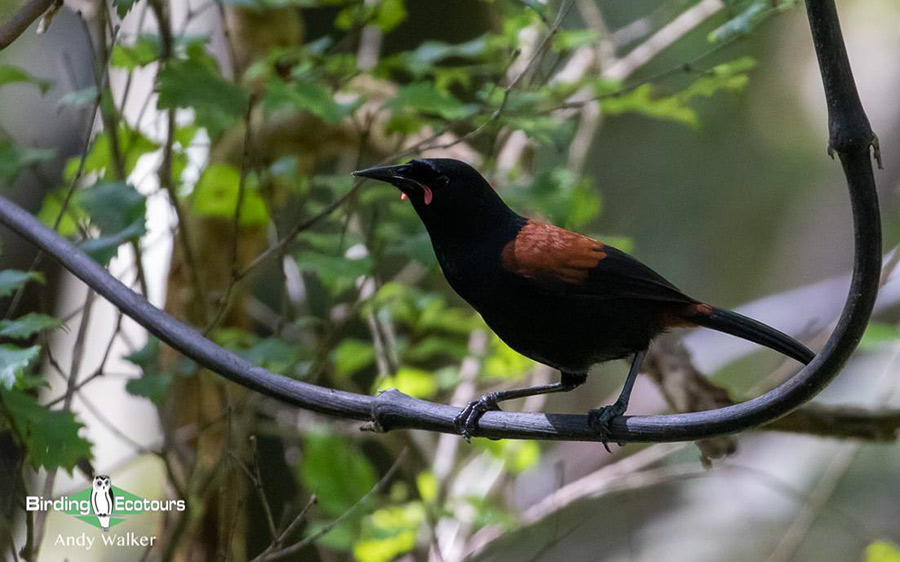
Day 13. Stewart Island to Te Anau
We will bid farewell to the beautiful Stewart Island (looking out for any further pelagic species on what will be the final ocean trip of the tour). Back on the mainland we will start a small loop of the southwestern section of South Island. We will be suitably enticed by the glacially sculptured mountains and valleys of Fiordland National Park (even more stunning scenery, to go with all of the rest we will have enjoyed during the tour). Not far from the town of Te Anau, our base for the final two nights of the tour, we will drop in to the beech forests of Eglinton Valley where we will look for Yellowhead , New Zealand Kaka , and Yellow-crowned Parakeet . There is the optional-extra of a trip across Lake Te Anau in the evening to view the famed 12,000-year-old Te Anau Caves and their glowworms (cost not included).
Overnight: Te Anau
Day 14. Milford Sound
Leaving Te Anau for the day, we will head towards Milford Sound. A drive along the Eglinton River to Hollyford Valley will delight us with spectacular mountain scenery. In the valley we will seek out some unique endemic species, with New Zealand Rockwren being one of the main targets. Also high on the ‘wanted list’ will be Blue Duck , which we should have already seen on North Island, but will not complain at another look at this rare bird. Other birds possible today include Tomtit , Rifleman , New Zealand Kaka , Kea , Pipipi (New Zealand Brown Creeper), and many more.
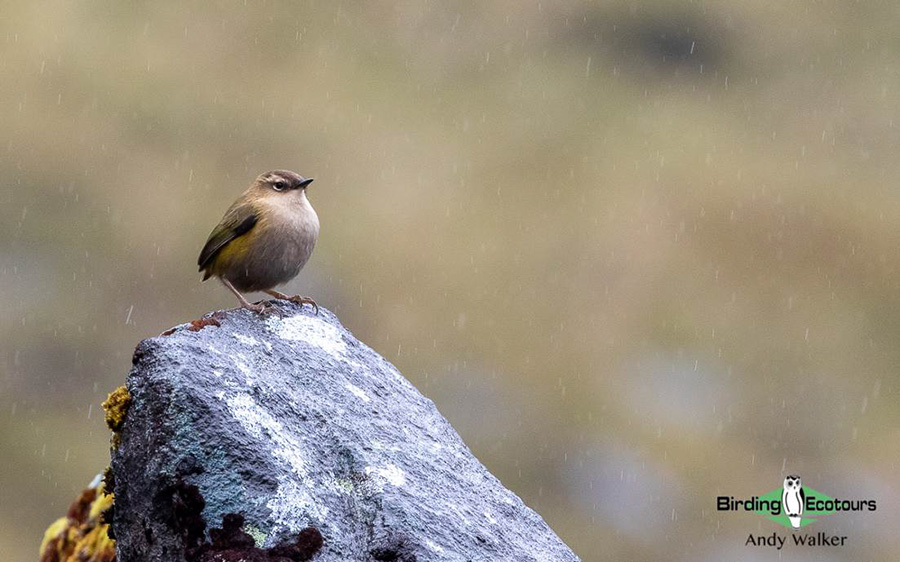
There is an optional-extra boat cruise on Milford Sound (which is actually an impressive fjord) in the afternoon, during which there is a chance of Fiordland Penguin and some great scenic photographs of hanging valleys and cascading waterfalls.
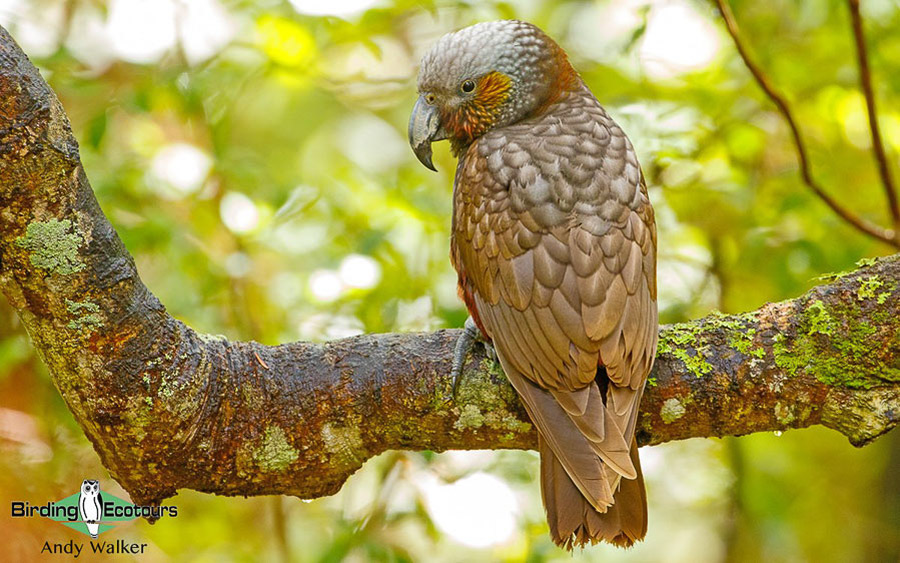
Day 15. Te Anau to Invercargill where tour ends
We will reluctantly leave the land of fjords and complete this southwestern loop of South Island and indeed our whole New Zealand tour. We will reach Invercargill in the early afternoon where the tour will conclude, selecting “bird of the trip” should be fun!
Overnight: Not included
Please note that the itinerary cannot be guaranteed as it is only a rough guide and can be changed (usually slightly) due to factors such as availability of accommodation, updated information on the state of accommodation, roads, or birding sites, the discretion of the guides and other factors.
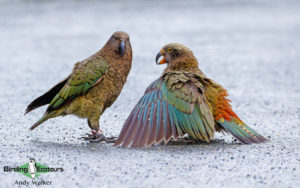
New Zealand Storm Petrel
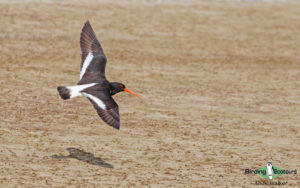
South Island Oystercatcher
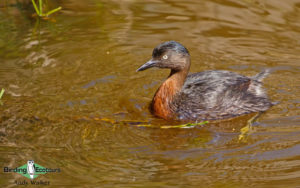
New Zealand Grebe
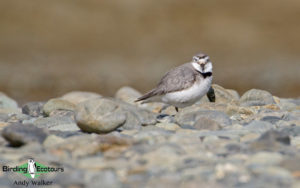
South Island Saddleback
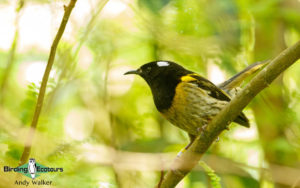
New Zealand Fantail
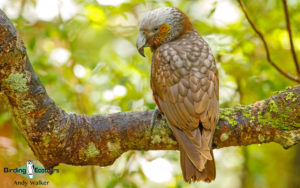
New Zealand Kaka
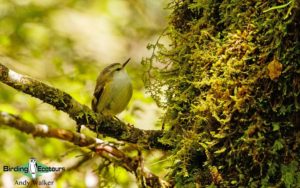
Red-crowned Parakeet
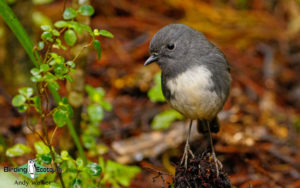
South Island Robin
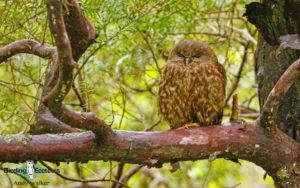
Fluttering Shearwater
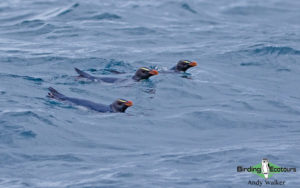
Fiordland Penguin
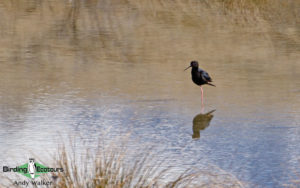
Black Stilt
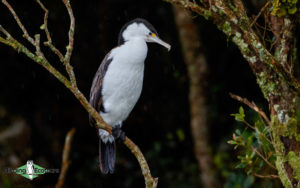
Australian Pied Cormorant
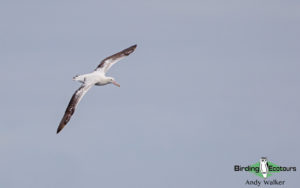
Antipodean Albatross
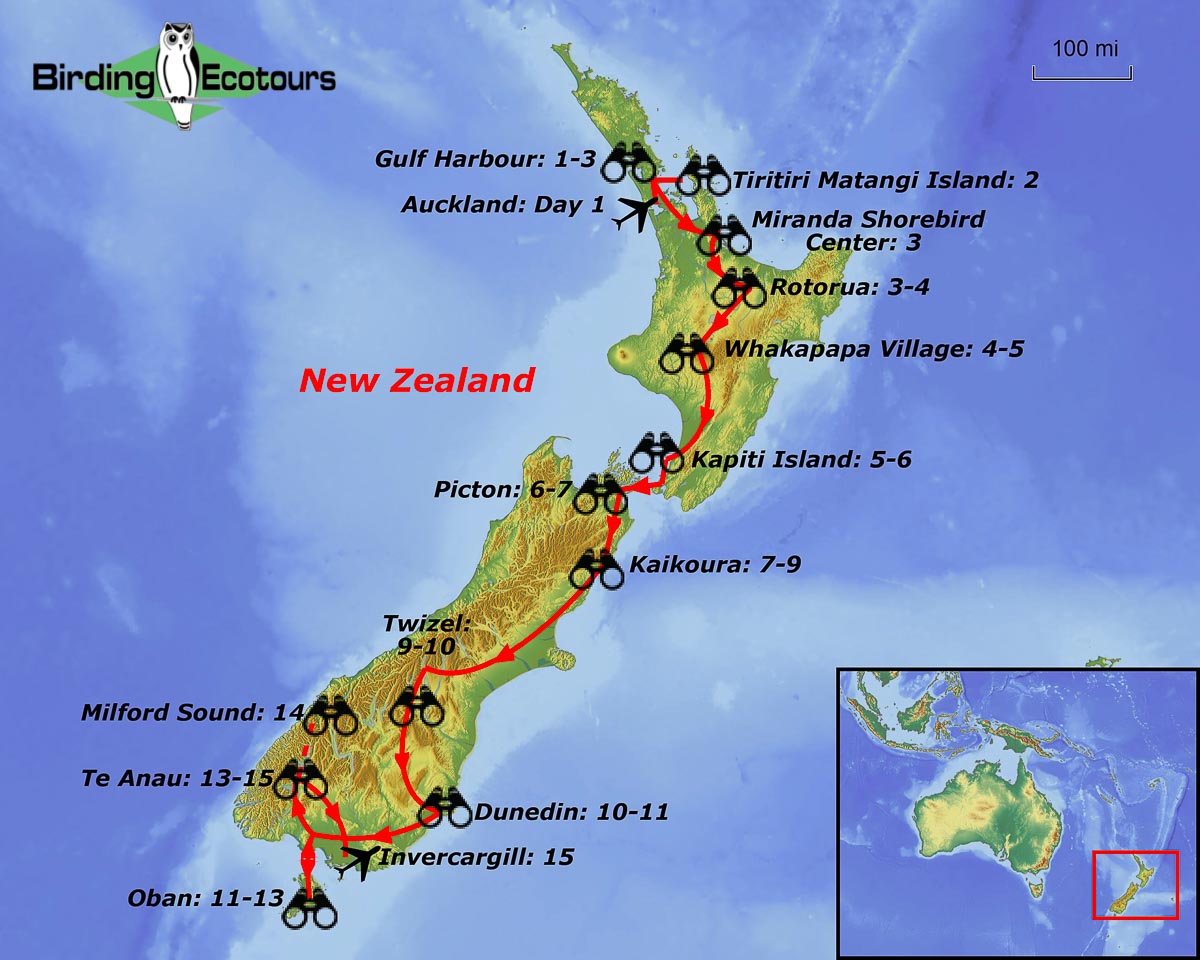
New Zealand – Birding Extravaganza Set Departure Tour Trip Report
10 – 27 october 2022, by andy walker.
DOWNLOAD TRIP REPORT
This comprehensive New Zealand tour started in Auckland, North Island on the 10 th of October 2022 and ended in Dunedin, South Island on the 27 th of October 2022. We visited Tawharanui Regional Park, Tiritiri Matangi Island, Pūkorokoro Miranda Shorebird Centre, Pureora Forest Park, Tongariro National Park, Kapiti Island, Blumine Island, Arthur’s Pass National Park, Okarito Lagoon, Mount Aspiring National Park, Tasman Delta, Taiaroa Head, Stewart Island (Rakiura), Ulva Island, Te Anau, Milford Sound, and Homer Tunnel. We also took several pelagic trips, such as at Hauraki Gulf, Queen Charlotte Sound, Kaikoura, Dunedin, and at Stewart Island (Rakiura).
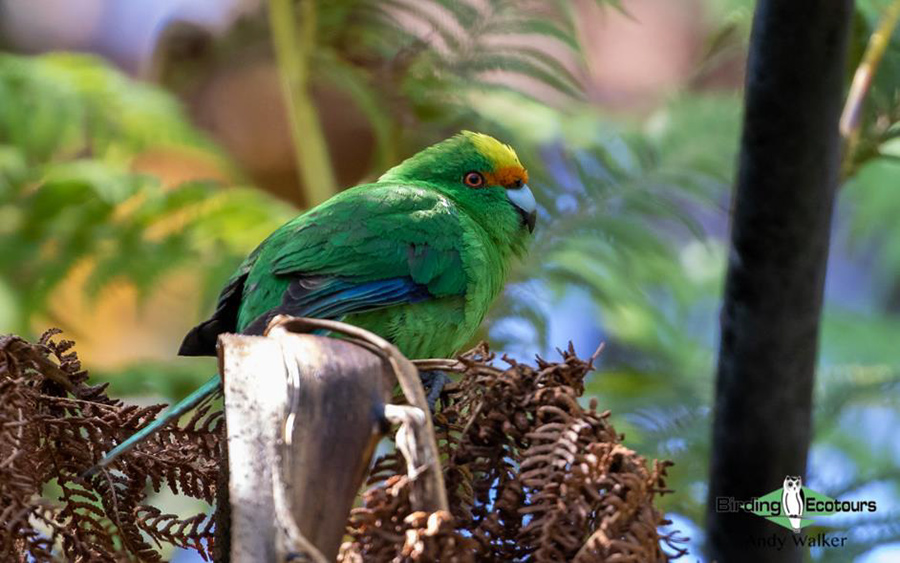
We got some great looks at the Critically Endangered ( BirdLife International ) Malherbe’s Parakeet during our New Zealand birding tour; this is one of the rarest parrots in the world.
During the tour we recorded numerous New Zealand endemic birds (almost 50 species), highlights included Little Spotted Kiwi , North Island Brown Kiwi , Southern Brown Kiwi , Brown Teal , New Zealand Falcon , Wrybill , Black Stilt , Blue Duck , Malherbe’s Parakeet , New Zealand Kaka , Kea , North Island Saddleback , South Island Saddleback , Stitchbird , Tomtit , Yellowhead , Pipipi , North Island Robin , South Island Robin , New Zealand Rockwren , and Rifleman . Several breeding-endemics were also found, like the stunning Double-banded Plover .
The waters around New Zealand are blessed with huge numbers of incredible seabirds, and it is no surprise that they featured heavily during the tour. Albatrosses, penguins, petrels, cormorants, and shearwaters were recorded in good numbers and diversity and included Buller’s Albatross , Northern Royal Albatross , Cook’s Petrel , New Zealand King Shag , Fiordland Penguin , and Yellow-eyed Penguin to name just a few. New Zealand’s avifauna now also includes introduced species from Europe , Asia , and Australia (some making it under their own steam from the latter region) and many of these were also observed during the tour. Native species, such as Pacific Long-tailed Cuckoo , Shining Bronze Cuckoo , and Sacred Kingfisher were also recorded.

Stitchbird was a highly desired New Zealand endemic bird that gave us some fantastic sightings.
Detailed Report
Day 1, 10 th october 2022. arrival in auckland and transfer to warkworth with afternoon birding at tawharanui regional park.
The group met in downtown Auckland at lunchtime where we met our excellent local guides Mark and Richard, who would take us on our long and winding journey from northern to southern New Zealand. A few of the group had arrived earlier than the tour start date and had explored Auckland city (including Auckland Zoo ) and even made the trip down to Hobbiton to visit the “The Lord of the Rings” and “The Hobbit” film trilogies set!
We drove north out of Auckland city over the harbor bridge, heading towards our quaint accommodation for the first night of the tour in the town of Warkworth, just about an hour north of the city. After a quick check in we drove out to Tawharanui Regional Park where we had some afternoon tea and got our birding underway with a few endemics, such as Brown Teal , Paradise Shelduck , Variable Oystercatcher , New Zealand Pigeon , Tui , Whitehead , Grey Gerygone , and New Zealand Fantail all seen well. More widespread resident and introduced species were also noted, such as Swamp Harrier , Australasian Swamphen (in very high numbers), Sacred Kingfisher , White-faced Heron , Common Myna , Song Thrush , Common Blackbird , Silvereye , and European Goldfinch .
We dropped back into town for dinner and bed, ready for the pelagic the following day.
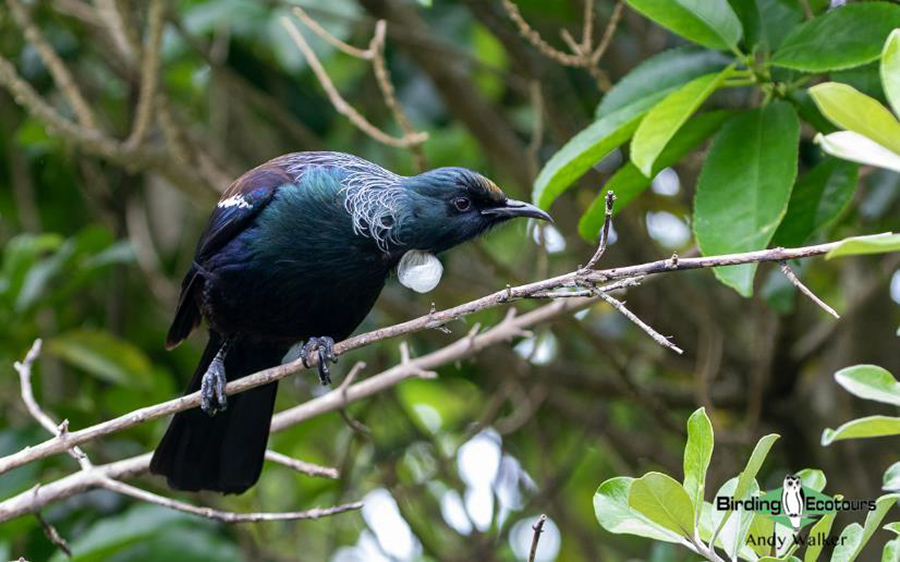
One of the commonest and most widespread of the New Zealand endemics, the Tui is one charismatic and attractive bird, with an incredible vocal repertoire.
Day 2, 11 th October 2022. Hauraki Gulf pelagic and Tawharanui Regional Park kiwi trek
We headed into the Hauraki Gulf for our first pelagic trip of the tour. As we left the marina, we noted Silver (Red-billed) Gull , Kelp Gull , Pied Cormorant , African Collared (Barbary) Dove , and White-fronted Tern . As we progressed out to sea, we picked up Fluttering Shearwater , Little Shearwater , Common Diving Petrel , Australasian Gannet , and Bryde’s Whale .
We reached a particular point on our pelagic and started putting the burley (chum) out. It didn’t take too long to pay rewards and soon we had a couple of Flesh-footed Shearwaters coming to the back of the boat, along with Cook’s Petrel , White-faced Storm Petrel , Fairy Prion , Buller’s Shearwater , and Sooty Shearwater . There was excitement when first a Shy (White-capped) Albatross flew in behind the boat, and then shortly afterwards a Salvin’s Albatross flew in too, allowing for comparisons to be made between both species. To top it off we then had a Buller’s Albatross fly in, and this bird would remain with us on and off all day, what a spectacular sight.

This Buller’s Albatross spent quite a while visiting the boat during the morning and the afternoon. It was very interested in our burley (chum) and an early “bird of the trip” contender!
We took our lunch up close to one of the small islands, so we were out of the wind. While here we picked up a few distant endemic land birds and enjoyed listening to some native New Zealand bird song. As we left the sheltered spot, we soon found a Humpback Whale , which gave some excellent views, as did a Northern Giant Petrel . Our journey back to the harbor was filled with the same species as previously mentioned and better views of some species, such as Fluttering Shearwater . As the tide had dropped, we saw several New Zealand Plovers on the sandflats. In the evening we headed back to Tawharanui Regional Park where saw Morepork (a hawk-owl), and some of the group saw North Island Brown Kiwi during a kiwi walk. We arrived back at our accommodation quite late after a very long, but very rewarding day birding in New Zealand!
Day 3, 12 th October 2022. Tiritiri Matangi Island birding
After breakfast we took the short ferry ride across from Gulf Harbour to Tiritiri Matangi Island, a predator-free island that contains many rare New Zealand endemic birds. As soon as we landed we started birding and we walked around the island during the morning and early afternoon. During our time on this beautiful island, we found lots of key target birds, including North Island Kokako and Stitchbird , both were collecting nesting material and showed well. North Island Saddleback , Red-crowned Parakeet , and New Zealand Bellbird gave us some good views too, and we also had our best views so far of endemics like Whitehead and Tui , and we found a roosting Morepork too. Around the coastline of the island, we noted White-fronted Tern , Silver (Red-billed) Gull , Kelp Gull , Paradise Shelduck , and Variable Oystercatcher .
It was also great to hear the bird song here, very few non-native species were present and the song filling the air was pretty much just that of native species, giving a glimpse into the past, and what it must have been like hundreds of years ago before settlement. After an enjoyable day we headed back into Auckland where we spent the night.

This North Island Kokako was collecting nesting material when we found it.
Day 4, 13 th October 2022. Pūkorokoro Miranda Shorebird Centre and travel to Rotorua
Leaving Auckland for the final time we started our journey south through New Zealand. Our first stop was the Pūkorokoro Miranda Shorebird Centre and we then called in to the nearby Piako Floodplain. Both of these sites yielded lots of new birds for the tour and included the endemic and highly sought-after shorebird, Wrybill , along with two breeding-endemics, Double-banded Plover and White-fronted Tern . Other resident birds present include Black-billed Gull , Pied Stilt , South Island Oystercatcher , Variable Oystercatcher , Masked Lapwing , Black Swan , Paradise Shelduck , Grey Teal , Australasian Shelduck , Royal Spoonbill , Caspian Tern , and Swamp Harrier .
The area is hugely important for birds on the East Asian-Australasian Flyway , and we found several migratory shorebirds during our visit, including thousands of Bar-tailed Godwit , along with Black-tailed Godwit , Pacific Golden Plover , Red Knot , Curlew Sandpiper , and Sharp-tailed Sandpiper . A flock of uncommon Eastern Cattle Egrets flying over was a nice surprise.
After lunch we drove south, down to Rotorua, where we visited the large Rotorua Lake. Here we found New Zealand Grebe , New Zealand Scaup , and had a good lesson on cormorant identification, with Great Cormorant , Pied Cormorant , Little Pied Cormorant , and Little Black Cormorant all being present! A New Zealand Fantail and flock of male Common Chaffinches gave us some nice views as we were leaving the site for our hotel, just before a huge rainstorm enveloped the area for the night.
Day 5, 14 th October 2022. Birding Pureora Forest Park and Tongariro National Park
We started the day with some birding not too far out of Rotorua, where we found our first North Island Robins , we also saw several other species here, with some of the group getting brief views of New Zealand Falcon . A mix of common and widespread endemics were also found, and a Shining Bronze Cuckoo was heard distantly calling but couldn’t be seen as it was too distant. Next, we moved on to Pureora Forest Park, where we found our first Tomtit . It was a bit high in the canopy, but eventually came a bit lower. Here, we also found Yellow-crowned Parakeet , one of our main targets for the site, Pacific Long-tailed Cuckoo , and our best views so far of New Zealand Kaka . We commenced our journey south, hearing Australasian Bittern and New Zealand Fernbird along the way in rather windy conditions.

Blue Duck gave us some great views in a fast-flowing mountain river.
Nearing our accommodation in Tongariro National Park we called in at some fast-flowing streams where we found our big target, the rare and localized endemic, Blue Duck . While watching a pair of ducks we also found our first New Zealand Pipit and had further looks at an attractive Tomtit .
Day 6, 15th October 2022. Tongariro National Park to Kapiti Island
We awoke to a cold crisp morning and a spectacular view of snow-covered Mount Ngauruhoe and Mount Ruapehu. We took a drive up the mountain after breakfast to gain an even more spectacular view that even included Mount Taranaki bursting out of the clouds at Egmont National Park, some 254 kilometers (158 miles) away to the southwest! A couple of New Zealand Pipits were noted, but not a lot else, though the view was why we’d really come here. We started our journey down to the southwest of North Island and we called in at the Manawatu Estuary (some seeing Rook along the way). We had our lunch at the estuary where we saw Wrybill , New Zealand Plover , Double-banded Plover , Bar-tailed Godwit , Ruddy Turnstone , Red Knot , and Masked Lapwing . A flock of White-fronted Terns were rather flighty but gave some good views.
We arrived in Paraparaumu where we boarded our speedboat for a quick crossing to the idyllic Kapiti Island. During the remainder of the afternoon, we took a walk around a forested part of the island, finding our first Weka of the tour, along with plenty of other New Zealand/North Island endemics, such as New Zealand Kaka , Red-crowned Parakeet , New Zealand Pigeon , New Zealand Fantail , Tui , New Zealand Bellbird , Whitehead , North Island Saddleback , and North Island Robin . Watching a family of fantails provided lots of entertainment and won the “cute factor” award! A small wetland held a family of Brown Teal , along with Australasian Shoveler , Paradise Shelduck , Black Swan , Australasian Swamphen , and Pied Stilt .
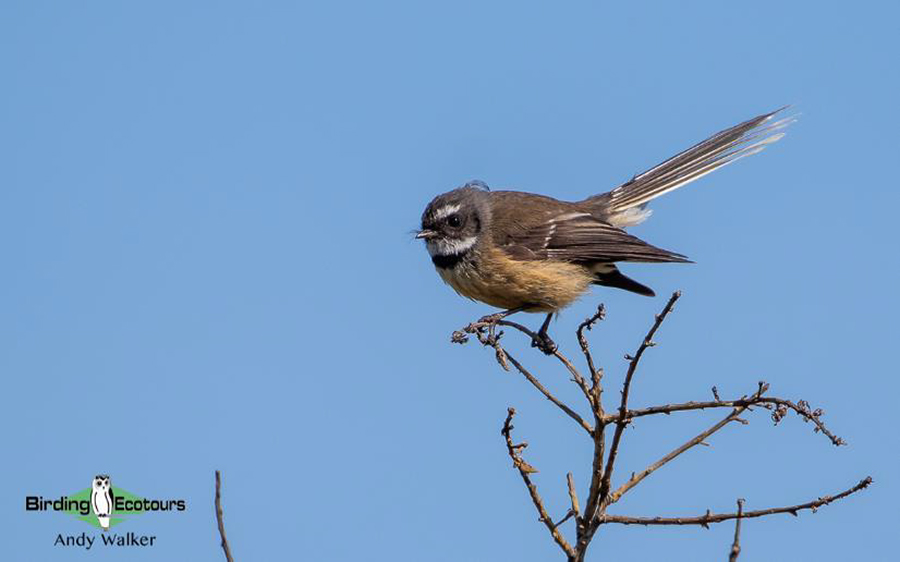
New Zealand Fantail is a common endemic but full of character and always a joy to watch. We had multiple opportunities throughout the tour to do as such.
After checking into our accommodation (to the sound of Pacific Long-tailed Cuckoo ) we enjoyed some local snacks and wine with Weka on the balcony, and then dinner, before the main event, and main reason we’d come to stay on the island, a nocturnal kiwi walk. After an informative and interesting talk on the species, we spent about an hour walking around the area near the lodge and eventually all enjoyed views of a Little Spotted Kiwi or two, a fascinating species as are all kiwis. We also found Morepork , Little Penguin , and Weka during our nighttime excursion.
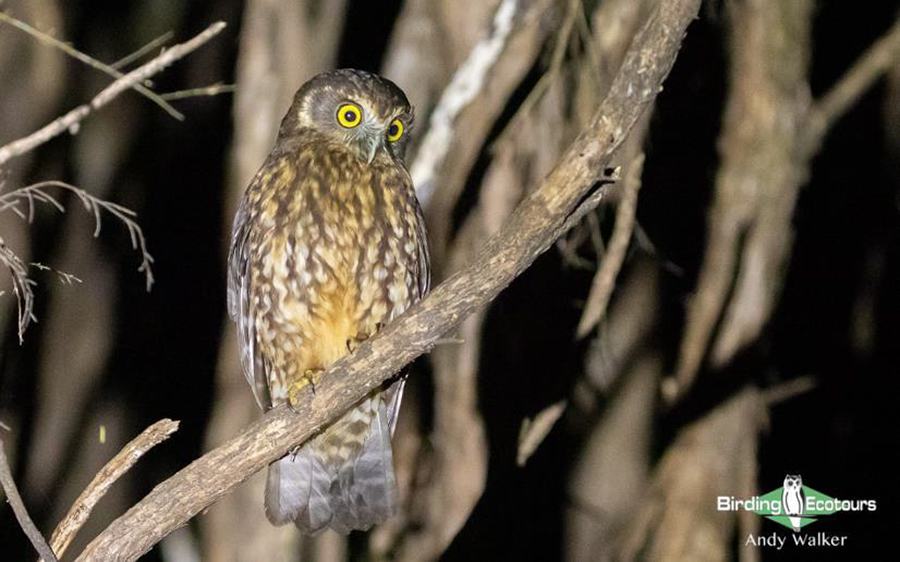
Morepork gave us some good views and was heard on many other occasions during the tour.
Day 7, 16 th October 2022. Kapiti Island to Wellington then ferry to Picton, South Island.
We awoke to a cold start, and all stood in the sun warming up and drinking tea/coffee as we scanned the nearby hills, where a New Zealand Falcon was on view on and off for over an hour. It was great that everyone could finally catch up on this bird. Most of the birds seen/heard the previous day were still present, including Weka , Pacific Long-tailed Cuckoo , Sacred Kingfisher , Tui , Red-crowned Parakeet , New Zealand Kaka , and New Zealand Fantail .
After a delicious breakfast we took the boat back to Paraparaumu (seeing Pacific Reef Heron along the way). Back into our bus we then continued on to Otaki Sewage Works, where we found Black-fronted Dotterel as well as several duck species and lots of hybrids too. Afterwards, we drove into Wellington, New Zealand’s capital city for lunch at, and an exploration of, Te Papa Tongarewa ( Museum of New Zealand ) before catching the ferry to Picton, South Island. During the ferry crossing we saw lots of Fluttering Shearwaters , along with our first Westland Petrels of the trip, with Shy (White-capped) Albatross , Buller’s Albatross , Fairy Prion , and Sooty Shearwater also seen.
Day 8, 17 th October 2022. Birding Marlborough Sound and Queen Charlotte Sound then travel to Kaikoura
We spent the morning cruising on a boat through Queen Charlotte Sound with a couple of major targets the main focus of our trip. As we left the marina, we were soon watching a pod of Dusky Dolphins , shortly after, as we commenced our journey proper, we were seeing lots of Fluttering Shearwaters , Australasian Gannets , White-fronted Tern , and both Kelp and Silver (Red-billed) Gulls . A rocky outcrop gave us great looks at our first main target of the day, New Zealand King Shag , one of the rarest shags in New Zealand. Here we also got our best looks so far at the attractive Spotted Shag as both stood side by side. We also enjoyed brief views of Little Penguin and prolonged views of New Zealand Fur Seal .
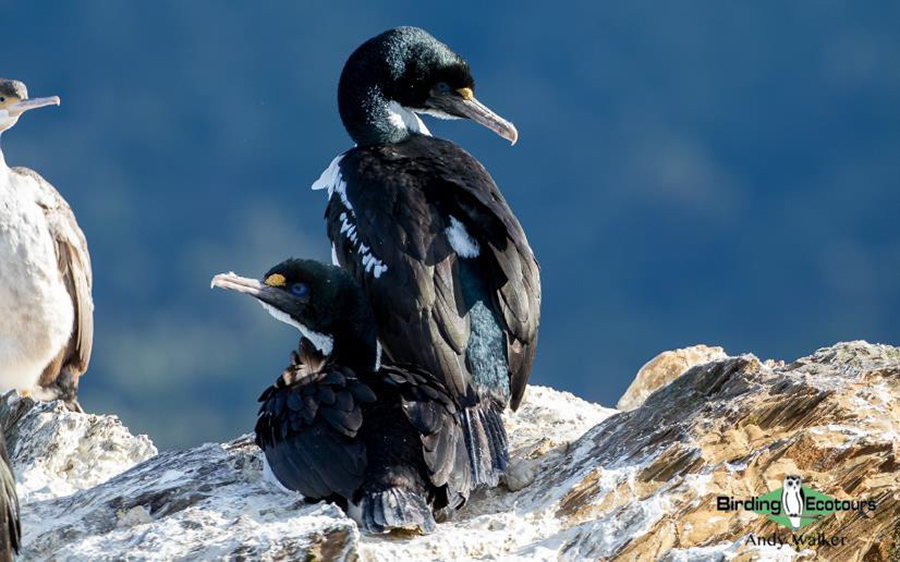
We enjoyed some close views of New Zealand King Shag while in Queen Charlotte Sound.
We made a wet landfall on Blumine Island, where we spent some time listening to, and looking at, a set of familiar birds and some new ones, the main target for us here was the Critically Endangered ( BirdLife International ) Malherbe’s Parakeet . We had a pair flying around as soon as we arrived, but it took longer to get the whole group to get good views of this rare parrot, but good views we did eventually get (see trip report cover image). South Island Saddleback was new for the trip, and we had a couple of very vocal birds. Tomtit was noted and we also saw New Zealand Bellbird , Tui , New Zealand Pigeon , and our best views so far of New Zealand Falcon .
After our morning on the water, it was time to drive south to Kaikoura, our base for the next two nights. We made a few stops along the way, one at a sewage works that gave us good views of a large flock of breeding plumaged Royal Spoonbills and a few other wildfowl species. Another stop at a small wetland gave us good views of Hoary-headed Grebe (uncommon recent natural colonizer in New Zealand), Great Crested Grebe , and Eurasian Coot . Driving along the coast into Kaikoura we stopped briefly at a New Zealand Fur Seal and Spotted Shag colony.
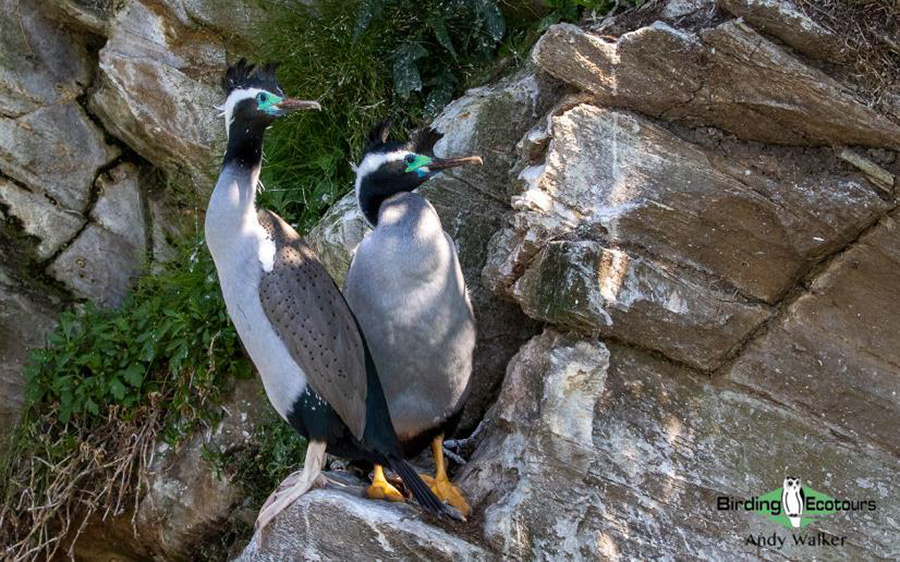
Spotted Shag is one seriously stunning bird when in breeding plumage.
Day 9, 18 th October 2022. Kaikoura Pelagic birding trip
We spent the morning on an enjoyable pelagic trip off Kaikoura where we enjoyed a great selection of mammals and seabirds. As we left the harbor, we picked up a shy Hector’s Dolphin and a few White-fronted Terns . Moving out to sea, we noted a large number of Hutton’s Shearwaters cruising past us, with the occasional Sooty Shearwater included. As we progressed, we could see some large birds in the distance and before long we were watching both Westland Petrels and Cape Petrels . As we put out the burley (chum) in came some birds, and included the huge duo of Antipodean Albatross and Southern Royal Albatross . Here too we got some action from Salvin’s Albatross and Northern Giant Petrel , large birds but dwarfed by the former species.
We changed our direction after a while, in doing so we then picked up some distant Sperm Whales that we watched for a while. After putting out some more burley (chum) we were again inundated with seabirds. Along with the Antipodean Albatrosses , Southern Royal Albatrosses , and Salvin’s Albatrosses , we also now had several Shy (White-capped) Albatrosses in attendance and the numbers of Northern Giant Petrels was also increasing. A steady stream of Cape Petrels and Westland Petrels were coming in, along with a couple of Buller’s Shearwaters and Hutton’s Shearwaters . The views we were getting of all these birds was simply breathtaking as they sat off the back of the boat and squabbled over the food, a real tour highlight.
As we moved further out to sea we were suddenly upon a pod of Killer Whales (Orcas), we followed them for a while and got some great views of this most-wanted mammal. We ended our pelagic by watching a pod of Dusky Dolphins and numerous New Zealand Fur Seals .

The humongous Southern Royal Albatross sat behind the boat and gave excellent views. This species has a wingspan of up to a whopping 142 inches (3.6 meters)!
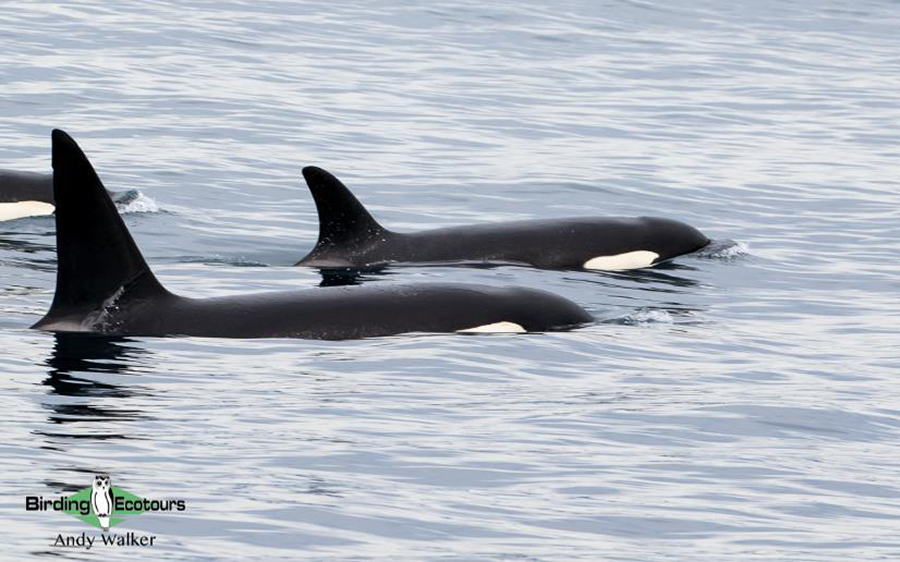
A large pod of Killer Whales (Orcas) provided another highlight of our morning on the sea off Kaikoura.
After our most enjoyable time on the sea, we came back to land for lunch. Some of the group took a hike around the headland during the afternoon, noting several species and some impressive scenery, and others took the opportunity to catch up on some rest and laundry!
Day 10, 19 th October 2022. Kaikoura to Punakaiki via Arthur’s Pass
We had a long travel day today to get between Kaikoura on the east coast of South Island to Punakaiki on the west coast of South Island. We first drove south towards Christchurch where we stopped at Ashley River Estuary, here we found the Critically Endangered ( BirdLife International ) Black Stilt , one of the rarest shorebirds in the world, with an estimated population of 38-50 birds, and our first Black-fronted Terns of the trip. Plenty of other birds were present here too, including Wrybill , Double-banded Plover , Caspian Tern , White-fronted Tern , Royal Spoonbill , and Black-billed Gull . A couple of other roadside stops gave us a mix of common birds we’d previously seen, but that were still appreciated, including Yellowhammer and New Zealand Fantail .
Driving through Arthur’s Pass National Park we made a couple of stops to admire the impressive scenery as well as for some short birding sessions, one such stop produced the highly anticipated Rifleman (another “bird of the trip” possibility?), a tiny bird with a high-pitched call, along with our first Kea , Pipipi (New Zealand Brown Creeper) and South Island Robin of the tour.

Rifleman , New Zealand’s smallest bird gave an excellent showing. The opposite end of the size spectrum to the Southern Royal Albatrosses we had been watching the previous day, this one is only 2.8 inches (7 centimeters) long and is an energetic ball of feathers!
We arrived at Punakaiki in the late afternoon. We checked into our hotel and had dinner before going out at night for a walk into the nearby hills where we got to witness the impressive sight (and sound) of several Westland Petrels returning to their nest burrows to feed their chicks, a fun experience indeed. We also heard the haunting calls of Pacific Long-tailed Cuckoo and Weka .
Day 11, 20 th October 2022. Punakaiki to Franz Josef via Okarito Lagoon
We had a relaxed day with a later start after our previous nighttime excursion, travelling south down the west coast of South Island. We called in to check out the famous and impressive “pancake rocks” at Punakaiki as they were so close to our accommodation, here we enjoyed the natural landscape and some breeding White-fronted Terns . We then called in at Hokitika to take a look around the famous town and enjoyed a picnic lunch on the beach.
During the afternoon we visited Okarito Lagoon where we saw our first New Zealand Fernbird of the tour. We’d heard one earlier on the tour, but it was a rather windy day so little chance of seeing that one, today we found a sheltered spot and enjoyed great views of a pair. Here we also got our first and only Great Egrets of the tour (at the only location the species breeds in New Zealand), as well as several endemic bush birds, such as Tomtit , Tui , New Zealand Bellbird , New Zealand Fantail (including an interesting black morph bird), and Grey Gerygone .
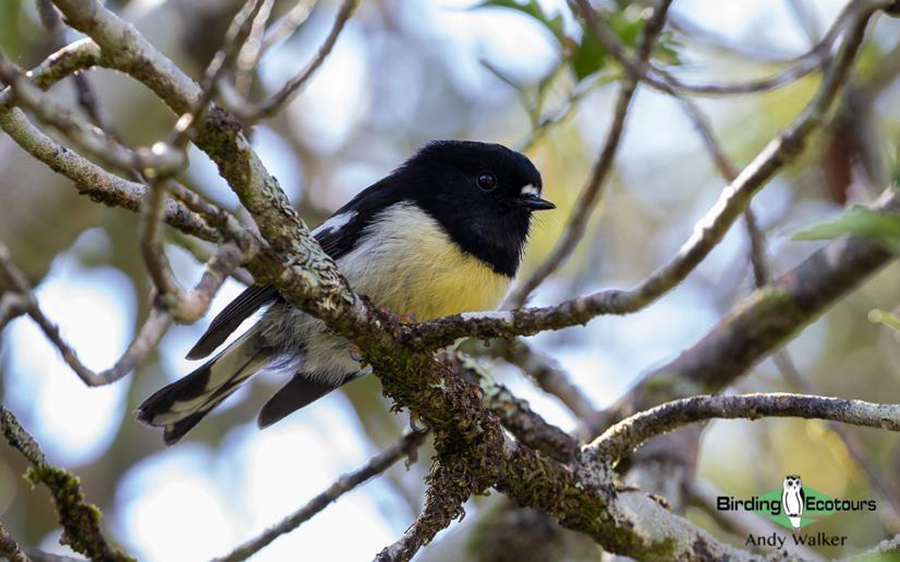
Some of the group got some excellent views of male Tomtit . The birds on South Island have orange/yellow on their breast, whereas those on North Island are white below.
In the evening we took a walk near Okarito Lagoon where we heard Okarito Kiwi , but they were too far into the bush to get to for views. We also heard Morepork and Pacific Long-tailed Cuckoo during our birding session.
Day 12, 21 st October 2022. Franz Josef to Twizel via Haast Pass
A long day as we traveled from Franz Josef to Twizel. It was a long but spectacular journey through some staggering scenery. We took the route through Haast Pass and in doing so connected with the endemic Yellowhead during a brief tea/coffee/cake stop! Here we also got more looks at Rifleman as well as other more widespread endemics.
In the afternoon, after saying goodbye (and a huge thank you) to Richard, who had got prior eBird New Zealand Bird Atlas commitments, we called in at the Tasman Delta near Twizel. Here we got some good views of Black Stilt , closer than our earlier sighting and we also got to see Wrybill , Double-banded Plover , South Island Oystercatcher , and Black-fronted Tern all on their braided river breeding grounds and all set in front of spectacular snow-covered Mt Cook.
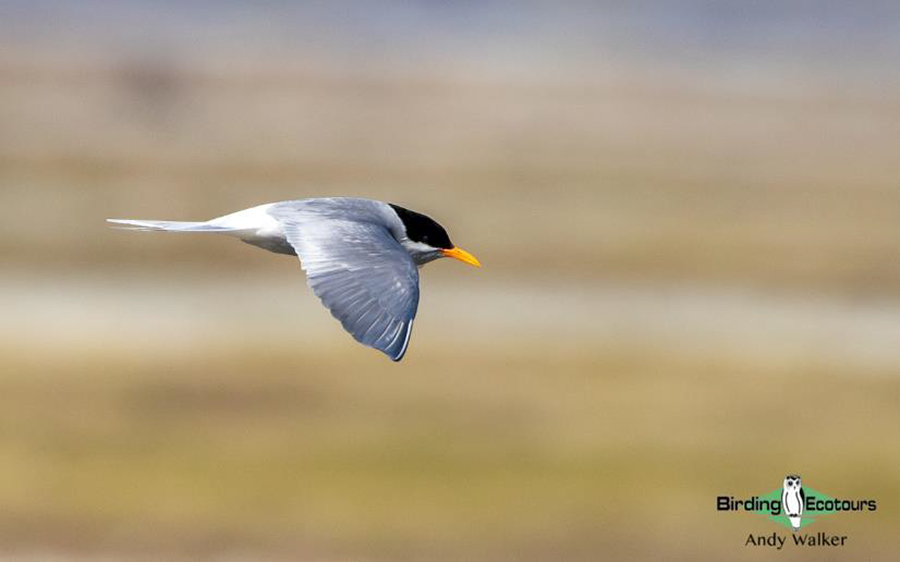
The endemic and attractive Black-fronted Tern was a popular bird with the group.
Day 13, 22 nd October 2022. Twizel to Dunedin and Otago harbor cruise
We awoke to a very cold and frosty morning in Twizel. After breakfast we commenced our journey south to Dunedin. We called in at a lake near the town where we saw more waterbirds we’d seen earlier in the tour, such as Great Crested Grebe (these ones displaying though), New Zealand Scaup , and Black Swan .
Once we reached the coast we called in to the harbor at Oamaru where there was a huge Otago Shag colony. We noted the differences between the different color morphs of this localized species as well as the smaller Spotted Shags that were around the periphery of the colony. A mix of introduced finches proved an attractive distraction with Common Redpoll , European Goldfinch , European Greenfinch , and Common Chaffinch all giving good looks.
Once we arrived in Dunedin, we continued to the tip of the Otago Peninsula. Here we joined a harbor cruise around Taiaroa Head where we soaked in the amazing sight of mainland breeding Northern Royal Albatrosses . The birds were up and down off their nesting area frequently giving close flight views, as well as sitting on the water off the boat undertaking their courtship and pair-bonding displays. Other species noted on the cruise included Otago Shag , Spotted Shag , Little Penguin , Sooty Shearwater, Royal Spoonbill , and New Zealand Sea Lion .
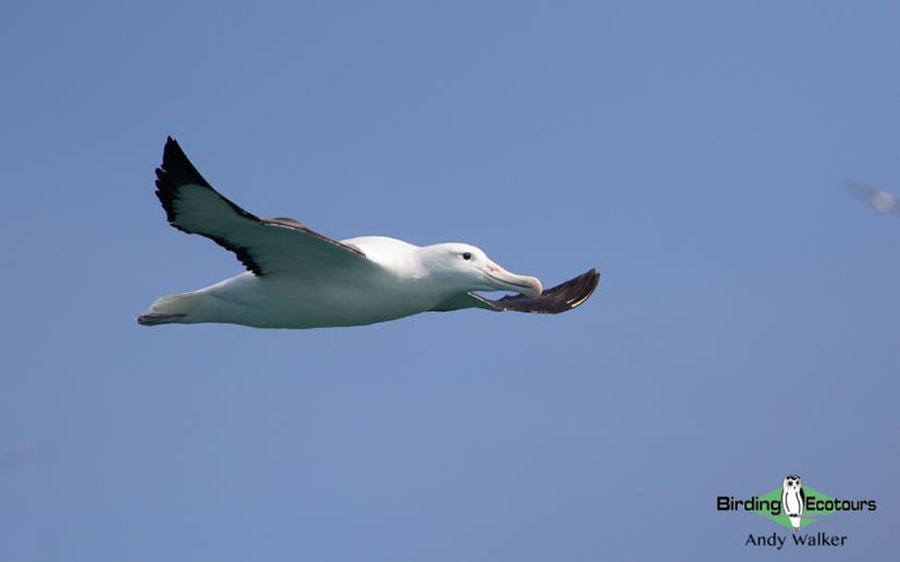
We were thrilled to watch the massive Northern Royal Albatrosses around their breeding colony on the Otago Peninsula at Taiaroa Head.
Day 14, 23 rd October 2022. Birding the south coast of South Island and travel to Oban, Stewart Island (Rakiura)
We spent the day driving from Dunedin down to Bluff on the southern tip of South Island and from Bluff we caught the fast ferry across to Oban on Stewart Island (Rakiura). Our first birding stop was at Nugget Point where we walked out to the lighthouse. In doing so we saw our first Shining Bronze Cuckoo of the trip (after hearing a few before now) and we also enjoyed our best view of the tour of New Zealand Falcon , with a hunting bird flying low below and then above us. Other interest was provided by a mix of native and introduced species, as well as the impressive coastal views. Moving on we called in to a beautiful bay for lunch where we saw New Zealand Sea Lion , and Greylag Goose (not quite as impressive!).
Continuing our journey during the afternoon we briefly had time to call into a wetland where a quick look gave us several shorebirds ( Bar-tailed Godwit , South Island Oystercatcher , and Pied Stilt ) and a range of wildfowl, such as Black Swan , Paradise Shelduck , New Zealand Scaup , Australasian Shoveler , and Grey Teal . In the late afternoon we took the ferry across to Stewart Island (Rakiura). Those braving the spray were rewarded with sightings of Fiordland Penguin , Foveaux Shag , Common Diving Petrel , and Salvin’s Albatross .
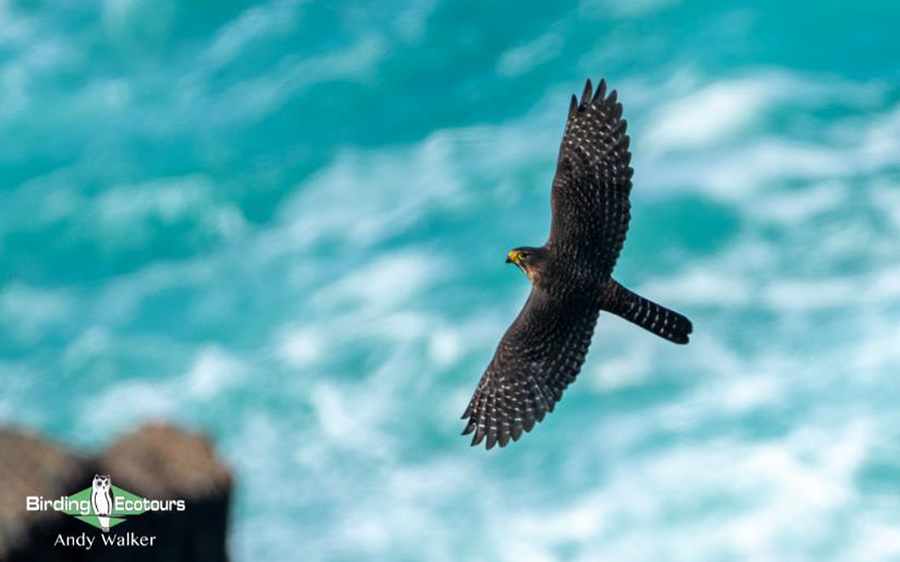
Trying to keep up with the fast-moving hunting New Zealand Falcon was tough!
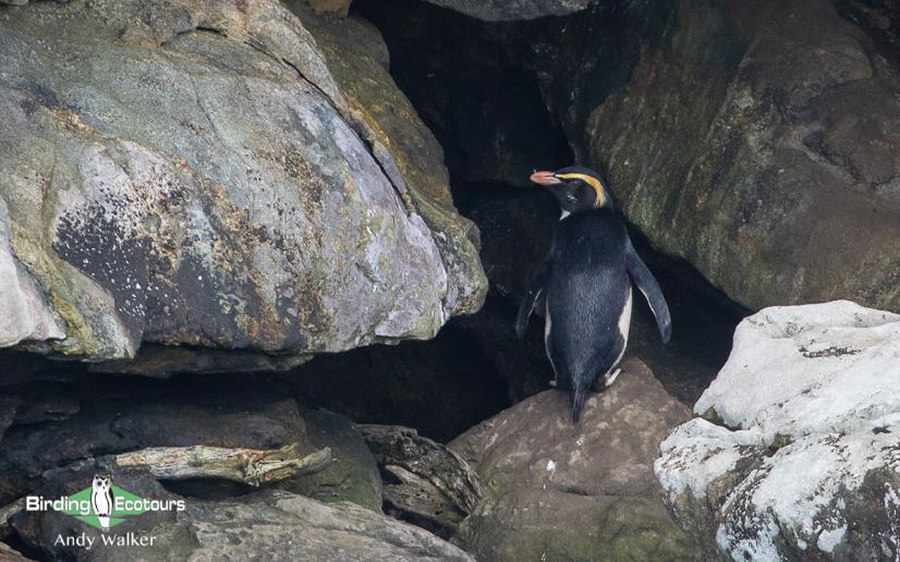
We had several Fiordland Penguin sightings during our time at and around Stewart Island (Rakiura) and later in the tour at Milford Sound too.
Day 15, 24 th October 2022. Stewart Island (Rakiura) Pelagic trip and birding Ulva Island
We awoke to a rather damp and dull morning after a heavy rainstorm during the early hours, which was still lingering while we were having breakfast. This poor weather would stay with us for most of the morning, but it didn’t really impact us too much, thankfully.
We met our pelagic boat outside our hotel after breakfast and set out to explore some of the water and small islands off Stewart Island (Rakiura). Our first stop was not far out of the harbor where we saw Fiordland Penguin near to where we had seen them the previous evening, much better views for everyone this time. Moving out to sea we enjoyed a range of pelagic species, many of them giving great views as they came in to eat our burley (chum), such as Buller’s Albatross , Shy (White-capped) Albatross , Salvin’s Albatross , Northern Giant Petrel , Common Diving Petrel , Cook’s Petrel , Sooty Shearwater , and Fairy Prion . Checking out some of the smaller islets we found both Little Penguin and a major target, Yellow-eyed Penguin . We also visited a Foveaux Shag colony and gained good views of many birds on their nests.

We were rather excited to see this Yellow-eyed Penguin during our boat trip.
After lunch on the boat, we got dropped off on pretty Ulva Island where we spent a few hours soaking in a range of endemic birds. Noisy New Zealand Kaka greeted us, along with Weka , New Zealand Fantail , and South Island Robin . As we quietly walked through the forested island, we picked up Red-crowned Parakeet , Yellow-crowned Parakeet , Tui , New Zealand Bellbird , and Grey Gerygone , as well as more Weka , New Zealand Kaka , and South Island Robins . A quick scan of a beach provided us with looks at Variable Oystercatcher , Kelp Gull , Weka , and Silver (Red-billed) Gull . Continuing our walk on the island we came across a family group of South Island Saddlebacks alarm calling at the presence of a New Zealand Kaka and a short while later we found a good mixed flock (bird wave) containing many of the aforementioned species, as well as Yellowhead , Pipipi (New Zealand Brown Creeper), and New Zealand Pigeon . A fitting end to another great day of birding in New Zealand… or was it…
An evening excursion after dinner resulted in everyone in the group getting multiple Southern Brown Kiwi sightings, including one bird that gave prolonged views, and possibly became a “bird of the Trip” contender.

South Island Saddleback very nearly became extinct after rats invaded the final three islands the species was clinging onto in the mid-1960’s. Luckily birds were translocated to predator-free island refuges where they were able to survive.
Day 16, 25 th October 2022. Stewart Island (Rakiura) to Te Anau
A relaxed day as we travelled between Oban on Stewart Island (Rakiura) to Bluff on South Island, before driving west along the picturesque coast, then north into some equally spectacular scenery to Te Anau, on the edge of Fiordland National Park. The sea crossing was flat and as a result seabirds were hard to come by, though Buller’s Albatross , Shy (White-capped) Albatross , Brown Skua , Cape Petrel , Sooty Shearwater , and Common Diving Petrel were all recorded.
Once back on South Island we called in at a few wetland sites where we picked up many of the birds we had seen before on the tour, such as Paradise Shelduck , Australasian Shoveler , Great Cormorant , Bar-tailed Godwit , South Island Oystercatcher , and Ruddy Turnstone , etc.
We called into a very pretty coastal bay for lunch, where we had a constant stream of Sooty Shearwaters passing by, along with Northern Giant Petrel , Australasian Gannet , White-fronted Tern , Spotted Shag , and Foveaux Shag . On arrival at Te Anau, some of the group opted to walk along the lake shore and do some gift shopping, while others visited the nearby Te Anau Caves for a glowworm tour!
Day 17, 26 th October 2022. Birding Milford Sound and Homer Tunnel
Departing Te Anau after breakfast we first called in at a lakeside viewpoint where we watched some New Zealand Scaup foraging as well as a pair of New Zealand Fantails and a vocal South Island Robin .
Moving on to a woodland patch, we commenced a loop walk through some spectacular mossy forest. Along the walk we enjoyed seeing several Rifleman as well as more showy New Zealand Fantails , South Island Robins , New Zealand Kaka , and a few other native birds. Weather conditions were not ideal for birding with a very strong wind and increasing rainfall, but we still made the most of our time and certainly weren’t going to complain after the wonderful weather we had enjoyed for most of the tour.
Gaining some elevation we came across our first Kea for the day, and shortly later another few materialized and we enjoyed watching this comical alpine endemic parrot, as we tried to prevent them destroying our vehicle. Needless to say, we had our best views of this species of the tour here!

We were visited by a few mischievous Kea during our time birding around the Milford Sound area, which was a real treat, they are fascinating birds.
After a picnic lunch in the bus sheltering from the rain, we started walking around some boulder fields near Homer Tunnel – a formidable and impressive landscape, as much of the area is here. In no time at all we were watching a pair of the fantastic New Zealand Rockwren . We didn’t really care that it was cold and raining because this was one of the top endemic targets for many on the trip and we were very pleased to get such good views in limited time of what can be a tricky bird to connect with at times.
After a warming cup of tea, coffee, or hot chocolate, and a snack, the group set out on a boat trip on Milford Sound where Fiordland Penguin was the pick of the birds seen in some spectacular glacial scenery. Some of the group also saw the Critically Endangered (IUCN) Fiordland subpopulation of Common Bottlenose Dolphin .

The endemic New Zealand Rockwren performed excellently for us in the cold rain.
Day 18, 27 th October 2022. Te Anau to Dunedin where tour concluded
We left Te Anau after breakfast and made the drive back to Dunedin airport, where this thoroughly enjoyable tour concluded. There was lots of discussion about “bird of the trip” along the journey and Southern Brown Kiwi was voted “bird of the trip”, but had close competition from many other species, such as Little Spotted Kiwi , Stitchbird , Weka , Fluttering Shearwater , Little Penguin , Yellow-eyed Penguin , Yellowhead , New Zealand Fantail , New Zealand Falcon , and New Zealand Rockwren .
We must offer up a huge thank you to Mark who guided the tour throughout (and who carefully drove us around the islands) and to Richard, who was along for most of the tour too. It was a pleasure birding and traveling with you both and we learnt so much about the birds, wildlife, landscape, geology, habitats, and flora of New Zealand, and had a great laugh along the way too. From pelagic boat trips, predator-free small-island visits, nighttime kiwi walks, stunning snow-capped mountains, braided river valleys, and mossy forests we covered a lot of ground through this beautiful country. I look forward to traveling with you on our next New Zealand birding tour .
A huge thank you to everyone in the group too, for contributing to making the tour a great success, I look forward to traveling with you all again soon, hope to see you in Borneo , Thailand , PNG , or Bali soon!
Bird List – Following IOC (12.2)
The following notation after species names is used to show conservation status following BirdLife International : CR = Critically Endangered, EN = Endangered, VU = Vulnerable. The common name for New Zealand endemics is shown in bold type, e.g., Southern Brown Kiwi .
Mammal List
Reptile list, amphibians list, notable other taxa list.
This is a sample trip report. Please email us ( [email protected] ) for more trip reports from this destination.
This is a fantastic tour. The birds, scenery, mammals, other wildlife, pelagic tours, lodging, and food were all beyond compare. The guides were extraordinary in their knowledge and consideration. I highly recommend this tour for all bird and nature lovers. Andy is wonderful. His consideration and kindness were above and beyond. He is very knowledgeable, and he ensured that I enjoyed the best possible views of the birds and the other wildlife as well. His patience and good humor made this the most pleasant trip.
All Rights Reserved, Birding Ecotours
Join our newsletter for exclusive discounts and great birding information!
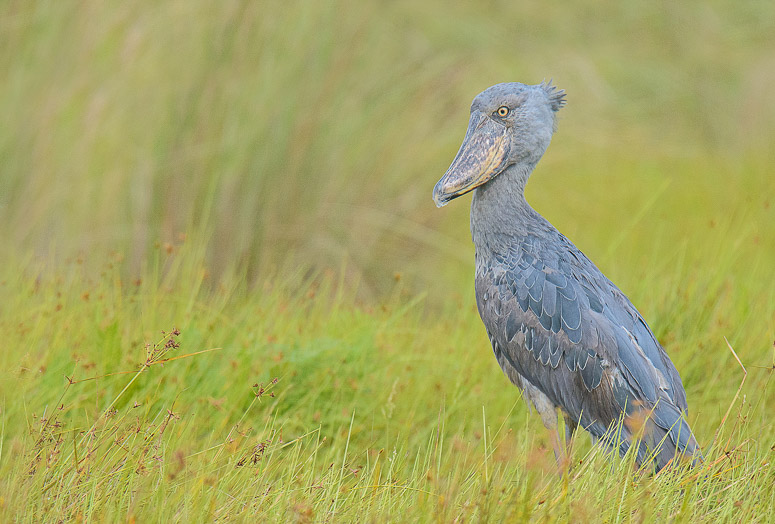

- Ascension Island
- Tristan da Cunha
- Burkina Faso
- Central African Republic
- Congo Republic
- Côte d’Ivoire
- Equatorial Guinea
- Eswatini (Swaziland)
- Guinea Bissau
- North Sudan
- São Tomé & Príncipe
- Sierra Leone
- Eastern Cape
- KwaZulu Natal
- Northern Cape
- Northwest Province
- Western Cape
- South Sudan
- Western Sahara
- Afghanistan
- British Indian Ocean Territory
- Heilongjiang
- Inner Mongolia
- Andaman & Nicobar Islands
- Andhra Pradesh
- Arunachal Pradesh
- Chhattisgarh
- Himachal Pradesh
- Jammu & Kashmir
- Lakshadweep
- Madhya Pradesh
- Maharashtra
- Uttar Pradesh
- Uttarakhand
- West Bengal
- Indonesian Borneo
- Lesser Sundas
- Kuala Lumpur
- Peninsular Malaysia
- Sarawak & Sabah
- North Korea
- Philippines
- South Korea
- Timor-Leste
- Turkmenistan
- American Samoa
- Christmas Island
- Coral Sea Islands
- New South Wales
- Norfolk Island
- Northern Territory
- South Australia
- Western Australia
- Cocos Islands
- Cook Islands
- French Polynesia
- Marshall Islands
- New Caledonia
Stewart Island
- Northern Mariana Islands
- Papua New Guinea
- Wallis & Futuna
- Netherlands Antilles
- Antigua & Barbuda
- Caribbean Netherlands
- Cayman Islands
- Dominican Republic
- El Salvador
- Puerto Rico
- Saint Lucia
- St Vincent & Grenadines
- St. Kitts & Nevis
- Turks & Caicos
- South Ossetia
- Republic of Croatia
- Bosnia & Herzegovina
- Auvergne-Rhône-Alpes
- Bourgogne-Franche-Comté
- Hauts-de-France
- Île-de-France
- Nouvelle-Aquitaine
- Pays-de-la-Loire
- Provence-Alpes-Côte d’Azur
- Baden-Württemberg
- Brandenburg
- Lower Saxony
- Mecklenburg-Vorpommern
- North Rhine-Westphalia
- Rhineland Palatinate
- Saxony-Anhalt
- Schleswig-Holstein
- Liechtenstein
- Lake Skadar
- Netherlands
- Central Russia
- Eastern Siberia
- Northwest Russia
- Russian Arctic
- Russian Far East
- South Russia
- Western Siberia
- Basque Country
- Fuerteventura
- Gran Canaria
- Castilla y Leon
- Castilla-La Mancha
- Extremadura
- Switzerland
- Avon & Bristol
- Bedfordshire
- Buckinghamshire
- Cambridgeshire & Peterborough
- Gloucestershire
- Greater London
- Greater Manchester
- Herefordshire
- Hertfordshire
- Isle of Wight
- Isles of Scilly
- Leicestershire & Rutland
- Lincolnshire
- Northamptonshire
- Northumberland
- Nottinghamshire
- Oxfordshire
- Staffordshire
- Warwickshire
- West Midlands
- Worcestershire
- Yorkshire – East
- Yorkshire – North
- Yorkshire – South
- Yorkshire – West
- Isle of Man
- Angus & Dundee
- Clyde Islands
- Dumfries & Galloway
- Isle of May
- Moray & Nairn
- North-east Scotland
- Orkney Isles
- Outer Hebrides
- Perth & Kinross
- Upper Forth
- Brecknockshire
- Caernarfonshire
- Carmarthenshire
- Denbighshire
- East Glamorgan
- Meirionnydd
- Montgomeryshire
- Pembrokeshire
- Radnorshire
- Vatican City
- Vancouver Island
- New Brunswick
- Newfoundland
- Northwest Territories
- Prince Edward Island
- Saskatchewan
- Aguascalientes
- Baja California
- Baja California Sur
- Mexico City
- Quintana Roo
- San Luis Potosí
- St Pierre & Miquelon
- Connecticut
- Massachusetts
- Mississippi
- New Hampshire
- North Carolina
- North Dakota
- Pennsylvania
- Rhode Island
- South Carolina
- South Dakota
- Rio Grande Valley
- West Virginia
- Buenos Aires City
- Buenos Aires State
- Santiago del Estero
- Tierra del Fuego
- Espírito Santo
- Federal District
- Mato Grosso
- Mato Grosso do Sul
- Minas Gerais
- Rio de Janeiro State
- Rio Grande do Norte
- Rio Grande do Sul
- Santa Catarina
- Easter Island
- Northern Ecuador
- French Guiana
- Saudi Arabia
- Farne Islands
- Birding Tour Companies
- Bird Fairs & Festivals
- Trip Report Repositories
- Weather & Tides
- Rarity Alerts
- Ornithological Journals
- Birding Magazines
- Websites with Mega-links
- Books for Birders
- Bird Book Publishers
- Software, DVDs, Recordings etc.
- Bird Writers
- Bird Art & Artists
- Digiscoping
- Photos, Photography & Photographers
- Webcams & Nestcams
- #12348 (no title)
- #11964 (no title)
- Bird Watching Books
- Bird Watching Telescopes
- Birdfeeders, Birdhouses etc
- Optics Retailers
- Optics Companies
- Outdoor Clothing for Birders
- Other Birding Equipment & Accessories
- Tripod Companies
- Banding or Ringing
- Study & Bird Behaviour
- Birders & Ornithologists
- Threatened & Extinct Species
- Conservation
- Ornithology Courses
- Identification
- Invasive Species
- Taxonomy & Bird Names
- Acanthisittidae – New Zealand Wrens
- Acanthizidae – Australasian Warblers
- Acrocephalidae – Reed & Brush Warblers Etc.
- Aegithalidae – Bush Tits
- Aegithinidae – Ioras
- Alaudidae – Larks
- Arcanatoridae – Dapple-throat & Allies
- Artamidae – Woodswallows, Butcherbirds & Currawongs
- Atrichornithidae – Scrub-birds
- Bernieridae – Malagasy Warblers
- Bombycillidae – Waxwings
- Buphagidae – Oxpeckers
- Calcariidae – Longspurs & Snow Buntings
- Callaeidae – Kokako & Saddlebacks
- Campephagidae – Cuckooshrikes, Cicadabirds, Trillers & Minivets
- Cardinalidae – Cardinals, Grosbeaks & Allies
- Certhiidae – Treecreepers
- Cettidae – Bush Warblers, Tesias & Allies
- Chaetopidae – Rockjumpers
- Chloropseidae – Leafbirds
- Cinclidae – Dippers
- Cisticolidae – Cisticolas, Prinia, Tailorbirds & Allies
- Climacteridae – Australasian Treecreepers
- Cnemophilidae – Satinbirds
- Coerebidae – Bananaquit
- Conopophagidae – Gnateaters
- Corcoracidae – Australian Mudnesters
- Corvidae – Crows, Jays, Magpies & Allies
- Cotingidae – Cotingas, Fruiteaters & Allies
- Dasyornithidae – Bristlebirds
- Dicaeidae – Flowerpeckers
- Dicruridae – Drongos
- Donacobiidae – Donacobius
- Dulidae – Palmchat
- Elachuridae – Spotted Wren-babbler
- Emberizidae – Buntings, New World Sparrows & Allies
- Erythroceridae – Yellow Flycatchers
- Estrildidae – Waxbills, Munias & Allies
- Eulacestomatidae – Ploughbill
- Eupetidae – Rail-Babbler
- Eurylaimidae – Broadbills
- Formicariidae – Antthrushes
- Fringillidae – Finches, Seedeaters, Euphonias & Allies
- Furnariidae – Ovenbirds
- Grallariidae – Antpittas
- Hirundinidae – Swallows & Martins
- Hyliotidae – Hyliotas
- Hylocitreidae – Yellow-flanked Whistler
- Hypocoliidae – Hypocolius
- Icteridae – Oropendolas, Orioles, Blackbirds & Allies
- Ifritidae – Blue-capped Ifrit
- Incertae Sedis – Uncertain Families
- Irenidae – Fairy-bluebirds
- Laniidae – Shrikes
- Leiothrichidae – Turdoides Babblers, Laughingthrushes, Barwings & Sibias
- Locustellidae – Grassbirds & Allies
- Machaerirhynchidae – Boatbills
- Macrosphenidae – Crombecs, Longbills & African Warblers
- Malaconotidae – Bushshrikes, Tchagras, Puffbacks & Boubous
- Maluridae – Australasian Wrens
- Melampittidae – Melampittas
- Melanocharitidae – Berrypeckers & Longbills
- Melanopareiidae – Crescent-chests
- Meliphagidae – Honeyeaters
- Menuridae – Lyrebirds
- Mimidae – Mockingbirds, Thrashers & Allies
- Mohoidae – O’os
- Mohouidae – Whitehead, Yellowhead & Brown Creeper
- Monarchidae – Monarchs, Paradise Flycatchers & Allies
- Motacillidae – Longclaws, Pipits & Wagtails
- Muscicapidae – Old World Flycatchers
- Nectariniidae – Sunbirds & Spiderhunters
- Neosittidae – Sitellas
- Nicatoridae – Nicators
- Notiomystidae – Stitchbird
- Oreoicidae – Australasian Bellbirds
- Oriolidae – Old World Orioles, Pitohuis & Figbirds
- Orthonychidae – Logrunners & Chowchilla
- Pachycephalidae – Whistlers & Allies
- Panuridae – Bearded Reedling
- Paradisaeidae – Birds-of-paradise
- Paramythiidae – Painted Berrypeckers
- Pardalotidae – Pardalotes
- Paridae – Tits & Chickadees
- Parulidae – New World Warblers
- Passeridae – Old World Sparrows
- Pellorneidae – Fulvettas, Ground Babblers & Allies
- Petroicidae – Australasian Robins
- Peucedramidae – Olive Warbler
- Philepittidae – Asities
- Phylloscopidae – Leaf Warblers & Allies
- Picathartidae – Rockfowl
- Pipridae – Manakins
- Pittidae – Pittas
- Pityriaseidae – Bristlehead
- Platysteiridae – Wattle-eyes & Batises
- Ploceidae – Weavers, Widowbirds & Allies
- Pnoepygidae – Wren-babblers
- Polioptilidae – Gnatcatchers
- Pomatostomidae – Australasian Babblers
- Prionopidae – Helmetshrikes
- Promeropidae – Sugarbirds
- Prunellidae – Accentors
- Psophodidae – Whipbirds, Jewel-babblers & Quail-thrushes
- Ptilogonatidae – Silky-flycatchers
- Ptilonorhynchidae – Bowerbirds & Catbirds
- Pycnonotidae – Bulbuls
- Regulidae – Goldcrests & Kinglets
- Remizidae – Penduline Tits
- Rhagologidae – Mottled Berryhunter
- Rhinocryptidae – Tapaculos
- Rhipiduridae – Fantails
- Sapayoidae -Sapayoa
- Scotocercidae – Streaked Scrub Warbler
- Sittidae – Nuthatches
- Stenostiridae – Fairy Flycatchers
- Sturnidae – Starlings, Mynas & Rhabdornis
- Sylviidae – Sylviid Babblers, Parrotbills & Fulvettas
- Tephrodornithidae – Woodshrikes & Allies
- Thamnophilidae – Antbirds
- Thraupidae – Tanagers & Allies
- Tichodromidae – Wallcreeper
- Timaliidae – Babblers
- Tityridae – Tityras, Becards & Allies
- Troglodytidae – Wrens
- Turdidae – Thrushes
- Tyrannidae – Tyrant Flycatchers
- Urocynchramidae – Przevalski’s Finch
- Vangidae – Vangas
- Viduidae – Indigobirds & Whydahs
- Vireonidae – Vireos, Greenlets & Shrike-babblers
- Zosteropidae – White-eyes, Yuhinas & Allies
- Accipitridae – Kites, Hawks & Eagles
- Aegothelidae – Owlet-nightjars
- Alcedinidae – Kingfishers
- Alcidae – Auks
- Anatidae – Swans, Geese & Ducks
- Anhimidae – Screamers
- Anhingidae – Darters
- Anseranatidae – Magpie Goose
- Apodidae – Swifts
- Apterygidae – Kiwis
- Aramidae – Limpkin
- Ardeidae – Herons, Egrets & Bitterns
- Balaenicipitidae – Shoebill
- Brachypteraciidae – Ground Rollers
- Bucconidae – Puffbirds
- Bucerotidae – Hornbills
- Bucorvidae – Ground Hornbills
- Burhinidae – Thick-knees & Stone Curlews
- Cacatuidae – Cockatoos
- Capitonidae – New World Barbets
- Caprimulgidae – Nightjars & Nighthawks
- Cariamidae – Seriemas
- Casuariidae – Cassowaries
- Cathartidae – New World Vultures
- Charadriidae – Plovers, Lapwings & Dotterels
- Chionidae – Sheathbill
- Ciconiidae – Storks
- Coliidae – Mousebirds
- Columbidae – Doves & Pigeons
- Coraciidae – Rollers
- Cracidae – Chachalacas, Curassows & Guans
- Cuculidae – Old World Cuckoos
- Diomedeidae – Albatrosses
- Dromadidae – Crab Plover
- Dromaiidae – Emu
- Eurypygidae – Sunbittern
- Falconidae – Falcons, Kestrels & Caracaras
- Fregatidae – Frigatebirds
- Galbulidae – Jacamars
- Gaviidae – Divers or Loons
- Glareolidae – Coursers & Pratincoles
- Gruidae – Cranes
- Haematopodidae – Oystercatchers
- Heliornithidae – Finfoots & Sungrebe
- Hemiprocnidae – Treeswifts
- Hydrobatidae – Northern Storm Petrels
- Ibidorhynchidae – Ibisbill
- Indicatoridae – Honeyguides
- Jacanidae – Jacanas
- Laridae – Gulls, Terns & Skimmers
- Leptosomatidae – Cuckoo Roller
- Lybiidae – African Barbets
- Megalimidae – Asian Barbets
- Megapodiidae – Megapodes
- Meropidae – Bee-eaters
- Mesitornithidae – Mesites
- Momotidae – Motmots
- Musophagidae – Turacos, Plantain-eaters & Go-away-birds
- Numididae – Guineafowl
- Nyctibiidae – Potoos
- Oceanitidae – Austral Storm Petrels
- Odontophoridae – New World Quails
- Opisthocomidae – Hoatzin
- Otididae – Bustards, Floricans & Korhaans
- Pandionidae – Ospreys
- Pedionomidae – Plains Wanderer
- Pelecanidae – Pelicans
- Pelecanoididae – Diving Petrels
- Phaethontidae – Tropicbirds
- Phalacrocoracidae – Cormorants & Shags
- Phasianidae – Pheasants, Grouse, Partridges & Allies
- Phoenicopteridae – Flamingos
- Phoeniculidae – Wood Hoopoes & Scimitarbills
- Picidae – Woodpeckers
- Pluvianellidae – Magellanic Plover
- Pluvianidae – Egyptian Plover
- Podargidae – Frogmouths
- Podicipedidae – Grebes
- Procellariidae – Petrels, Diving Petrels & Shearwaters
- Psittacidae – African & New World Parrots
- Psittaculidae – Old World Parrots
- Psophiidae – Trumpeters
- Pteroclidae – Sandgrouse
- Rallidae – Rails, Crakes, Gallinules & Coots etc.
- Ramphastidae – Aracari, Toucans & Toucanets
- Recurvirostridae – Avocets & Stilts
- Rheidae – Rheas
- Rhynochetidae – Kagu
- Rostratulidae – Painted Snipe
- Sagittariidae – Secretarybird
- Sarothruridae – Flufftails
- Scolopacidae – Woodcock, Snipe, Sandpipers & Allies
- Scopidae – Hammerkop
- Semnornithidae – Toucan Barbets
- Spheniscidae – Penguins
- Steatornithidae – Oilbird
- Stercorariidae – Skuas or Jaegers
- Strigidae – Owls
- Strigopidae – New Zealand Parrots
- Struthionidae – Ostriches
- Sulidae – Gannets & Boobies
- Thinocoridae – Seedsnipe
- Threskiornithidae – Ibises & Spoonbills
- Tinamidae – Tinamous
- Todidae – Todies
- Trochilidae – Hummingbirds
- Trogonidae – Trogons & Quetzals
- Turnicidae – Buttonquails
- Tytonidae – Barn & Grass Owls
- Upupidae – Hoopoes
- Big Days & Bird Races
- Apocryphal Birding Stories & Urban Myths
- Bird Humour
- Listing & Listers
- Twitching & Twitchers
- Hints & Tips
- Angling & Birds
- Gardening For Birders
- Birding Blogs
- Accessible Birding
- Birding Organisations
- Birds on Stamps
- Fatbirder’s Birding Advice
New Zealand

New Zealand is an island country in the southwestern Pacific Ocean. The country geographically comprises two main landmasses—the North Island and the South Island and around 600 smaller islands of which the five largest inhabited islands are Stewart Island, Chatham Island, Great Barrier Island, d’Urville Island and Waiheke Island. New Zealand is situated some 1,500 kilometres east of Australia across the Tasman Sea and roughly 1,000 kilometres south of the Pacific island areas of New Caledonia, Fiji, and Tonga. Because of its remoteness, it was one of the last lands to be settled by humans. During its long period of isolation, New Zealand developed a distinct biodiversity of animal, fungal and plant life. The country’s varied topography and its sharp mountain peaks, such as the Southern Alps, owe much to the tectonic uplift of land and volcanic eruptions.
New Zealand is long and narrow, over 1,600 kilometres along its north-north-east axis with a maximum width of 400 kilometres with about 5.2 million people. 15,000 km of coastline and a total land area of 268,000 square kilometres. Slightly bigger than the UK, but with less than 10% of its population, it is still rural and uncrowded. Because of its far-flung outlying islands and long coastline, the country has extensive marine resources. Its exclusive economic zone is one of the largest in the world, covering more than 15 times its land area. New Zealand has a population of about New Zealand’s capital city is Wellington, while its most populous city is Auckland.
New Zealand’s climate is predominantly temperate maritime with mean annual temperatures ranging from 10 °C in the south to 16 °C in the north. Historical maxima and minima are 42.4 °C in Rangiora, Canterbury and -25.6 °C in Ranfurly, Otago. Conditions vary sharply across regions from extremely wet on the West Coast of the South Island to almost semi-arid in Central Otago and the Mackenzie Basin of inland Canterbury and subtropical in Northland. The southern and south-western parts of the South Island have a cooler and cloudier climate, with around 1,400–1,600 hours; the northern and north-eastern parts of the South Island are the sunniest areas of the country and receive about 2,400–2,500 hours. The general snow season is early June until early October, though cold snaps can occur outside this season. Snowfall is common in the eastern and southern parts of the South Island and mountain areas across the country.
About 82% of New Zealand’s indigenous vascular plants are endemic, covering 1,944 species. The two main types of forest are those dominated by broadleaf trees with emergent podocarps, or by southern beech in cooler climates. The remaining vegetation types consist of grasslands, the majority of which are tussock.
Birding New Zealand
Marine mammals are abundant, with almost half the world’s cetaceans and large numbers of fur seals reported in New Zealand waters. Many seabirds breed in New Zealand, a third of them unique to the country. More penguin species are found in New Zealand than in any other country. New Zealand is the pelagic birding capital of the world. It also has around 80 endemic species of birds.
To appreciate bird watching in New Zealand one has to understand a little of New Zealand’s history. With the destruction of New Zealand’s lowland bush, dense jungle like forest, (which began with the arrival here of the Polynesians a thousand years ago and was accelerated by the arrival of Europeans a couple of hundred years ago), went a good many of New Zealand’s unique birds, such as the Moa and the Huia. Although New Zealand is still a heavily forested country in the remote and mountainous areas, these forests are infested with introduced animals such as pigs, goats, deer, rats, mustelids and the Australian brush tailed possum, which pose a real threat to New Zealand’s remaining endemic birds. Until recently, it was thought that the only way to preserve New Zealand’s unique bird life was to re-establish them on pest free offshore islands, which happened in a few places where invasive plants and animals were extirpated and native bush allowed to regenerate such as the tiny island of Tiritiri Matangi in Auckland bay. This idea has now been extended to create mainland islands within the vast conservation estate. Hopefully, this strategy will reverse the decline.
As the native birds declined, the ecological niches were being filled by birds that were introduced by British settlers such as Song Thrush, and a number of finches etc. The gaps have also been filled by the natural expansion of Australian species, birds such as the Spur-winged Plover, Black-fronted Dotterel and Welcome Swallow.
New Zealand has so few birds compared with, say, Australia, it would be good to be able to say that every one of them is valued. However, Common Mynas Acridotheres tristis introduced from India and Australian Magpies Gymnorhina tibicen from Australia are not easy to defend. Few New Zealanders even get to see a Kiwi, let alone a Kokako or Kakapo. In most of the settled areas one mostly sees birds introduced here from Europe in the nineteenth century, such as Blackbirds, Song Thrushes and Goldfinches or other introductions like Californian Quail along with a few hardy natives such as Tuis, Fantails, Sacred Kingfishers and New Zealand Pigeons.
However, New Zealand does have a very high percentage of endemic birds. More than eighty five percent of all taxa are endemic. It is just that they are a bit thin on the ground and therefore take some effort or guidance to see. To observe New Zealand`s endemic bird life one has to either visit the offshore islands or visit the vast conservation estate, information about which may be found on the Department of Conservation web site or the birding section of the New Zealand Birds web site.

A Flock of Endemic Wrybill Anarhynchus frontalis – Pūkorokoro Miranda Naturalists’ Trust Reserve © Allan Sander
New Zealand’s rich marine environment provides for the abundance and diversity of its sea bird life. The New Zealand region extends from the subtropical waters around the Kermadec Islands to the sub-antarctic waters of the Campbell Plateau. Where the subtropical waters and sub-antarctic waters meet, the convergence, areas of upwelling are created where nutrients, fish and seabirds are abundant. One such area is along the Kaikōura coast.
Worldwide, there are 97 species of smaller petrels and of these 49 have been recorded in New Zealand seas. The strategic position of these islands, strung across the prevailing westerly winds, accounts for the many varieties of petrels found in this sector of the Pacific Ocean. The multitude of small islands scattered around New Zealand provide suitable nesting habitat for some, such as the 32 species of petrel which breed from the Kermadecs in the North to Campbell Island 2400 miles to the south. Other species such as the Blue Petrel visit New Zealand waters on a regular basis. Petrels breed once a year in large colonies on remote offshore islands. However, most of the main mountain ranges in New Zealand used to support extensive petrel colonies before the advent of man a thousand years ago and the mammalian predators they brought with them.
On still nights the southern oceans can twinkle with the tiny lights of phosphorescent zooplankton rafted in millions upon the water. Since many of these animals disappear during the day, most petrels feed at night. During the summer when the sun never sets, enormous blooms of the crustacean, Euphausia superba , attract vast concourses of sea birds to the cold polar seas. Not just petrels, but Shearwaters, Gulls, Terns, Skuas and even Albatross can often be seen close to shores, especially after storms at sea when they take to sheltered bays while the storms pass.
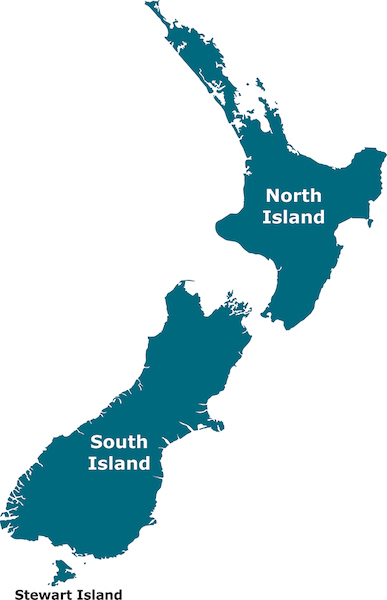
This page is sponsored by Wrybill Birding Tours

North Island - Firth of Thames North Island - Firth of Thames North Island - Firth of Thames Miranda reserve[Miranda]
North island - tiritiri matangi island, north island - zealandia, south island - eglington valley and milford sound, south island - haast pass, south island - kaikoura, south island - otago peninsula, narena olliver.
Duncan Poyser
Number of bird species: 396
Number of endemics: 97, avibase - bird checklists of the world, birds new zealand, wrybill tours.

A Checklist to New Zealand Birds
A field guide to the birds of new zealand, a naturalist's guide to the birds of new zealand, atlas of bird distribution in new zealand 1999-2004, birds of new zealand, birds of new zealand checklist, birds of new zealand: a photographic guide, birds of new zealand: locality guide, birdwatching in new zealand, buller's birds of new zealand, checklist of the birds of new zealand, collins field guide: birds of new zealand, hawaii, central and west pacific, field guide to new zealand seabirds, field guide to the birds of new zealand, flight of the huia, new zealand birds in pictures, photographic guide to birds of new zealand, the 50 best birdwatching sites in new zealand, the cuckoo and the warbler, the hand guide to the birds of new zealand, the reed field guide to new zealand birds, the story of new zealand's unique birds, new zealand birds online, massey - nz, new zealand rare birds committee, birds nz (ornithological society of new zealand), birds nz local branches, forest & bird, kakapo recovery project, kiwi conservation club, new zealand ecological society, pukaha-mount bruce national wildlife centre, rotoiti nature recovery project, save the kiwi, tiritiri matangi supporters, whangarei native bird recovery centre, wingspan - birds of prey trust, yellow-eyed penguin trust.
Abbreviations Key
**New Zealand's National Parks
*forest & bird reserves, cvp pureora forest park, ir blumine island, ir tiritiri matangi island, kiwi & birdlife park - queenstown, mir boundary stream, np te urewera, nr atawhai-whenua reserve, waiheke island, nr cape kidnappers gannet reserve, nr farewell spit, nr kapiti island, nr mana island, nr maungatautari restoration project, nr motunau island, nr nga manu, nr nugget point, nr oamaru blue penguine colony, nr pekapeka wetland, nr pigeon island - wāwāhi waka, nr pukaha mt. bruce national wildlife centre, nr pukorokoro miranda shorebird centre, rp muriwai gannet colony, rp shakespear, rp tawharanui, wr orokonui ecosanctuary, wr pauatahanui, wr royal albatross centre, taiaroa head, wr willowbank, christchurch, ws brook waimarama sanctuary, ws bushy park, akaroa harbour cruises, aurora charters - stewart island, birding ecotours, elm wildlife tours, farewell spit eco-tours, foris eco-tours, gannet safaris, kapiti island nature tours, kiwi wildlife tours, monarch wildlife cruises, myths & legends eco-tours, nature quest new zealand, nature travel specialists, new zealand land and pelagic trips, ruggedy range, ulva's guided walks, waikanae estuary bird tours, white heron tours, wrybill birding tours, 2015 [11 november] - erik forsyth, 2016 [01 january] - david & amanda mason - australia & new zealand, 2016 [11 november] - dan lane & mark ayer, 2016 [11 november] - erik forsyth, 2017 [02 february] - erik forsyth, 2017 [11 november] - erik forsyth, 2017 [12 december] - erik forsyth, 2018 [01 january] - erik forsyth, 2019 [01 january] - karen worcester, 2019 [11 november] - andy walker, 2019 [11 november] - birding ecotours - andy walker, 2020 [03 march] - kari haataja, 2022 [10 october] - andrew walker, 2022 [10 october] - carlos sanchez, 2022 [12 december] - bill simpson, 2023 [03 march] - julien wright-ueada, 2023 [11 nopvember] - pat lueders, french pass beachfront villas, kakapo cottage - stewart island, stewart island lodge, te kauri birding lodge, te mata lodge - thames, wilderness lodge - lake moeraki & arthur's pass, birders totals, birds of christchurch and canterbury, brown teal recovery programme, new zealand birding directory, new zealand birds, new zealand birds' store & gift shop, penguins in new zealand, brent stephenson - b1rder, gallery - birds of new zealand, photographer - brent stephenson, photographer - neil fitzgerald, photographer - paul gibson.
Fatbirder - linking birders worldwide... Wildlife Travellers see our sister site: WAND
Search New Zealand Birds
Welcome to birding new zealand, what's so special about new zealand .
Aotearoa, the Maori name for New Zealand meaning the land of the long white cloud, is a 2,000-kilometer-long chain of islands set in the vastness of the Great Southern and Pacific Oceans is one of the world's unique birding destinations. Go to video introduction
From the elusive flightless bird the Kiwi, that New Zealanders take as their own identity symbol, to some of the rarest endangered species and world renowned bird recovery programs, a New Zealand birding holiday is played out against a 100% pure backdrop of breathtaking beauty. To see most, if not all New Zealand’s endemics it is necessary to travel through much of the main three islands (North, South and Stewart Islands). En route you’re visiting a variety of landscapes: estuaries, beaches, rocky headlands, wetlands, rivers, lakes, forests, mountains and offshore sanctuary islands close to the mainland. Key birding locations are sometimes a day’s journey apart.
New Zealand Birding operators
The New Zealand Birding Network is a group of operators located throughout New Zealand offering bird-watching orientated tours, excursions and accommodation. In addition to unique birds and fantastic scenery, New Zealand has a well-developed infrastructure, visitor facilities are up-to-date. It is a safe and easy place to travel with friendly people who welcome visitors and love showing-off their country. The Operator directory and map indicates where birding operators are located.
New Zealand's birds
Terrestrial birds.
New Zealand has special terrestrial birds including: three endemic bird families, kiwi (five species), NZ wattlebirds (kokako and saddleback) and NZ wrens (rifleman and rock wren); alpine and forest parrots (kea, kaka and kakariki); large flightless rails (weka); honeyeaters (the iridescent tui, NZ bellbird); precious forest species such as yellowhead, whitehead, brown creeper, NZ robin, NZ tomtit, long-tailed cuckoo, shining cuckoo; the curious wrybill plover; and the extremely rare and endangered black stilt and shore plover.
Pelagic Birds
New Zealand also has the most diverse seabird community in the world, with no fewer than 85 species (95 different taxa) breeding in the region which includes NZ’s Subantarctic islands, the Chathams Group and the Kermadec Islands. This seabird fauna includes 35 endemic species and 49 endemic taxa. In addition to the breeders, many other seabirds visit New Zealand waters throughout the year, birds that breed close to Antarctica or on other islands of the Great Southern Ocean and the tropical Pacific. In short, New Zealand is an international seabird hotspot!
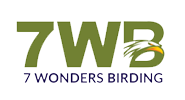
- Australasia
- North America
- South and Central America
- Bucket List Birding Pod Show-notes & links to all podcast episodes.
New Zealand's Endemic Bird Families, pelagic and maori culture.
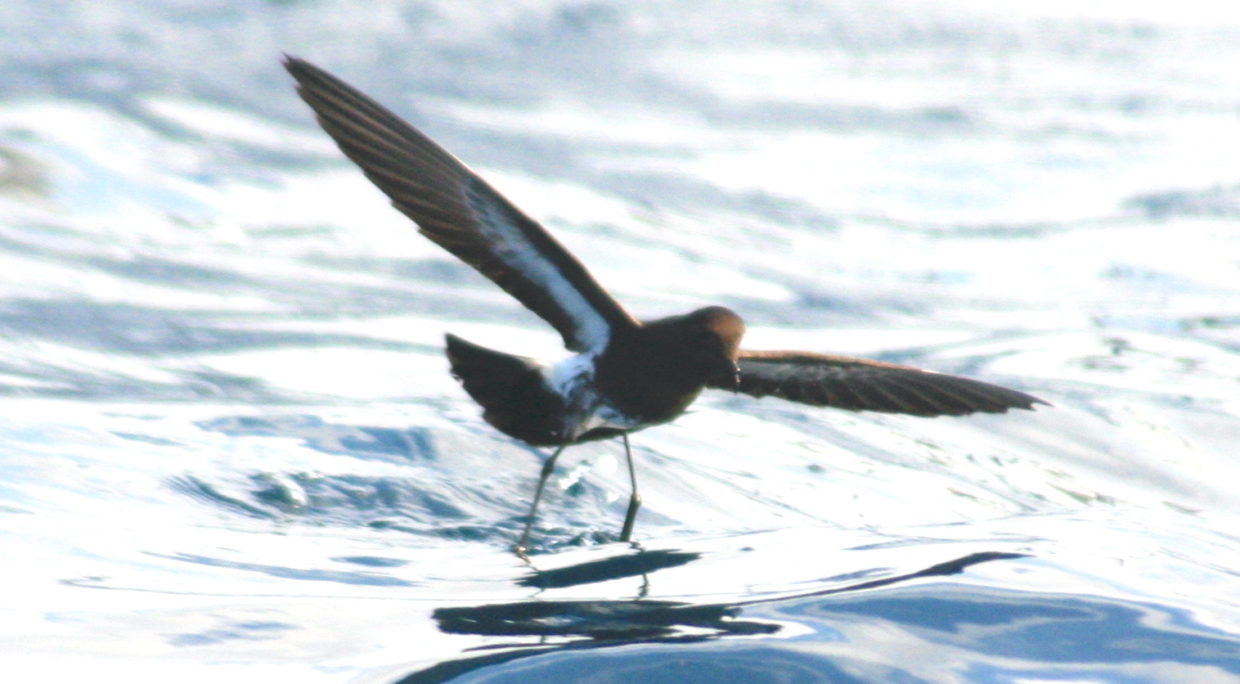
Jan 6-10, 2025 (extension South Island Jan 11-15, 2025).
Tour Price (Per Person):
USD: $2800. Group size 6-12. With driver and local guide at all time. Meals are included.
Quest for Endemic Bird Families. Easy birding, pelagic, endemic bird families and Maori Culture.
Description
New Zealand is a fascinating country with its Maori culture, scenic landscape of the Middle Earth in Lord of the Rings, a paradise for seabirds and pelagic fans, and a number of endemic bird families of truly unique birds, many of them threatened of extinction.
7 Wonders Birding offers two short trips that run back to back. The first part is on North Island and the second part on South Island. The focus of the two tours are a bit different. Both programs include a large amount of driving, but it is helped by the many hours of daylight in the Southern summer. This North Island Program focuses on these specific goals:
- See at least one representative of each of the six endemic bird family. They include Kiwis (North Island Brown and Little Spotted are possible), New Zealand Parrots (Kaka), New Zealand Wrens (Rifleman), Wattlebirds (Kokako and Saddleback), the Stitchbird and the new Mohouidae familiy (Whitehead).
- See recently rediscovered New Zealand Storm-Petrel on a top NZ pelagic
- See threatened and very local Shore Plover
- See the peculiar Wrybill
- See the torrent loving and threatened Blue Duck
- Get familiarized with the Maori culture .
All this in only 5 days. Lot’s of bang for the buck.
Although the birding is easy, it is quite an intense tour with long days. It could lay your base for a fast introduction to New Zealand and later you can explore on your own, or you may want to add the South Island program to maximize your time in New Zealand.
Many tours to New Zealand run in 21 days and cost over US$8000. In just 10 days we see 80-90% of the same birds at roughly half the price.
The South Island 5 day extension program is more focused on some iconic birds like the Kea and Black Stilt, the Kaikoura pelagic, and a visit to Stewart Island.
ITINERARY OUTLINE:
Day 1. Arrive Auckland in the morning. Visit Rangitoto Island, Waipu Cove and Tawharanui Regional Park. Night in Sandspit area.
Day 2. Pelagic. Night Tiritiri Matangi. Day 3. Tiritiri Matangi- Miranda-Pureora
Day 4. Pureora-Roturoa-Turangi
Day 5. Turangi-Wellington.
DETAILED ITINERARY:
Day 1. auckland-rangitoto island-waipu cove-tawharanui-sandspit., day 2. pelagic from sandspit. pm tiritiri matangi..
We start the morning with a pelagic. Within the littoral zone we shall see South Island Oystercatcher, Variable Oystercatcher, Silver Gull, Kelp Gull, Little Penguin, Pied Cormorant and White-faced Heron . Once in the open water and when chumming awaits New Zealand Storm-Petrel, which was thought to be extinct since 1850, but incredibly rediscovered in 2003. It remains a critically endangered species. Other pelagic birds that we have chance seeing today include Cook’s Petrel, Parkinson’s Petrel, Common Diving-Petrel, White-faced Storm-Petrel, Fairy Prion and Buller’s, Fluttering, and Little Shearwaters .
In the late afternoon we continue to Gulf Harbour for a water taxi to Tiritiri Matangi, where we shall stay overnight. The accommodation is basic and we need to bring a light sleeping bag and pillow. Here we have a chance of seeing Little Spotted Kiwi at night. We may also see Little Penguins near their burrows at night.
Day 3. Tiritiri Matangi. Drive to Miranda and Pureora.
We spend morning exploring the trails on the island. Tiritiri Matangi Island is one of New Zealand’s most important conservation projects. Between 1984 and 1994, volunteers planted around 300,000 trees on 220 ha island that formerly had been subject to farming for 120 years. A ll mammalian predators were eradicated and a number of threatened and endangered bird species have been introduced. The most threatened is the South Island Takahe – a giant flightless swamphen. There is a tiny wild population in the inaccessible Murchison Fiordland area, and introduced on four predator free islands which Tiritiri Matangi is one and the easiest to visit.
Other birds we hope to find this morning include Brown Quail, New Zealand Pigeon, Sacred Kingfisher, Red-crowned Parakeet, Tui, New Zealand Bellbird, Gray Gerygone, Whitehead, Australian Magpie, New Zealand Fantail, North Island Kokako, North Island Saddleback, Stitchbird, North Island Robin and with luck Rifleman . Five out of six endemic bird families!
At midday we take the water taxi back to the mainland to drive to Miranda on the shore of Firth the Thames bay. This is a top notch site for shorebirds including the peculiar Wrybill (bill is bent to the right) . Other wetland and shorebirds expected here in January are Black Swan, Paradise Shelduck, Gray Teal, Buff-banded Rail, Pied Stilt, South Island Oystercatcher, Variable Oystercatcher, Pacific Golden-Plover, Masked Lapwing, Red-breasted Dotterel, Greater Sand-Plover, Double-banded Plover, Bar-tailed Godwit, Ruddy Turnstone, Red Knot, Sharp-tailed Sandpiper, Curlew Sandpiper and Red-necked Stint.
After this we have a long drive to Black Fern Lodge at the edge of Pureora Forest Park. We shall look out for Kaka before the sun sets. Dinner included at the lodge.
Day 4. Pureora and Roturoa
Additional birding in the morning for Rifleman, North Island Robin, Tomtit and Kaka . There is also Blue Duc k possible here. We bird until 9 AM and then continue to Roturoa, which is the center of Maori culture. We shall visit a Maori Village and get an insight the life of the original inhabitants of New Zealand before the arrival of the white man. We shall also visit the boiling sulphur smelling mud pools of Wai-O-Tapu, and a good area for Tomtit , before going south again towards Turangi. We will search for Blue Duck the remainder of the evening. Sunset is at 8.40 pm, so there shall still be time for those who wish to do more birding.
Day 5. Drive to Wellington via Blue Duck location.
Depending what is left to see the morning’s birding will be decided. It is likely that one of three targets – the Blue Duck, Kaka or Rifleman is still missing.
Later we continue to Wellington and end the first part of the tour. Some people will fly back to Auckland in the afternoon while others continue to the South Island extension and the afternoon ferry across Cook’s Straight. Keen birders will look for seabirds while crossing such as Westland Petrel, Fairy Prion, White-capped Albatross, Sooty Shearwater, Fluttering Shearwater and White-faced Storm-Petrel . Night in Picton.
South Island Extension 5 days
If you want a complete experience of New Zealand we recommend our extension, which gives you the highlights of Black Stilt, Kea , the Kaikoura Pelagic, and birding and a pelagic on Stewart Island. Again there is a considerable amount of driving, but there are vast amount of daylight hours and thus the rewards are high.
The south extension can also be taken as a standalone trip by flying to Wellington and meet up with the group there.
Day 1 . We shall make a morning boat trip to a small colony of New Zealand King Shag, aka Rough-faced Shag which is one of the rarest cormorants on the planet. We shall also land on a small island where there is free living introduced population of the Critically Endangered Malherbe’s Parakeet, aka Orange-crowned Kakariki.
We drive to Kaikoura (2h) for an afternoon pelagic in these famous waters for albatrosses. No less than 5 species of albatross are seen here at close range. Northern Royal, Southern Royal , gibsoni ssp of Antipodean, White-capped and Salvin’s . Also here are Northern Giant Petrel, Cape Petrel, Grey-faced Petrel, White-chinned Petrel, Westland Petrel, Short-tailed Shearwater, Hutton´s Shearwater and Australasian Gannets .
After the pelagic we have a long drive on to Arthur’s pass (4.5 hours).
Day 2. In the morning we look for the confident parrot known as Kea – famous for destroying windshield wipers. We also search for New Zealand Rock Wren (or South Island Wren ) on the Otira Valley walk.
We leave after lunch to drive to Twizel which is another 4-5 hour drive.
Day 3. We search for the Critically Endangered Black Stilt and visit the visitor centre to learn more about this rare New Zealand shorebird.
Afterwards we travel to Invercargill and Bluff for the 5:15 Ferry to Stewart Island. At night we shall look for Southern Brown Kiwi .
Day 4 . In the morning we visit Ulva with Brown Creeper, Yellowhead, Red-fronted Parakeets, South Island Saddleback, South Island Robin and Weka . In the afternoon we shall make yet another pelagic trip. We shall add Brown Skua and White-chinned Petrel, Foveaux’s Shags, and Yellow-eyed Penguin .
Day 5. This day is somewhat flexible depending on what people want to do and their continued plans. If you have time to stay on for 4 PM flight to Christchurch, you can either take the morning ferry at 8 AM to try to twitch NZ Rock Wren if it is still missing, or take it easy on Stewart island and bird in the morning to take the ferry at noon.
From Christchurch there are flights to Auckland, Sydney and Melbourne.
Cost of the extension is US$2490
Subscribe to our newsletter
We respect your email privacy
New Zealand
- Lots of very special and unique birds and wildlife, including kiwis, penguins, parrots, superb seabirds, astonishing Tuis and Kokakos, and the bizarre shorebird, the Wrybill!
- Boat-trips to predator-free islands with numerous endemic birds
- World class pelagic trip off Kaikoura
- Pelagic cruise off Stewart Island
- Spectacular scenery from snow-capped mountains to rugged coastlines and volcanically active highlands!
- Visit several National Parks including Fjordlands, Mount Aspiring and Tongariro
Tour Overview
New Zealand – a land of remarkable and spectacular landscapes, from volcanoes and hotsprings to steep, deep fjords, snow-capped mountains and huge glaciers. The flora and fauna of these islands are equally remarkable and unique. Over 40 endemic bird species occur on the main islands, including quintessential New Zealanders – the Kiwis, those flightless, wingless, long-beaked ground-dwellers after which New Zealanders are named.
There are amazing birds here – New Zealand wrens and wattlebirds including the endangered Kokako, Saddlebacks and Stitchbirds, the world’s rarest penguin – Yellow-eyed, the inquisitive parrot the Kea, flightless Takahe, the scarce Blue Duck, the remarkable Wrybill – surely one of the strangest of shorebirds, the critically endangered Black Stilt, as well as diverse seabirds – albatrosses, shearwaters, storm-petrels, petrels. New Zealand is a land of ancient conifers, magnificent Kauri Pines so important in naval history, Southern Beech forests, magical rainforests of huge podocarps, splendid Tree Ferns, and fields of endemic sub-alpine shrubs and alpine flowers.
Our New Zealand birding tour takes in both North and South Islands, and offshore Stewart Island, each with its own special attractions and natural wonders, from rugged Fjordland National Park, Milford Sound and splendid Mount Cook in the south to the volcanically active central highlands, thermal geysers and primeval forests in the north.

Dates & Prices
Dates & prices, what's included, tour price includes.
- Three Kiwi excursions included (weather permitting)
- All accommodations (Moderate to good quality hotels and lodges)
- All meals included
- Ferry, cruise and pelagic boat trips included
- Ground transportation
- Guides: 4 - 7 participants with one guide and vehicle, 8 - 12 with two guides and vehicles
Tour Price Does Not Include
- Travel to and from start/end location
- Travel Insurance
- Items of a personal nature
- Optional Pre-tour
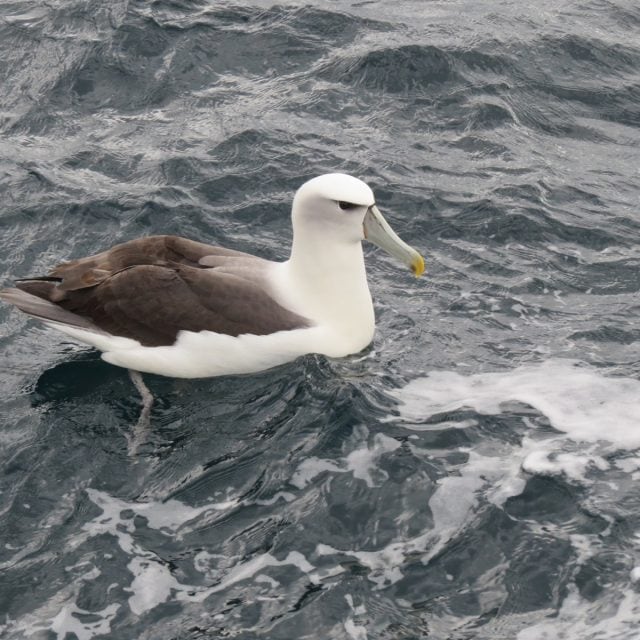
Day 1 Travel to Tutukaka
Our New Zealand birding tour begins today and we will meet at 3 pm in Auckland to drive north to the seaside town of Tutukaka. Our guide can collect you at the airport or at the hotel where we have booked participants wanting pre-tour nights. This is about a 3 hour drive and we will not be stopping to bird along the way so that we can arrive in Tutukaka and rest up for the next day. We’ll have plenty of time for birding on the rest of the tour! Night in Tutukaka.
Day 2 Optional pelagic birding trip
For those taking part in this pelagic trip, you are in for a treat! The list of potential seabirds is very impressive, with a multitude of albatrosses, shearwaters, petrels and storm-petrels. We have a chance to see endemic specialties like Parkinson’s Petrel, Cook’s Petrel, Pycroft’s Petrel, and Buller’s Shearwater.
The most famous bird on this tour is the New Zealand Storm-Petrel which was only re-discovered in 2002 (presumed extinct since 1850). Predator eradication efforts on Little Barrier Island (now known to be their breeding site) have led to an increase in numbers and this means that we stand a good chance to see some today! There’s always a good chance for a variety of marine mammals.
The pelagic departs about 7 am and returns in the late afternoon. If a full-day pelagic is not of interest, you can do some walking and exploring of the beautiful town and beaches of Tutukaka. Lunch on your own if you are not on the pelagic.
Our group will gather again for dinner this evening and discuss the adventure ahead. Night in Tutukaka.
Day 3: Trounson Kauri Park
We will leave the hotel after breakfast and check the immediate area for Reef Heron. We will then make our way towards Dargaville for lunch with a stop or two along the way depending on recent bird sightings. We will proceed north after lunch and will scour the accommodation grounds for native eels and native birds (Grey Warbler and Silvereye). Trounson Kauri Park will be our destination in the evening to look for Morepork (owl), Weta (cricket) and North Island Brown Kiwi. Night in Trounson Kauri Park.
Day 4: Transfer to Orewa
We have a morning walk around Trounson Kauri Park, which protects some of the last of the mighty kauri forests of New Zealand’s Northland region. These magnificent trees are among the most ancient species in the world—some boasting trunks measuring over 5m in diameter! The wood is highly prized as a valuable timber and thus most of NZ’s kauris were heavily logged until a moratorium was established in the 1970s.
We then head over to Waipu Cove for Fairy Tern, with a detour to look for Australasian Grebe, and take the scenic coastal route via Mangawhai Heads (another locality for Fairy Tern) to Orewa. Time permitting, we may take in Wenderholm Park for commoner landbirds and shorebirds. Night in Orewa.
Day 5: Tiri Tiri Matangi Island
Today we take the boat ride to Tiri Tiri Matangi Island—one of the greatest bird conservation success stories in New Zealand. What was once an overgrazed islet supporting little birdlife, is now a predator-free sanctuary covered in native plants, all supporting a vibrant bird community including some of the countries rarest endemics like Stitchbird, Kokako, and the iconic Takahe (giant flightless swamphen). We’ll spend most of the day exploring this lovely little island then return to our accommodation in the late afternoon. Night in Orewa.
Day 6: Miranda
We leave early and drive through Auckland to our next destination at Miranda. Our day will be partially organized around the high tide here. The coastal mudflats and saltmarsh of Miranda (NZ’s most famous shorebird hot spot) support Bar-tailed Godwits (who fly non-stop from Alaska—11,000+km—to winter here!), Red Knot, Sharp-tailed Sandpiper, Red-necked Stint, Wrybill, New Zealand Dotterel, Banded Rail, Pied Oystercatcher, and White-fronted Tern. If we’re lucky there might be a few other Siberian waders here such as Marsh Sandpiper or Greater Sand Plover. Night in Taupo.
Day 7: Pureora Forest
Pureora Forest Park straddles the Hauhungaroa and Rangitoto Ranges between Lake Taupo and Te Kuiti, and is renowned for its towering trees - totara, rimu, matai, miro and kahikatea up to 40-60 metres. There is rich native bird life in this forest including the Kokako and the Kaka, Kakariki (Yellow-crowned Parakeet), Long-tailed Cuckoo, Whitehead, Rifleman and North Island Robin. The Waipapa Walk is a loop that begins along the edge of the Waipapa Ecological Area, and it offers the best chance of finding Kokako. Later in the day we plan on stopping at Whakamaru Dam, for waterbirds and perhaps a rarity such as Caspian Tern. Night in Taupo.
Day 8: Tongariro and Turangi
Today we visit Tongariro National Park with its spectacular series of snow-capped volcanoes including Ngauruhoe (Used for “Mt Doom” in the Lord of the Rings movies). We stop along the Tongariro River to look for the rare and declining Blue Duck (or “Whio”)—a highly specialized endemic of NZ’s mountain rivers. Depending on time we can check out a few forest and alpine trails in the park. Night in Palmerston North.
Day 9: Waikanae and Ferry Crossing to South Island
We start off the morning by heading to the west coast of North Island and checking out wetlands and shorebird hotspots such as Waikanae and the Manuwatu estuary. We then head to Wellington for the Interisland Ferry across the Cook Straight Crossing to Picton during which we are likely to see another fine array of seabirds and perhaps whales and dolphins. Night in Picton.
Day 10: Marlborough Sounds
We take a morning cruise through the magnificent Marlborough Sounds, looking for Fluttering and Sooty Shearwaters, White-fronted Terns and especially New Zealand King Shag, a highly endangered species. Hector’s Dolphins occur here also. We’ll stop at Blumine Island and bird the forest edge looking for Orange-fronted Parakeet and Yellowhead. After lunch, we drive to Kaikoura - world famous for its sea-life as the continental shelf is just over 1 mile offshore. This means you can expect a wonderful variety of seafood on the menu this evening, and it also means that there are a lot of seabirds out there on the waves! We’ll enjoy a casual evening on the waterfront, perhaps with an optional visit to the Point Keane seal colony where we may find Double-banded Plovers and Ruddy Turnstones foraging along the shoreline. Sometimes albatross are visible from shore and perhaps we’ll be able to see large rafts of Hutton’s Shearwaters—a Kaikoura endemic. Night in Kaikoura.
Day 11: Pelagic birding
It’s albatross fiesta time! Kaikoura is touted by many as the pelagic capital of the world, so you can expect to see a variety of seabirds at close-quarters today including the massive Wandering Albatross, with a wingspan of 3.5m! In addition to the albatrosses, shearwaters, petrels, and penguins we might encounter, there is a chance we might see marine mammals including several dolphin species and even a Sperm Whale or two! In the afternoon, we have an optional afternoon birding hike in nearby Fyffe/Palmer reserve, or perhaps out to the seal colony at Point Keane if we did not visit yesterday. Night in Kaikoura.
Day 12: Across the Southern Alps to Arthur’s Pass
We leave Kaikoura, and head south, stopping at a few coastal birding hotspots such as St Ann's Lagoon in Cheviot along the way where we may be able to add species like Cape Barren Goose, Far Eastern Curlew, and possibly Pacific Reef-Heron. We then head inland to spend the night at Arthur’s Pass.
Day 13: Arthur’s Pass and Franz Josef Glacier
This morning we explore the alpine meadows and shaded forests of Arthur’s Pass National Park. This is a fantastic time of year for blooming flowers and the birding should be fun too with cheeky Keas stirring up mischief and the possibility of NZ Falcon and NZ Rock Wren in the area. We then head down to the coast and drive south to our overnight accommodation at Franz Josef Glacier. We will schedule an optional evening outing to Okarito to try to find the rarest of the kiwis, the Okarito Brown Kiwi (Rowi). Night in Franz Josef Glacier.
Day 14: Franz Josef Glaciers and Haast Pass
We plan to visit Franz Josef Glacier this morning and then take a short walk in the swamp forest along Ship Creek. We travel today along the coast of the Tasman Sea whose isolated beaches and old-growth tree-fern forests give us a taste of what the rest of New Zealand might have looked like before human settlement, and then through the beautiful mountain forests of Haast Pass where, time permitting, we may take a short walk or two looking for Brown Creeper and Yellowhead. Night in Wanaka.
Day 15: Around Twizel
We spend the day in the Twizel area, a land of rivers, lakes, marshes, and inland deltas. We look for one of the world’s rarest shorebirds—the Black Stilt, as well as the unique Wrybill (the only bird with a bill bent sideways—always to the right!). If we have a clear day, then we should enjoy views of towering Aoraki (Mount Cook)—the highest peak in Australasia. Night in Wanaka.
Day 16: Travel to Te Anau via Mount Aspiring National Park
We leave the Wanaka area and travel through the bustling tourist capital of Queenstown (the “Banff of New Zealand”), nestled along the shores of mighty Lake Wakatipu, the scenery dominated by the aptly named ‘Remarkables’ mountain range. Further north of Queenstown we explore the tiny settlements of Glenorchy and Paradise where we have lunch and a birding stop in scenic Mount Aspiring National Park. Forest birds like Long-tailed Cuckoo, Yellow-crowned Parakeet, and the always sought-after Mohua (Yellowhead) are possible, along with many others. We then drive to Te Anau, the gateway to Fiordland National Park. This is a spectacular park – unrivalled mountain vistas, enormous glaciers, wild rivers, lowland podocarp forests, alpine flora of daisies and buttercups, and superb silver beech forests. We spend two nights in this charming area. Time permitting we could take an optional afternoon walk along start of Kepler track at south end of Lake Te Anau. Night in Te Anau.
Day 17: Fiordland National Park and Milford Sound
We travel the famous Milford Road past superb meadows, forests, and boulder fields through the Upper Hollyford Valley, stopping at Monkey River to look for Blue Duck if we haven’t already found this species, and in high altitude rocky basins for the famous Kea and the rare and declining NZ Rock Wren. We pass through the Homer Tunnel and descend to iconic Milford Sound (technically a fjord). In the afternoon, we board a comfortable vessel where we cruise out to the Tasman Sea, passing mile-high rock walls, spectacular waterfalls, as well as rocks in the ocean which belong to different tectonic plate. We have opportunity for Fiordland Crested Penguin, which can sometimes be seen loafing along the rocky shoreline of the fjord. Night in Te Anau.
Day 18: Ferry to Stewart Island and Kiwi excursion
We drive from Te Anau to Bluff. From here we take the 1 hour Ferry to Oban on Stewart Island for a two-night stay. This Ferry ride is a great opportunity to view large numbers of seabirds including several Albatross species and Diving-Petrels. Upon arrival, the rich native plant and bird life should be evident even around our accommodation in Oban—especially the raucous and inquisitive Kaka (parrot) whose silvery-white crown and flashy pink underparts make it an instant fan-favourite among visitors to Stewart Island. In the evening, we will take a 45 minute boat trip to a remote beach to look for Stewart Island Brown Kiwis (largest of the kiwis) with a chance at hearing or seeing other night birds and critters. This is always a wonderful and memorable experience. Night in Oban/Halfmoon Bay.
Day 19: Ulva Island and Stewart Island Pelagic
We take a water taxi to the small offshore island of Ulva, a predator-free island with numerous endemic birds – Weka, Red-crowned Parakeet, NZ Fantail, Pipipi, Tui, South Island Saddleback, the Stewart Island race of New Zealand Robin, perhaps even the highly endangered Mohua (Yellowhead). After lunch we will take a half-day pelagic cruise out around the muttonbird islands to the east of Stewart Island. This area provides a wonderful feeding ground for a variety of pelagic birds including several species of Albatross, Petrel, Diving-Petrels and Prions. There is also a good chance of finding the much sought after Fiordland Crested Penguin. If we were rained out the previous night, we will reschedule the kiwi exploration for tonight. Night in Oban/Halfmoon Bay.
Day 20: Ferry to Bluff, the Catlins and Dunedin
After breakfast, we take the ferry back to Bluff, and travel the scenic southern route through the Catlins region—famous for its lush beech forests, hidden waterfalls, and wild Pacific coastline - to Dunedin. Night in Dunedin.
*Depending on the weather the previous day, we may reschedule our half-day pelagic after breakfast before taking the ferry back to Bluff.
Day 21: Albatross and Penguins on the Otago Peninsula
Today we travel along the scenic Otago Peninsula to visit the Taiaroa Head—the site of the World’s one and only mainland albatross colony! The Royal Albatross is the second largest albatross in the world, boasting a wingspan of 3 meters! As we watch the colony we should also get great looks at both Stewart Island and Spotted Shags (endemic cormorants). From there we’ll travel a short distance to take a guided hike to the nesting sites of the largest penguin species north of the Subantarctics—the scarce endemic Yellow-eyed Penguin. Here also is the World’s smallest penguin—the aptly named Little Penguin. Night in Dunedin
Day 22: Birding around Dunedin, Flights home
We have the morning free before we catch our mid-afternoon flights from Dunedin to Auckland and on to International destinations. We’ll aim to check out a few local birding spots to round up any species we may have missed. Alternatively we may visit the botanical gardens or carry out some sight-seeing in Dunedin itself. Thus our incredible New Zealand birding tour draws to a close and we head home after such an amazing experience.
What to Expect
The daily travel schedule on our New Zealand birding tour will vary to account for weather, tides, the previous night’s expeditions, bird species and travel times.
You can expect some early morning, pre- breakfast walks, as well as three optional evening forays to look for kiwis and possibly owls. Around noon, we stop for a picnic lunch at a scenic spot or stop for a sit down meal at a local restaurant. In the evening we relax at the hotel restaurant, or at a local dining place. At this time we discuss the day’s activities and review the list of birds and wildlife we have encountered. We will outline the events for the next day, preparing you for another round of excitement and discovery.
The tour will generally involve easy to moderate walking; two of the night-time forays will involve some steep trails, and walks of up to 4 kms. When at higher elevations, we keep our walking to a slow pace, doing most of our observation from the vehicle. In general, we keep all our nature study to a reasonable pace, maximizing the number of things we see and allowing enough time to properly enjoy them.
We have a number of long drives as we travel almost the length of the country, from Stewart Island off the south coast to Dargaville on North Island.
Our itinerary includes one open ocean pelagic trip as well as inshore cruises and a three-hour ferry ride between North and South Islands.
The weather will vary from warm to hot on North Island, to warm to cool on South Island; rain is likely, especially on the west and south coasts of South Island. The pelagic trip is likely to be cool, as are the night-time forays to look for Kiwis. It is best to dress in layers.

Featured Wildlife
While we cannot guarantee sightings of the birds or mammals listed below, we believe that encountering these species is quite likely during this tour.
- Over 60 endemics possible including: (Maori name in parentheses)
- North Island Brown Kiwi
- Okarito Brown Kiwi (Rowi)
- Great Spotted Kiwi (Roroa)
- Royal Albatross (Toroa)
- New Zealand Storm Petrel
- Yellow-eyed Penguin (Hoiho)
- Fiordland Crested Penguin (Tawaki)
- Blue Duck (Whio)
- New Zealand Falcon (Karearea)
- Black Stilt (Kaki)
- Saddleback (Tieke)
Past Tour Checklists
View the list of birds and other wildlife we encountered on our past tours.
- New Zealand species list 2023 (pdf)
- New Zealand species list 2022 (ebird)
- New Zealand species list 2019
- New Zealand species list 2017
- New Zealand species list 2015
Trip Reports & Inspiration
Tour reviews, you might also like.
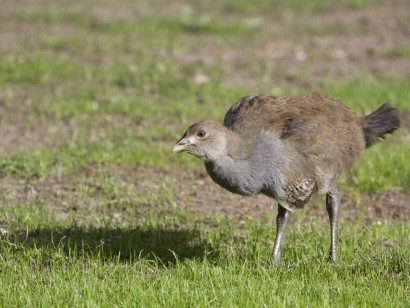
Australia: Tasmania
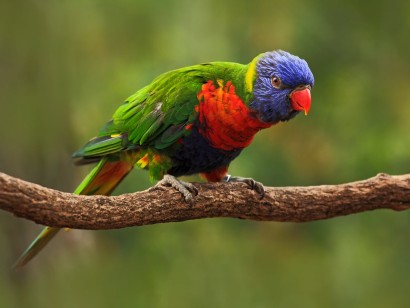
Tropical Australia

Eastern Australia
- Conservation
- In the media
- Birding blog
- How to book
- Booking FAQs
- Plan your trip
- Land Tour FAQs
- Insurance FAQ
WHERE WE GO
- Mexico & Central America
- South America
- Australia & New Zealand

- Terms of Use
- Privacy Policy

Birding New Zealand
October 8 - 24, 2024, w/New Caledonia extension
- Full Itinerary
- Photo Gallery
Travel Details
- Trip Reports
- Know Before You Go
- Other Trips You May Like
Discover the nature of New Zealand, a country of lush valleys, soaring peaks, white beaches, and turquoise lakes. Scenery is a true highlight of this tour; however New Zealand’s wildlife is sure to inspire both nature enthusiasts and birders alike. The conservation story and determination of New Zealanders to protect their heritage is inspiring. Enjoy delightful lodgings and delicious dining options as we explore both the North and South Islands. Immerse yourself in steamy rainforests, embark on boat and ferry trips teeming with seabirds and marine life, hike in awe-inspiring mountain settings, and sense the great spiritual significance of the Maori people. It’s a magical trip in many ways, a blend of scenic beauty our everyday backdrop to finding endemic birds, including some of the flightless kiwis. For many it will be a first trip to the Oceania ecoregion and the first time to explore the micro-continent of Zealandia. We’ve carefully crafted a thorough trip to the North and South Islands to cover a good majority of species.
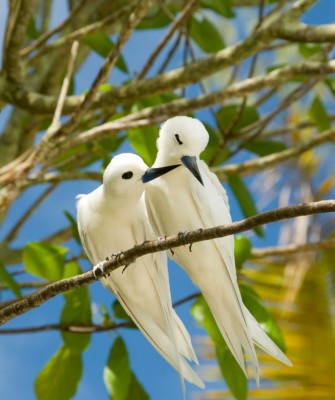
- "New Zealand was on the top of my list of all my travels. Since I returned I haven't stopped thinking about the friendships, birding, pelagic trips, leadership, accommodations, and beauty of New Zealand diversity." — Roger Zachary, Jr., 2023 Traveler
- “I appreciated the knowledge of the local guide and his enthusiastic up-to-date ability to find some very rare endemic birds.” — 2023 Traveler
- “It was fabulous...more than I expected or imagined. I loved the pelagic birding and the night time kiwi experiences. Our guides were extremely helpful and knowledgeable and the accommodations and the food was outstanding.’ — 2023 Traveler
Tour Highlights
- Visit Tiritiri Matangi Island in search of rare species like the Saddleback, Stitchbird, Whitehead, and Red-crowned Parakeet
- Discover Miranda Wildlife Sanctuary, home to excellent active shell chenier plains and plentiful sea and shorebirds
- Experience the haunting call of the endangered Kokako in the misty rainforest of the central North Island
- Embark on a three-hour ferry crossing to the South Island, not nearly long enough for all the wildlife watching from the deck!
- Cruise the Marlborough Sounds, listening for Orange-fronted Parakeet and watching for Hector’s Dolphin
- Discover Kaikoura and enjoy an unrivalled seabird excursion this morning. On a free afternoon; stroll the peninsula, take a whale watching trip, or browse shops
- Walk amongst the spectacular landscapes of Arthur’s Pass National Park.
- Take a charming cruise around Taiaroa Head, the only mainland breeding site of Northern Royal Albatross
- Explore Steward Island and search for Brown Kiwi in their natural habitat
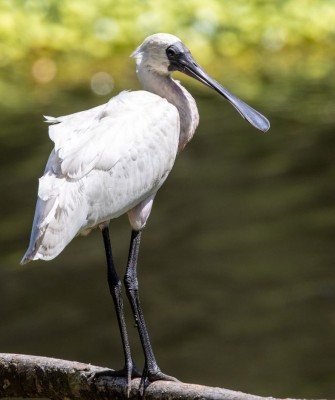
Trip Itinerary
Itineraries are guidelines; variations in itinerary may occur to account for weather, road conditions, closures, etc. and to maximize your experience.
Tues., Oct. 8 Main Tour Begins – Welcome to Auckland!
Meet your Naturalist Journeys’ and our local partner company’s guide for lunch in central Auckland. Please take a taxi from the airport; they are readily available for the ride into the central city. After a lunch meet-up hosted by Naturalist Journeys, we head out for a sample adventure—if you are just arriving and tired from travel you can opt out as needed, but it is a beautiful place to start! Auckland is an area characterized by water, volcanoes, and islands. We escape from the bustle of the city to enjoy a gentle introduction to the West Coast, and to watch Australasian Gannet soaring in towards their dotted rock outcrop colonies. Stay at the Grand Millennium Hotel for two nights (L,D)
Wed., Oct. 9 Tiritiri Matangi Island | Auckland
Tiritiri Matangi is an island sanctuary in the Hauraki Gulf, just north of Auckland. Many of New Zealand’s rare and endangered species now only remain on islands such as this, as the habitat can be protected from the ravages of rats, possums, and stoats. Tiritiri Matangi is the site of an ambitious restoration project started 17 years ago, and already the fruits of many people’s efforts are being appreciated by many. We have a day on this picturesque island to enjoy birdsong in regenerating forest, including that of re-introduced rare species such as the Saddleback, Stitchbird, Whitehead, and Red-crowned Parakeet. Also on the island are the unique Takahe and Brown Teal. Sailing by ferry to the island Australasian Gannet, Black Petrel, Cook’s Petrel, and Buller’s Shearwater may pass us. Dinner tonight is at leisure, and there are multiple places to choose from in walking distance from the hotel. Return to the Grand Millennium Hotel (B,L)
Thurs., Oct. 10 Depart Auckland | Miranda Wildlife Sanctuary (Shorebirds Galore!)
Within an hour’s drive southeast of Auckland lies Miranda Wildlife Sanctuary, a fine feeding ground for many wading birds, which migrate from the tundra of the arctic regions for the northern winter. Among the thousands of Eastern Bar-tailed Godwits on the shell banks or silt flats, we may view many Knots and South Island Pied Oystercatchers, the rare endemic Wrybill, the endangered NZ Dotterel, Far Eastern Curlew, Whimbrel, several Sandpipers, Caspian Tern, Little Tern, and Sacred Kingfisher. Later this morning, we travel towards Lake Rotorua, where NZ Dabchick, NZ Scaup, and Little Black Shag are often feeding or roosting. Rotorua is situated in the central plateau of the North Island, a region of much geothermal activity. Stay Lakeland Resort, Taupo tonight. (B,L,D)
Fri., Oct. 11 Pureora Forest Park | Tongariro National Park
This morning we have a dawn start, to experience the haunting call of the endangered Kokako in its natural, misty rainforest environment. Pureora Forest Park contains one of the finest areas of podocarp forest in the country, as well as a large variety of native invertebrates, like the curious Peripatus, and numerous birds. We will have most of today to gain more insight into the nature and conservation of this special forest, and to enjoy the sounds of the Kaka, Yellow-crowned Parakeet, Tomtit, New Zealand Robin, Long-tailed Cuckoo, New Zealand Falcon, Whitehead, and Grey Warbler. Later, our day winds up in Tongariro National Park. On the rivers running off the volcanoes a small number of the endangered Whio, or Blue Duck survive. Today we shall also make a special trip to search for these birds. Accommodations at Skotel, Whakapapa one night (B,L,D)
Sat., Oct. 12 Mt. Ruapehu, North Island | Ferry Crossing to South Island
Morning walk amongst sub-alpine forest and tussocklands on the slopes of Mt. Ruapehu, the North Island’s highest peak. A longer day today as we travel to Wellington and cross to the South Island. En route to Wellington we shall deviate to the Foxton Estuary with opportunities for Pacific Golden Plover, and Royal Spoonbill. Our journey continues southwards through to Wellington, where we embark on an evening ferry crossing to the South Island. Three hours, however, is at times not enough for all the wildlife watching to be done! Wandering and Shy Albatrosses often pass by, as do Giant Petrels, Arctic Skuas, and many shearwaters. Towards the entrance to the Marlborough Sounds can often be seen Little Blue Penguins, Spotted Shags, and sometimes dolphins. Purchase dinner tonight as we go as we are on inter-island ferry. Accommodations at the Picton Beachcomber Hotel, Picton (B,L)
Sun., Oct. 13 Marlborough Sounds Boat Cruise
The waters and inlets of the Marlborough Sounds will be our playground this morning. The cruise vessel carries us through Queen Charlotte Sound to a small rocky islet, where a small colony of the rare King Shag breeds and roosts. There may also be an opportunity to listen for the endangered orange fronted parakeet on one of the sound’s predator free islands. Before returning to Picton, we land to introduce ourselves to the curious Weka. Mid-afternoon sees us heading south down the east coast to Kaikoura, where we stay for two nights. Accommodations at White Morph Inn, Kaikoura (B,L,D)
Mon., Oct. 14 Kaikoura Seabird Cruise
Kaikoura is a breath-taking place where snow-iced mountains reach down to a turquoise sea. The continental shelf drops abruptly very close to shore, resulting in upwellings of nutrients from the sea’s depths, attracting a rich and abundant marine life. An excellent opportunity for bird lovers and generalists alike is a seabird excursion, where one can see flocks of cawing albatrosses (4-5 species), and numerous petrels and shearwaters, just meters from the boat. In the afternoon we are at leisure to stroll on Kaikoura Peninsula, or you may opt to go out for a second pelagic or join a whale watching excursion for Sperm Whales. Accommodations at White Morph Inn, Kaikoura — Lunch and Dinner are at leisure in this delightful town (B)
Tues., Oct. 15 Canterbury Plains | Southern Alps
Depart Kaikoura and travel south to cross the Canterbury Plains. Now one of New Zealand's most intensive agricultural regions the plains run down from the foothills to the central Southern Alps. Nestled between two passes, Porter’s and Arthur’s, lies the Craigieburn Range and the renowned Castle Hill Basin. We walk amidst the limestone formations that make up this basin. Later our destination is the Arthur’s Pass Wilderness Lodge, set amidst a delightful mix of high-country beech forest and tussocklands, and a working sheep farm. Accommodations at Arthur’s Pass Wilderness Lodge (B,L,D)
Wed., Oct. 16 Arthur’s Pass Wilderness Lodge | Mountains & Lakes
We enjoy a day amidst the Mountain Beech Forests and braided rivers of the upper Waimakariri Valley. The Moa Forest discovery morning involves no driving from the Lodge for those who want a “no driving” morning. A relaxed and fascinating discovery of a “micro world” of riverbed, rock bluff, shrubland, beech forest plants and animals. Lunch in the Mt Rolleston Restaurant. An afternoon guided excursion is available for this wishing to explore further the mountains and lakes near the lodge. Accommodations at Arthur’s Pass Wilderness Lodge (B,L,D)
Thurs., Oct. 17 Lake Tekapo | Mount Cook National Park | Mackenzie Country
Cross back onto the Canterbury Plains and head south over Burkes Pass. As we wind across the foothills, with snow-capped mountains in the background, we overlook the vivid turquoise waters of Lake Tekapo and other large glacial lakes. We then continue on to the Mackenzie Country Hotel. Accommodations at the Mackenzie Country Hotel, Twizel (B,L,D)
Fri., Oct. 18 Braided Rivers | Mount Cook National Park
The braided rivers in this region are the habitat of the endangered Black Stilt, and we look also for Banded Dotterel and a range of inland waterfowl. Later today we travel up the Aoraki (Mount Cook National Park). Walk amidst the alpine splendor, search for the rare New Zealand Falcon, and take further opportunities to look for Black Stilt and Wrybill Plover on their breeding grounds. Accommodations at the Mackenzie Country Hotel, Twizel (B,L,D)
Sat., Oct. 19 Central Otago | Ferry to Stewart Island | Brown Kiwi Outing
This morning we depart the arid Mackenzie Country for Invercargill. Late this afternoon we take the ferry across to Stewart Island, watching for seabirds as we go. Settle into our lodgings and do some local birding. Dinner is at the lodge. Plan on an evening trip to view Stewart Island Brown Kiwi on one of our two evenings here. Accommodations at Kaka Retreat next two nights (B,L,D)
Sun., Oct. 20 Paterson Inlet | South Pacific Seabirds
A day marine charter to Paterson Inlet and into the South Pacific invigorates us with opportunities to observe a rich diversity of seabirds. Among the bays of the inlet we scan for two very rare penguin species: the Yellow-eyed Penguin and the Fiordland Crested Penguin. Out at sea we may encounter several species of albatross, including Shy, Black-browed and Buller’s, and the Southern Giant Petrel, Southern Great Skua, and Broad-billed Prion. We are also likely to come across large flocks of Sooty Shearwater, which breed nearby on the small outer islands. A treat awaits us on Ulva Island, a bird sanctuary rich in lush podocarp forest, and ringing with the songs of the Kaka, Tui, Bellbird, and the rare Red-crowned Parakeet. The Stewart Island Weka is also a popular resident. Accommodations at Kaka Retreat (B,L,D)
Mon., Oct. 21 Fiordland National Park
Back on the mainland, we are enticed by the glacially sculptured mountains and valleys of Fiordland National Park. We enjoy the afternoon in the wonderful beech forests of the Eglinton Valley. This forest is home to Longtailed Cuckoo, Yellow-crowned Parakeet, Brown Creeper, and Mohua/Yellowhead and provides an excellent opportunity for final views of New Zealand forest birds. Today is a full field day with picnic or local lunch. Dinner and checklist tally tonight are at our hotel. Accommodations at the Distinction Luxmore Hotel, Te Anau (B,L,D)
Tues., Oct. 22 Milford Sound
After breakfast at the hotel, we head out for a day excursion to Milford Sound. A drive to the Hollyford Valley delights us with mountain scenery. In this valley we seek out some endemic species, including the ubiquitous and cheeky Kea, and the elusive Rock Wren. We have lunch along the way. Mid-afternoon we hope for good weather and a tour highlight—a grand finale cruise on famous Milford Sound. We then return for dinner and our checklist tally Accommodations at the Distinction Luxmore Hotel, Te Anau (B,L,D)
Wed., Oct. 23 Southeastern Coast | Dunedin | Harbor Cruise
Cross the southern South Island , arriving in Dunedin, New Zealand’s “wildlife capital”, in the early afternoon. A charming harbor cruise will take us around Taiaroa Head, the only mainland breeding site of Northern Royal Albatross. With a wingspan of three meters, these seabirds are certainly impressive, soaring over cliffs dotted with nests of Spotted Shags and the rare Stewart Island Shags. Past rocky shelves of lounging fur seals we will sail, on our way back down the harbor towards the central city. Indeed, a magical wildlife experience, drawing to a close our rich and diverse discovery of New Zealand’s native treasures. Accommodations in the Heritage Leisure Lodge, Dunedin. (B,L,D)
Thurs., Oct. 24 Departures
While you can depart today at leisure, we suggest you book flights out in the afternoon, so we have a morning backup if weather precludes our harbor cruise the afternoon prior. This is up to you, but if it works for your outbound route, we suggest flights out after 3PM. We will make every effort to cruise the final afternoon, this morning is a weather backup. (B)
New Caledonia Pre-Tour Extension
New Caledonia, an archipelago halfway between Australia and Fiji, is an extraordinary place. While it has all the features you might expect from tropical islands – white sands, blue lagoons, and graceful palms – New Caledonia is also home to some amazing plants and wildlife. There are abundant conifers belonging the ancient plant family Araucariaceae, including the Cook pines, or Araucaria columnaris, which grow in the coral-derived soils along the coast.
New Caledonia is considered one of the world's most botanically-important, and critically endangered hotspots. Unlike many of the Pacific Islands, which are of relatively recent volcanic origin, New Caledonia is an ancient fragment of the Gondwana super-continent. New Caledonia is the second most important biodiversity hot spot on the planet : 76% of its flora is endemic. The factors contributing to such a rich variety of plant life include the diversity of climate, elevation, and soil found on New Caledonia. The biogeography of the island chain has been shaped by a complex and fascinating geological history.
But New Caledonia is also and mainly known for its lagoon. It is one of the three biggest reef systems in the world. It contains a rare diversity of coral and fish species, and has reef structures that are among the most diverse on the planet. The New Caledonian lagoon is home to unique marine biodiversity and a considerable number of iconic or endangered species, such as turtles, whales or dugongs. 15 000 of the 23 000 km2 of this New Caledonian site have been registered as a UNESCO world heritage Area.
Ancient plant families are more heavily represented on New Caledonia than their more modern counterparts. The larger flora include Nothofagus, Beilschmiedia, Adenodaphne, Winteraceae, Myrtaceae, southern sassafras (Atherospermataceae), conifers of Araucariaceae, Podocarpaceae, and Cupressaceae, and tree ferns. But the angiosperms are also fascinating, among them is Amborella trichopoda,which the the sole member of the oldest living flowering plant lineage, Amborelleaceae.
Tues., Oct. 1: Arrivals in Nouméa
Welcome to New Caledonia! Today we make our way to the Nouméa Hotel where we will start our journey. Accommodations at The Hotel Beaurivage (D)
Wed., Oct. 2: Exploring Nouméa
Enjoy time birding in this beautiful setting! Accommodations at The Hotel Beaurivage (D)
Thurs., Oct. 3: Mont Koghi
This morning we drive onto Mt Koghi for our first walk through the lush mesic rain forests that clothe much of inland New Caledonia. Good opportunities here to view several endemic bird species as well. On route back to the city at Montravel, in the heights of Nouméa, Parc de Forestier is a great spot for easy walking to gain an insight into the natural values of New Caledonia, with beautiful views over the lagoon and along the southern coast of the Mainland. The zoological park is home to many endemic birds, including the key breeding program for New Caledonia's national bird, the Kagu (cagou). Key Birds in this Region: New Caledonian Friarbird, Horned Parakeet, New Caledonian Crow, Barred Honeyeater, Nonu/GoliathImperial Pigeon, Metallic Pigeon, South Melanesian Cuckoo-shrike Accommodations at The Hotel Beaurivage (D)
Fri., Oct. 4: Riviere Bleu Provincial Park
We travel early morning to the far south of the southern province, this beautiful park is a bushwalker's paradise, extending over 9000 hectares of wild country rich in native plants and animals. The park's giant Kaori stand 40m high and are almost a 1000 years old, and you'll also likely get to admire New Caledonia's rare national bird, the kagu (cagou), in the wild. A bus runs us through the heart of the park enabling us to hop on and off to wander through the varied forests adjoining the lake. Key Birds in this Region: Yellow Bellied Robin, New Caledonian Myzamela, Crow Honeyeater, Southern Shrikebill, New Caledonian Parakeet, Long tailed Triller, Melanesian Whistler, Grey Eared Honeyeater, Fan Tailed Gerygone, Green-backed White-eye, Kagou White Bellied Goshawk Accommodations at The Hotel Beaurivage (D)
Sat., Oct. 5 : Madeleine Provincial Reserve
Madeleine Provincial Reserve is a botanical reserve in the heart of the Plaine des Lacs. We return early morning to Riviere Bleu seeking out any species not seen on our first visit to this, the region with greatest biodiversity in New Caledonia. Later a signposted botanical path enables us to discover the scrub flora by the impressive Madeleine Falls, the scenic highlight of the reserve. It contains 168 plant species. The reserve’s flora is especially remarkable due to the presence, along the river, of 7 primitive conifers, vestiges of the secondary era. Return to Noumea. Accommodations at The Nouvata Hotel (B,L,D)
Sun., Oct. 6: Parc des Grandes Fougères
Adding to New Caledonia’s primeval appearance are some truly giant tree ferns. Nowhere is this better illustrated than in the forests adjacent to Farino. But first we shall take the short botanical trail near Sarramea before dring a short distance to Parc des Grandes Fougères. Among them are species from the Cyatheaceae family, which include the world’s largest tree ferns, with trunk heights in excess of 65 feet. There is a wide diversity of walks in this delightful national park located on the southern hills. Arrive back in Noumea late afternoon. Key Birds in this Region: Red Throated Parrotfinch, Buff Banded Rail, Common Waxbill, Striated Starling, Grey fantail, Chestnut Breasted manikin, Melanesian Flycatcher. Accommodations at The Nouvata Hotel (B,L,D)
Mon., Oct. 7: Depart for Aotearoa New Zealand
Departure from Tontouta International Airport. Arrive Auckland early afternoon and transfer to central city hotel. Accommodations at the Grand Millennium Hotel (B,L,D)
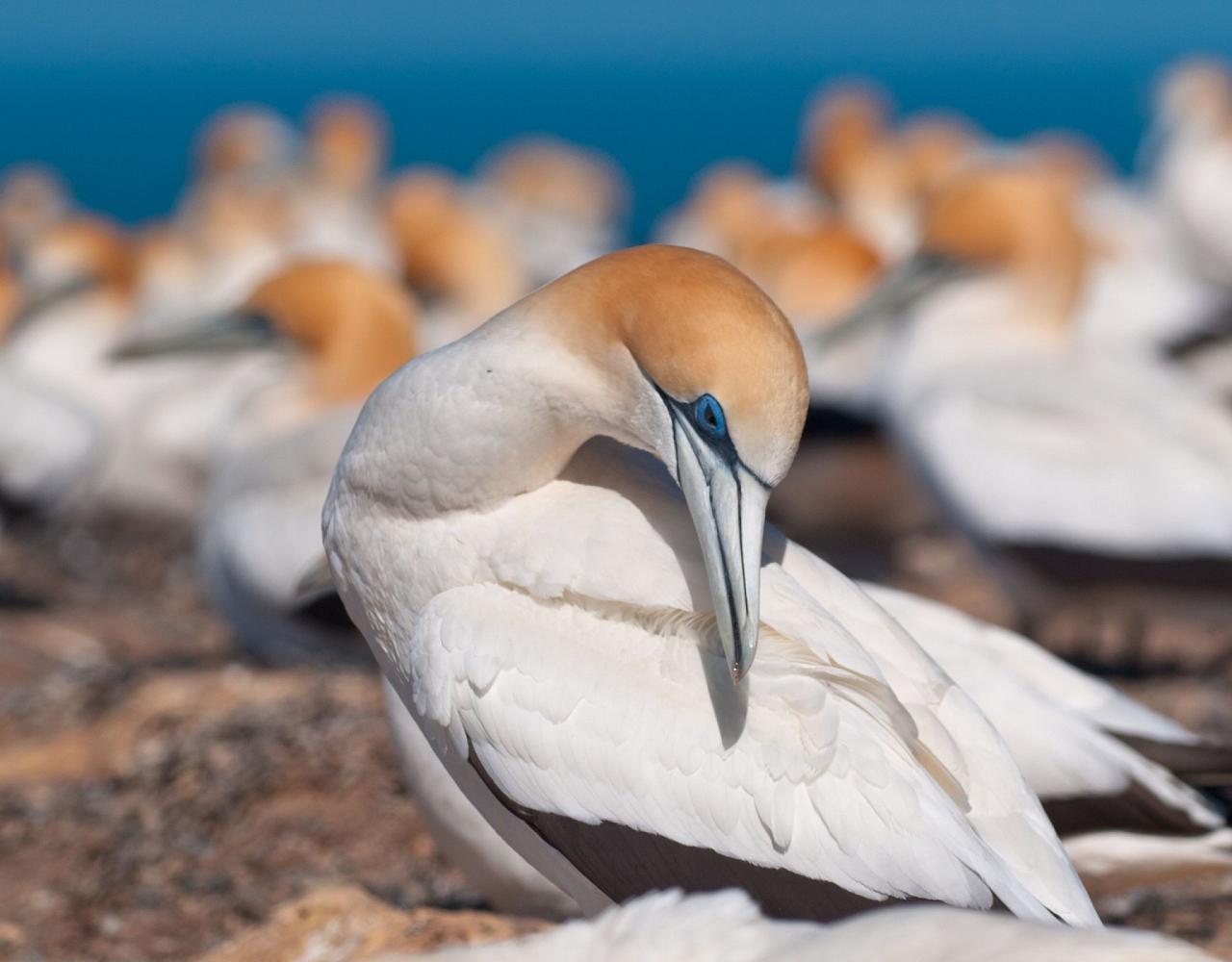
Australian Gannets
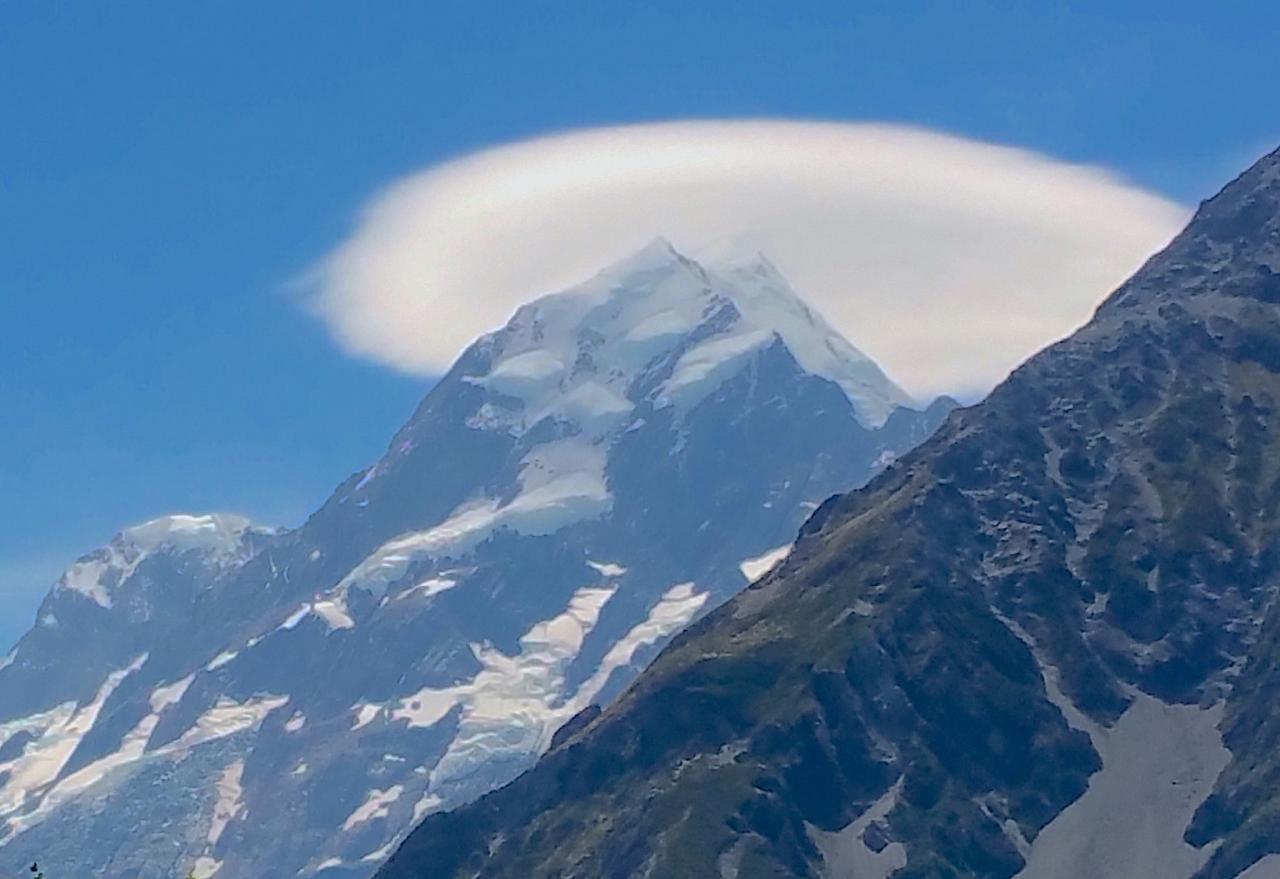
Aoraki by Greg Smith
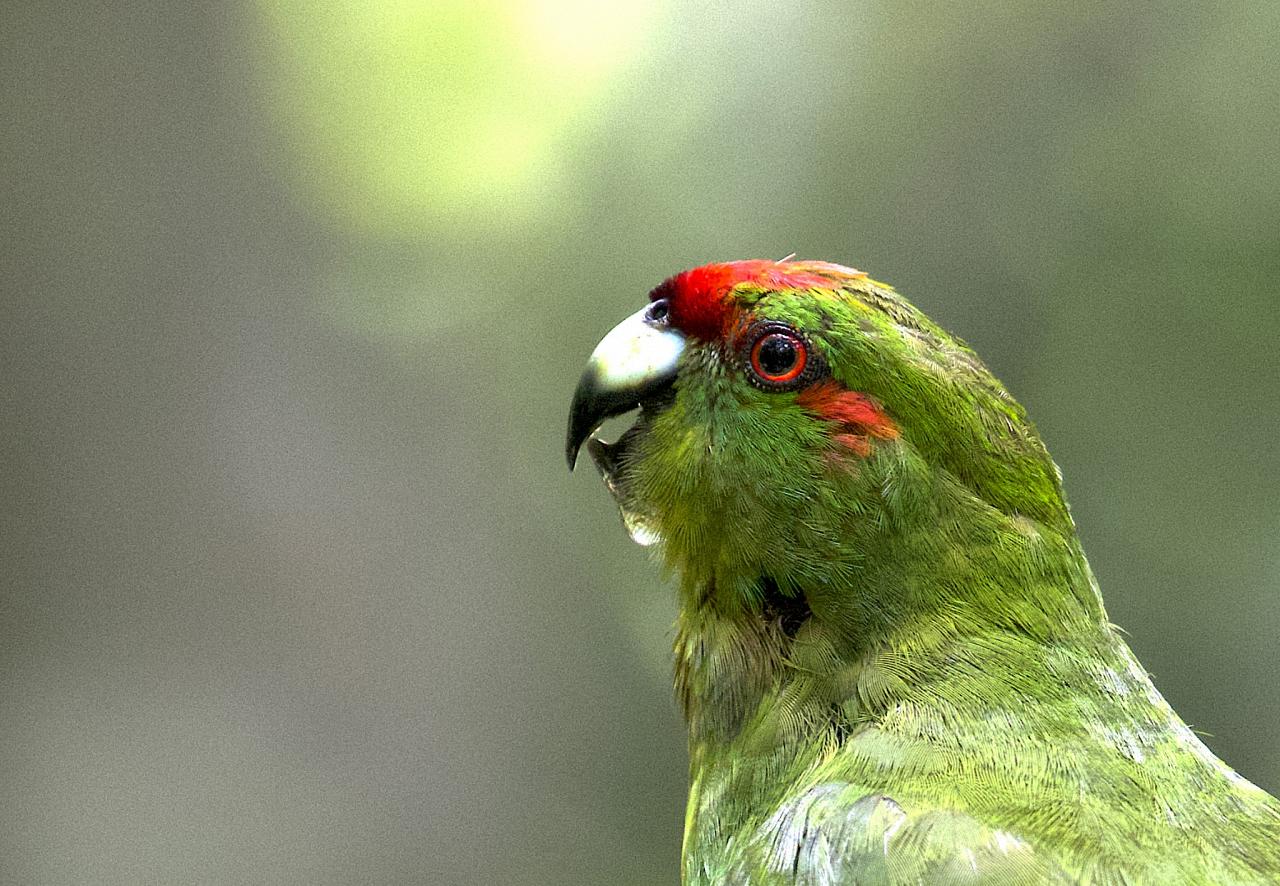
Red-crowned Parakeet by Greg Smith
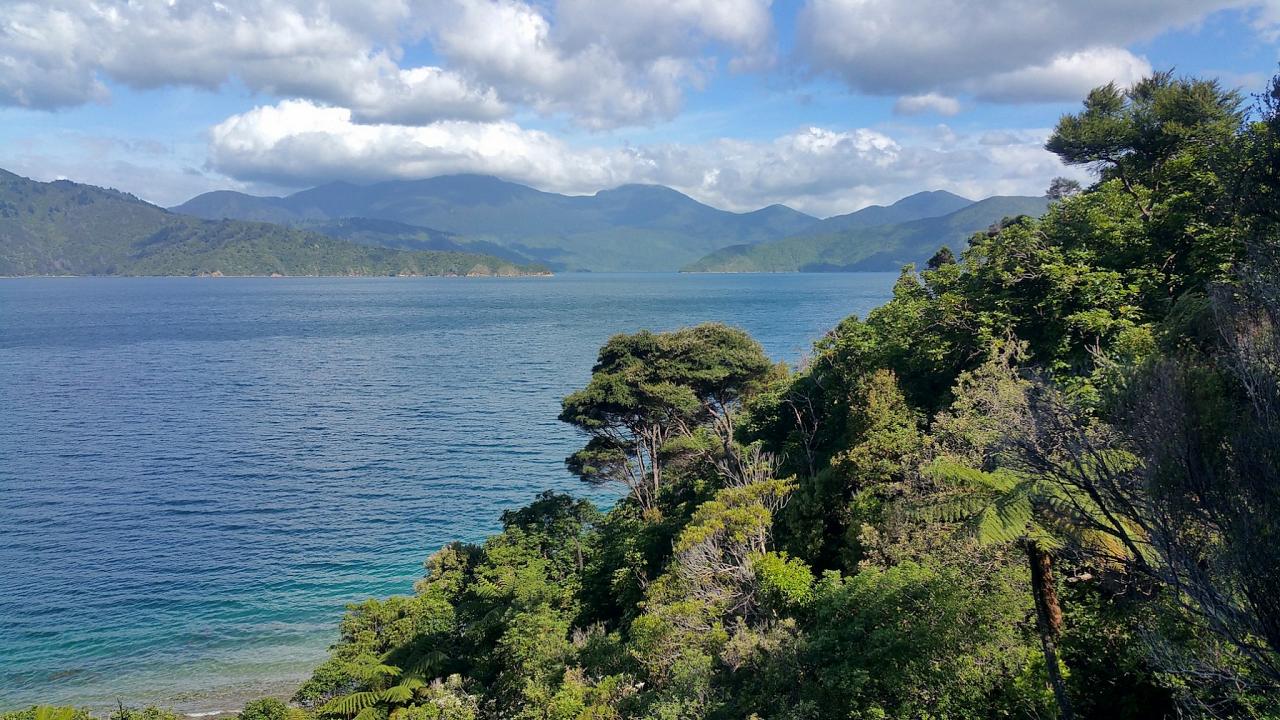
Marlborough Sounds by Greg Smith
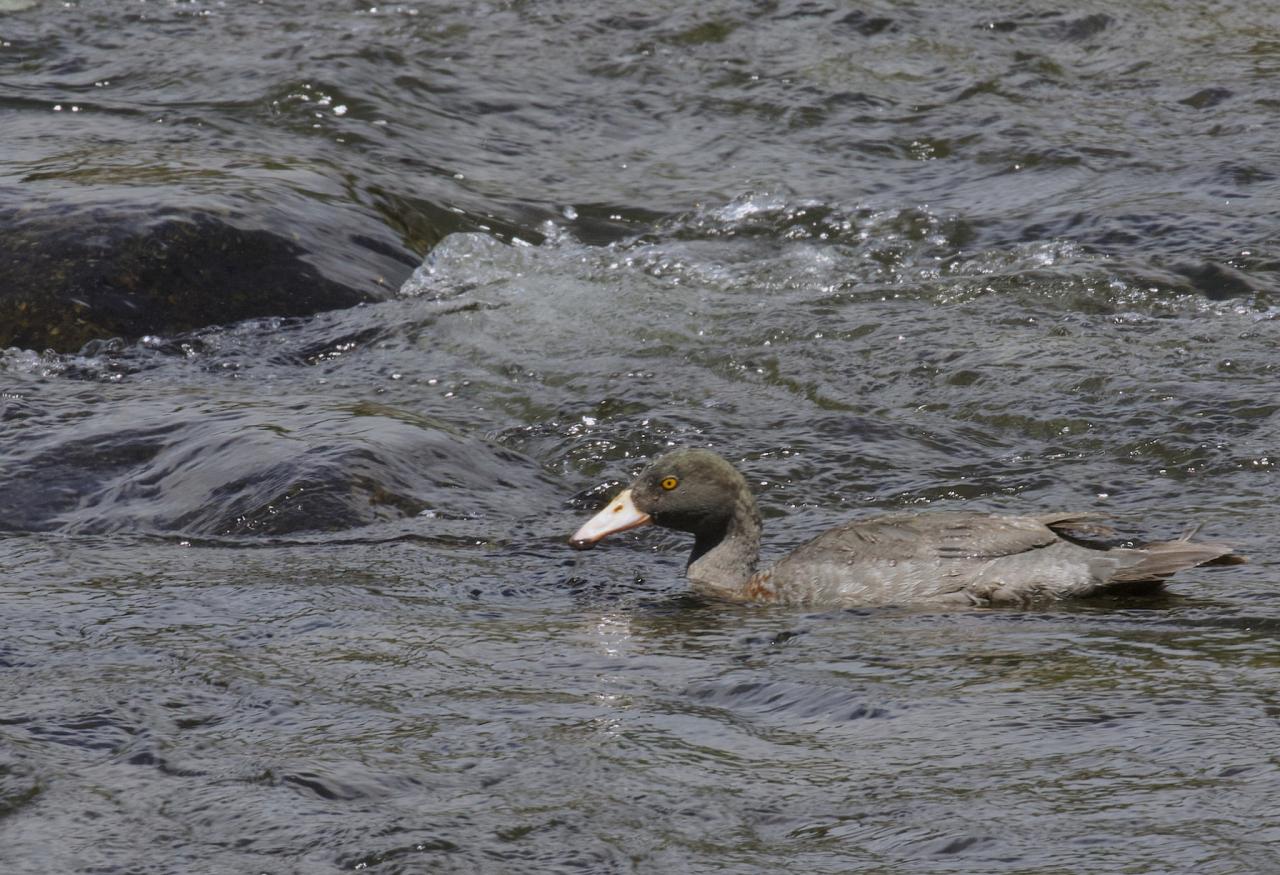
Blue Duck by Greg Smith
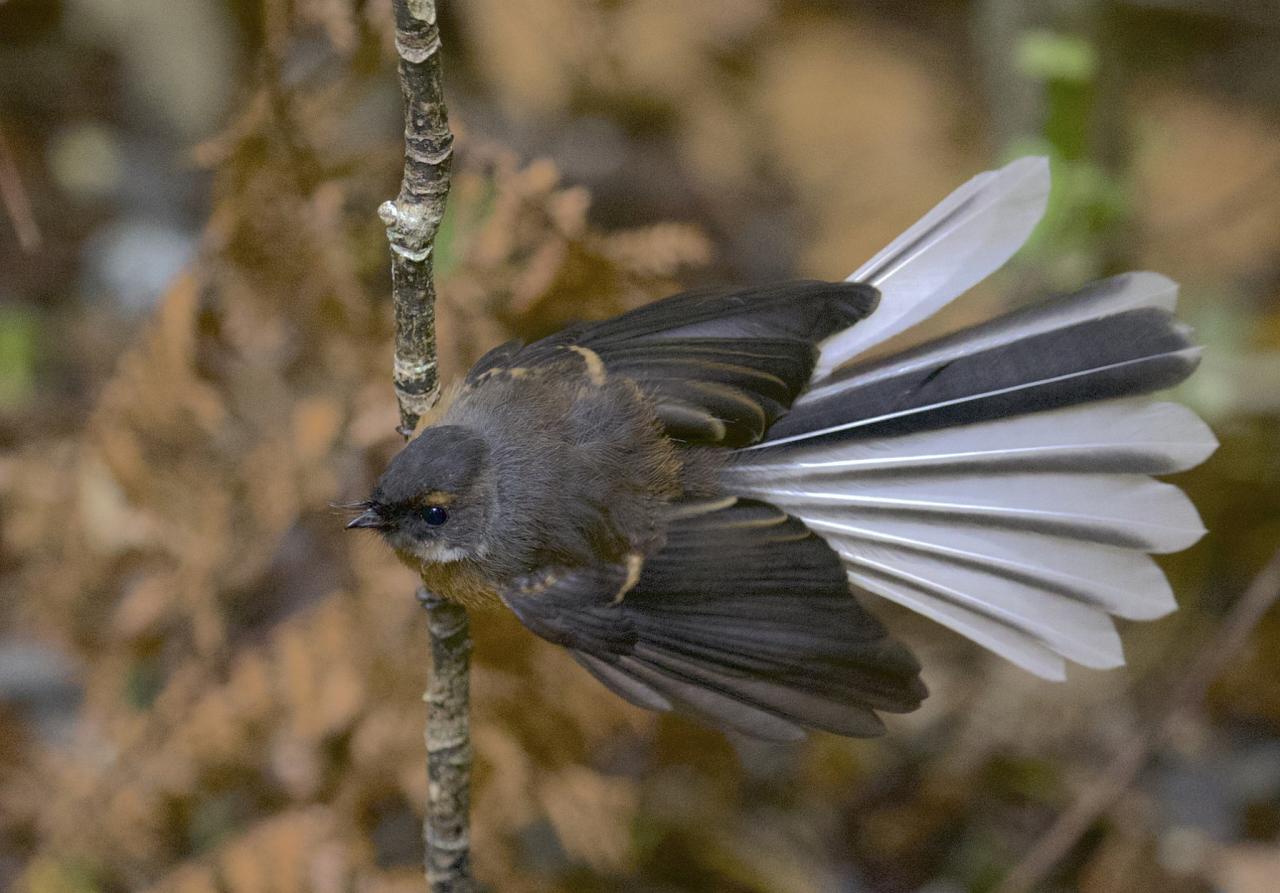
Fantail by Greg Smith
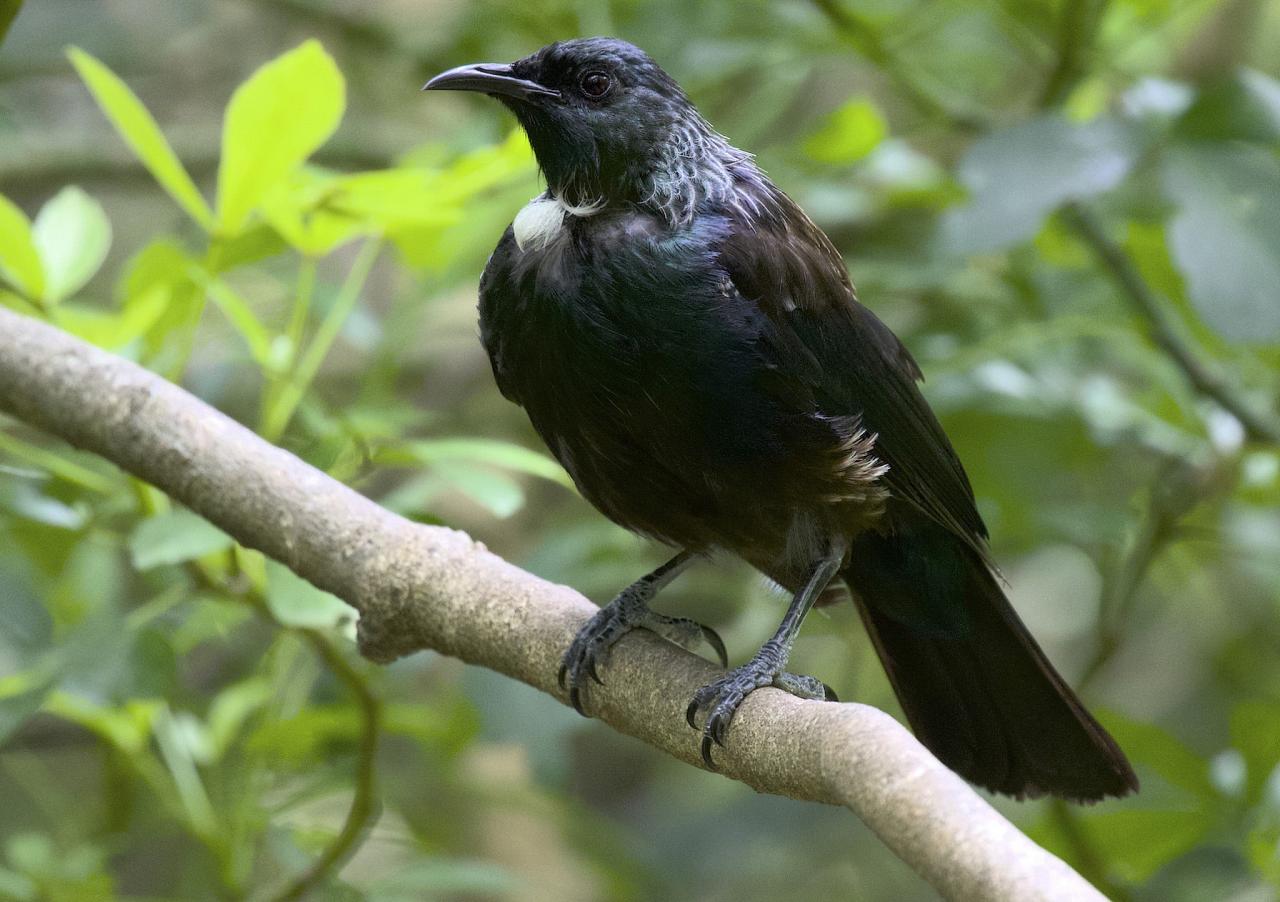
Tui by Greg Smith
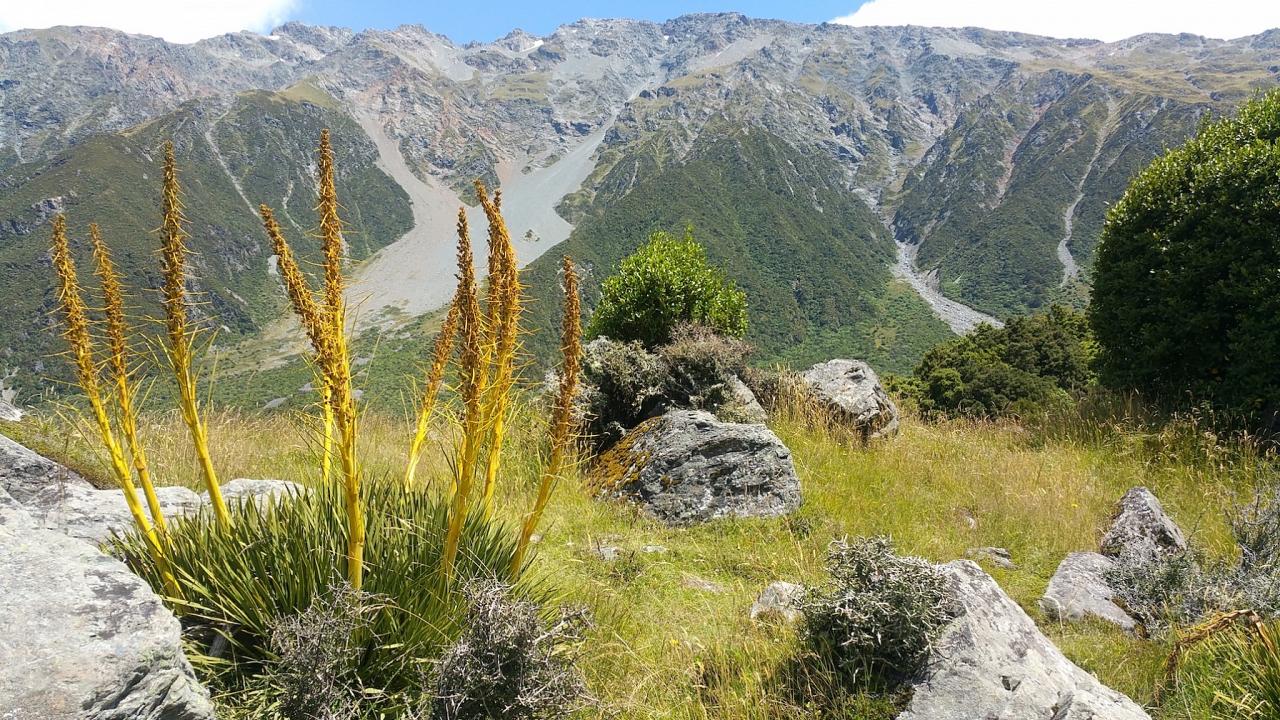
Spanish Grass by Greg Smith
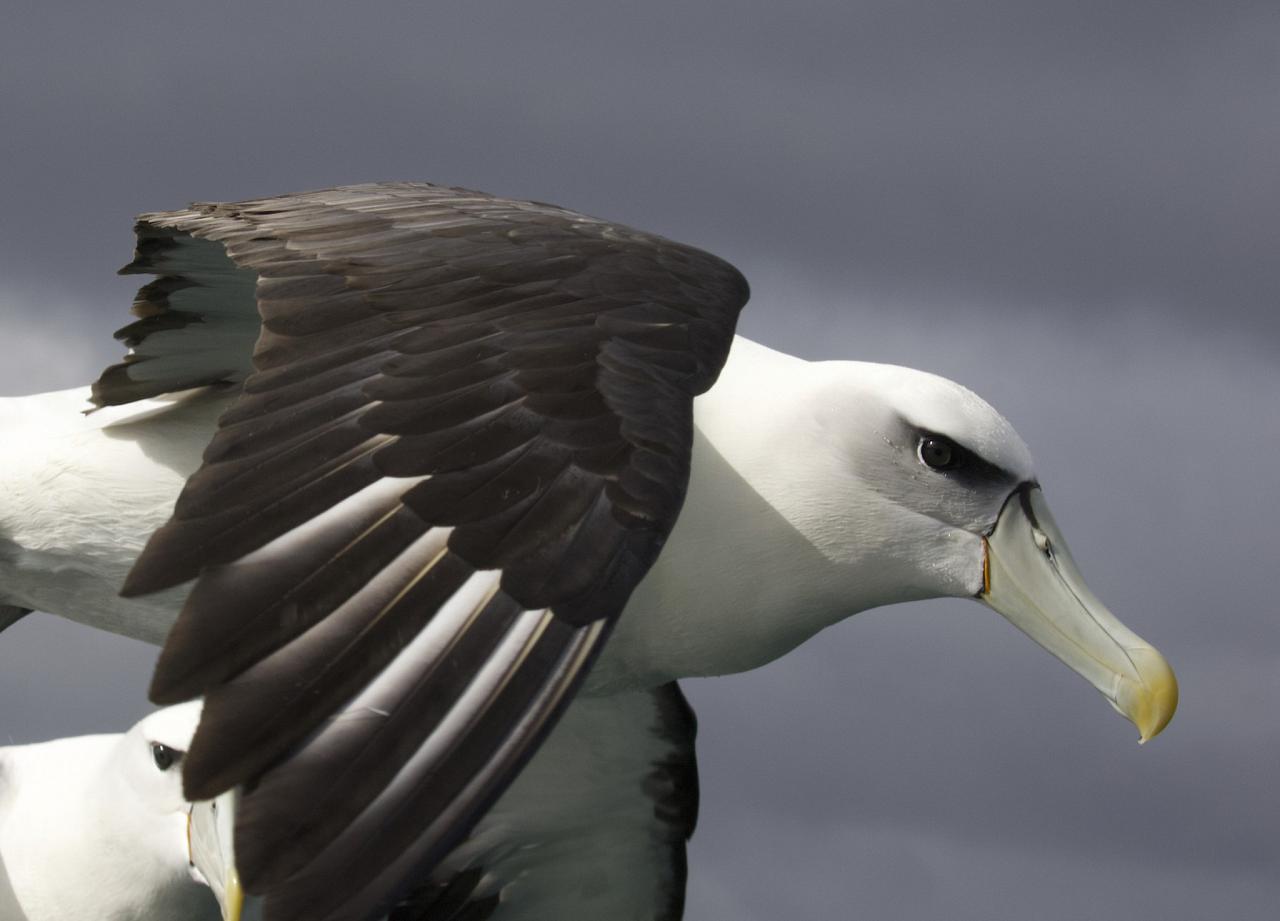
White-capped Albatross by Greg Smith
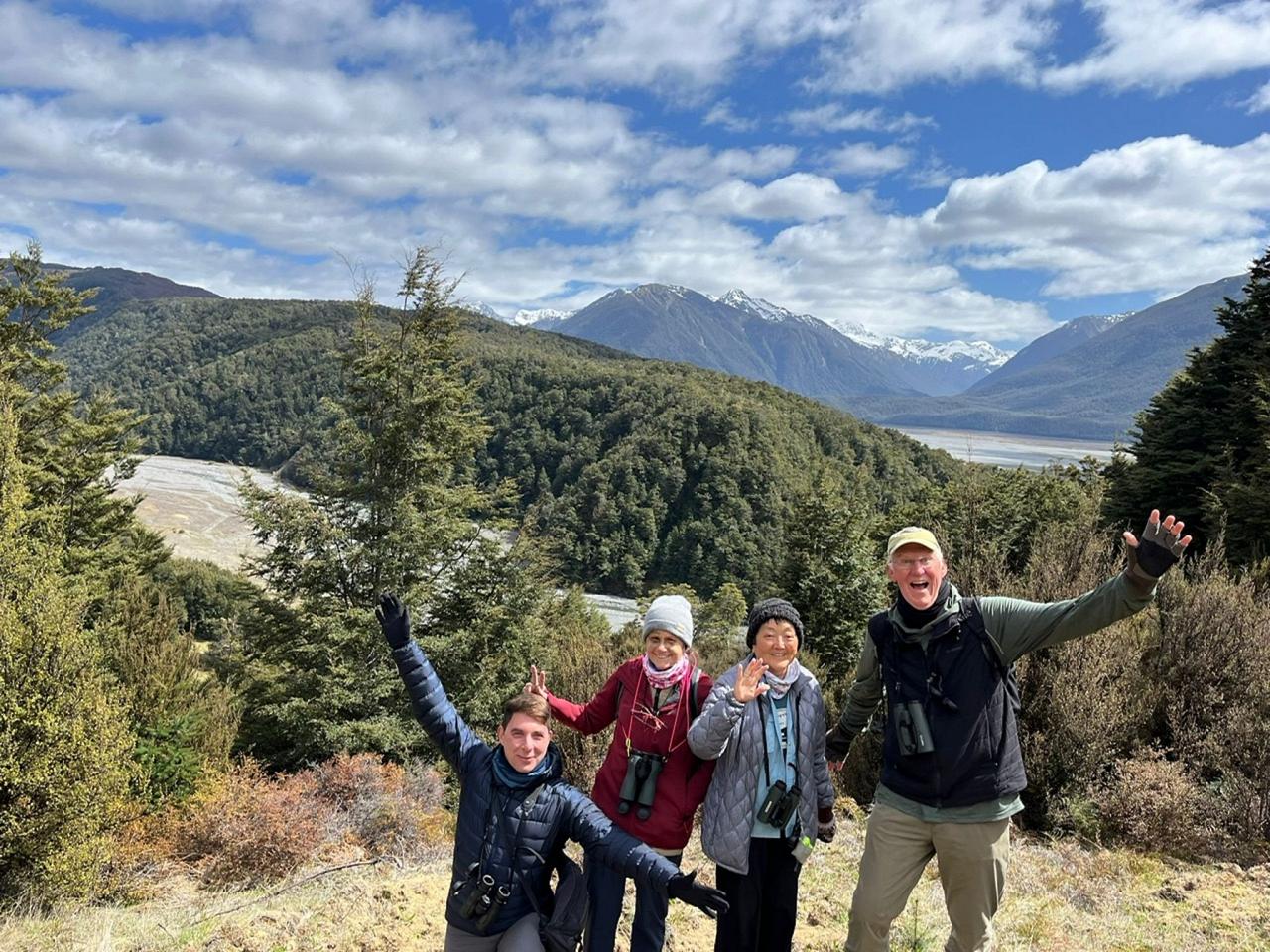
Group Near Mount Cook by Carlos Sanchez
Cost of the Journey
The cost of the main tour is per person based on occupancy: $8290 DBL / $9540 SGL , from Auckland, New Zealand. All pricing is calculated on the exchange rate on XE.com as of November 2022. If a significant shift in this rate occurs, we will need to adjust tour pricing accordingly, up to the time that final payment is made.
The tour cost includes all accommodations, most meals as specified in the itinerary (B=breakfast, L=Lunch, D= dinner), professional guide services, ferry and boat day-tour fees, park and program entrance fees and miscellaneous program expenses.
The cost of the extension is $2390 DBL / $2820 SGL; this does not include internal flights which are estimated at $500.
IMPORTANT NOTE FOR THOSE JOINING THE PRE-TOUR EXTENSION: You will need to book a flight from New Caledonia (NOU) to Auckland (AKL) on Monday, October 7th to join the main tour. This flight is not included in the cost of the extension.
Tour does not include transportation from your home city to Auckland or from Dunedin back to your home city, arrival or departure airport transfers, optional activities such as horseback riding, scenic viewing plane rides, or fishing with a guide, or items of a personal nature such as laundry, luggage porterage, telephone charges, maid gratuities, or beverages from the bar.
Please plan to make air travel plans only after the minimum group size has been met. We will send you a confirmation email as soon as the trip has been confirmed.
Main Tour Arrival Airport: Auckland International Airport (AKL)
Main Tour Arrival Details: Please plan flights to arrive October 8, 2024, no later than 10:00 AM. We have a group lunch and afternoon outing on the first day of the tour.
Main Tour Departure Airport: Dunedin International Airport (DUD)
Main Tour Departure Details: Please plan flights to depart October 24, 2024 after 3:00 PM
Pre-Tour Arrival Airport: La Tontouta International Airport (NOU) in Noumea, New Caledonia
Pre-Tour Arrival Details: Please plan flights to arrive October 1, at your leisure. Note that you would likely have to leave the US on September 29 to get to Noumea on October 1.
Travel Tips: We recommend you arrive a day or two early to rest up from the long flight. You can book an early night at our first night tour hotel, the Grand Millenium Auckland . It’s easy to book online and you can send us the confirmation number, with the goal being you won’t have to switch rooms. Upon arrival at the airport, you can take a taxi to the hotel or book a Super Shuttle online ahead of time. If you want to explore the city a bit, the Auckland War Memorial Museum is located within the large Auckland Domain park and is a great place to learn about New Zealand history and culture. The city is very walkable and if you want to stretch your legs after the flight, the waterfront area is very nice and the Auckland Domain park has some great walking paths.
Entry Requirements: See Passport, Visa & Documentation section found under Know Before You Go / Essential Information .
Browse below for trip reports and species lists from past versions of this and other tours from this destination.
New Zealand
- Trip Report
- Species List
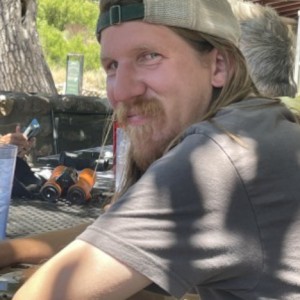
James grew up in New Jersey and started birding at a young age. He continued that passion by getting an undergraduate degree in Wildlife Ecology from the University of Maine. Since then, he has worked and birded extensively across the United States, including conducting point counts and banding ducks in Maine; identifying and counting waterfowl in Nebraska; counting migrating raptors in Texas, Arizona and Wyoming; and surveying for Northern Goshawks in northern California. The past three springs he has been a bird guide in the Chiricahua mountains in southeast Arizona, and he enjoys sharing his passion for birds with others. His favorite bird is the Red-headed Woodpecker.
Other trips with James Petersen
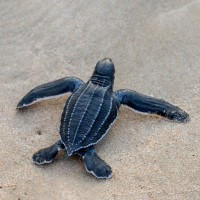
Essential Information +
This information is important for being prepared for your journey; we want you to have the best experience possible. If you only read one section, this one is key!
Ahead of Your Tour
- For New Zealand main tour, make sure your passport will be valid at least three months after the date of your scheduled return to the U.S . Exception: **For New Caledonia pre-tour extension participants , passports must be valid at least SIX months after the date of return to US.
- For New Caledonia pre-tour extension, a visa is not required for stays of this length.
- At the time of writing, all travelers to New Zealand need to complete and submit a New Zealand traveler declaration (NZTD) and receive a Traveller Pass prior to departure.
- U.S. citizens traveling to or transiting through New Zealand under the visa waiver program are required to request a New Zealand Electronic Travel Authority (NZeTA) . See "Passport, Visa & Documents" section below.
- Please check current recommendations from the Centers for Disease Control and Prevention (CDC) and consult with your doctor about general travel vaccinations you should have as precaution for travel. See the “General Health and Inoculations” section below for more detailed information.
- Travel insurance in case of serious medical emergency is strongly recommended. Full health coverage and repatriation is available through Allianz Travel Insurance .
- Plan your flight reservations arriving into Auckland International Airport (AKL). Departing from Dunedin International Airport (DUD). Send a copy of your itinerary to the Naturalist Journeys office please. **For participants in pre-tour extention to New Caledonia, see Travel Details tab for airport information.
- Soft sided luggage/duffel bags are easiest for packing the vans. Pack essential medications in your carry-on luggage, as well as one day of clothing and optics in case of luggage delay.
Main tour Arrival into Auckland International Airport (AKL)
Please note: If you are delayed in travel, please refer to your emergency contact list, and contact our New Zealand operator with a backup call to our office. Both numbers are found on the contact list provided.
Your arrival airport is Auckland International Airport (AKL). Please arrive by the morning of the first day of your tour in time for a group lunch.
We recommend coming in a day or two early to adjust to the time change and be well rested for the start of the tour.
Please send us your flight ARRIVAL and DEPARTURE information, and /or a request for an additional night at the Grand Millennium Auckland or the name and phone of the hotel you will use the night prior. Once we have everyone’s flight details, we will let you know if anyone else is on your flight.
Plan to taxi to the hotel - this is easy to do from the airport. Our arrivals are too scattered to arrange for a group transfer and as this is an English-speaking modern country, there are no issues with using taxis.
Please check the Travel Details section of this tour for additional information and updates, including airport information for pre-tour excursion to New Caledonia.
Departures from Dunedin International Airport (DUD)
Please plan flights out of Dunedin at your leisure after 1 PM, allowing time for your international connection. Alternatively, Dunedin is delightful and many choose to stay on there, making return flights accordingly. If you need to stay an extra night in Auckland, we can help you book accommodations near the airport for an extra cost. Transfers to the Dunedin International Airport will be provided.
Please check the Travel Details section of this tour for additional information and updates.
Passports, Visas & Documents
Guidelines and regulations can change. It is always advisable to double-check the country’s documentation requirements 60-90 days ahead of traveling. Information for U.S. citizens traveling to New Zealand can be found at: https://travel.state.gov/content/travel/en/international-travel/International-Travel-Country-Information-Pages/NewZealand.html . If you are taking the pre-tour extension to New Caledonia , information can be found at: https://travel.state.gov/content/travel/en/international-travel/International-Travel-Country-Information-Pages/NewCaledonia.html . If you are from another country, please contact the New Zealand embassy website for guidelines.
- For New Zealand main tour, you must have a passport that is in good condition and is valid for at least three (3) months AFTER your scheduled return to the U.S. Exception: If you are taking the pre-tour extension to New Caledonia, you must have a passport that is in good condition and is valid for at least SIX (6) months AFTER your scheduled return to the U.S. Make sure your passport's expiration date meets or exceeds the qualifications above that apply to your initial destination!!
- You should have at least one blank page per stamp. The blank pages need to say “Visas” at the top. Pages marked “Amendments and Endorsements” will not be accepted.
New Zealand Electronic Travel Authority (NZeTA)
- U.S. citizens traveling to or transiting through New Zealand under the visa waiver program are required to have an NZeTA .
- It can take up to 72 hours to process an NZeTA so apply well in advance of your trip. The NZeTA is valid for multiple visits for up to two years.
- Information about : NZeTA | Immigration New Zealand
- NZeTA application - request an NZeTA | Immigration New Zealand
- If your NZeTA application is denied, you will need to apply for a visa. Visit the Embassy of New Zealand website for the most current visa information.
Traveler Declaration (NZTD)
- Travelers to New Zealand by air will be required to complete and submit* a New Zealand traveler declaration (NZTD) and receive a Traveler Pass prior to departure.
- The NZTD collects and assesses a person’s travel-related information, such as passport details, contact details in New Zealand (if staying in multiple locations, use the first address you will be at in New Zealand), travel history from the last 30 days, flight details, information about what you are bringing into New Zealand, including checked-in luggage and carry-on bags, immigration status including your visa or NZeTA, if you need one.
- The NZeTD is an online system. Once you start your digital declaration, you will get an email with a reference number. You can use this to make any changes up until you reach passport control in New Zealand.
- Once you have submitted your declaration, you will receive an email that includes information on what you need to know to enter New Zealand, based on what you have told them.
- You will need to resubmit your declaration if you make any changes to it. You do not need to print anything out.?Your New Zealand Traveller Declaration will automatically be checked when your passport is scanned at the eGate or by a border officer.
- Go to https://www.travellerdeclaration.govt.nz/ for more information or to start filling in your digital declaration.
As a precaution for lost or misplaced documents you carry on your person during travel, we highly recommend you keep hard and digital backup copies on your phone (either photo or PDF scan), as well as a hard copy left with your emergency contact at home. The recommended important documents to copy include, but are not limited to; your passport ID page, travel visa, the front and back of your credit card(s), the airline barcode on your luggage. This will greatly expedite getting new ones if necessary – we hope everyone will always keep travel documents close so that losing them will not be an issue.
General Health & Inoculations Information – Be Prepared!
Health requirements for entry to any country can change. It is always advisable to double-check the country’s health requirements and recommendations 60-90 days ahead of traveling. A helpful website for planning is the CDC's website for New Zealand (Also, CDC's website for New Caledonia for pre-tour extension participants) or by phone (800) CDC-INFO or (800) 232-4636.
We will share your health information with your guide. This information will be kept confidential but is very important as we want to be best prepared in case of medical emergency.
Vaccinations: Bring copies of your current vaccination records with you. There are no required vaccinations to enter New Zealand (or New Caledonia pre-tour extension), however, the CDC recommends that all travelers be up to date with routine as well as basic travel vaccinations before traveling to any destination. Please consult with your doctor for recommendations at least 4-6 weeks before departing on your trip. He or she may recommend preventative immunizations like DTaP (Diphtheria, Tetanus and Pertussis), which is recommended every 10 years.
Prescriptions: It is a good idea to pack any meds you take regularly in your carry-on luggage. Bring an extra pair of glasses or contact lenses. Bring an adequate supply of any prescription medications you use, a copy of the prescription and a list of generic names of your medicines as “back-up” in case it is necessary to purchase drugs while abroad. You’ll want to keep medications in their original, labeled containers.
Allergies: To be prepared for environmental triggers to allergies or breathing difficulties, please bring your allergy and/or asthma medication(s). If you have severe allergies talk to your doctor about carrying an EPI pen and notify your guides. It is also recommended to carry with you an up-to-date record of known allergies, chronic medical problems and Medic Alerts so that, if necessary, emergency treatment can be carried out without endangering your health.
Common Ailments: We recommend that you bring a travel-sized first aid kit and a supply of standard over-the-counter medications for prevention or treatment of common ailments (such as diarrhea, constipation, stomach upset, cough, congestion, head or body aches, insect bites and sunburn); as well as ointments, moisturizer, sunscreen, oral rehydration salts, band-aids, moleskin for blisters, cotton swabs, nail clippers, and tweezers, etc.
Altitude illness: According to the CDC's website, day trips to high-elevation destinations less than 8000 ft. with an evening return to a lower elevation are much less stressful on the body, depending on the time provided for your body to adjust. However, overnights at high altitudes may have more adverse affects on your body and you should be informed about altitude illness and Acute Mountain Sickness (AMS) (see https://wwwnc.cdc.gov/travel/yellowbook/2024/environmental-hazards-risks/high-elevation-travel-and-altitude-illness ). The most general symptoms are headache and occasionally fatigue and dizziness. You’ll want to take it easy, particularly at first. The likelihood of these symptoms can be reduced by resting, drinking plenty of water, avoiding alcohol, taking aspirin and optimize acclimatization by adjusting itineraries to avoid going “too high too fast." If you have worries about the altitude, ask your physician about medications (such as Diamox) that may be right for you.
New Zealand is a modern nation with excellent sanitation; travel poses few health concerns. Water is safe to drink. Bring a first aid kit and medications for common ailments. The internal parasite Giardia does occur in New Zealand, so do not be tempted to drink from wilderness streams.
Weather & Climate
Spring in New Zealand falls between September and November and weather is highly variable. Overall, temperatures are moderate but can be a bit cool in the evenings, even cold in the south. Daytime temperatures are most commonly in the 50s and 60s °F and rain is likely. It will be chilly and moist on the water, and mountain temperatures can be cold and windy. Visit https://www.climatestotravel.com for an overview.
Annoyances & Hazards
Mosquitoes can be found in New Zealand, as well as biting sand flies in mountain and coastal environments. There are no snakes or dangerous animals, making outdoor activities safe for visitors. Bring insect repellent, and consider lightweight, long-sleeved clothing. The sun can be strong, so plan to protect yourself against it.
Food & Drinks
We stop at convenience stores for our rest stops while traveling, and lodges have potable water to fill up your water bottle. Beer and wine are readily available for purchase at hotels, and we can stop to purchase liquor if needed. We can also stop for snacks and supplies; your guide shops for picnic lunches en route. Sometimes it’s just fun to see what markets carry!
Packing, Clothing & Laundry
Dress is very informal and laundry services are available for a fee at our lodges. While some people will change for dinner, it is usually just to a drier or cleaner version of what they wore during the day.
Please, pack light. We are serious about this – we move around a lot; you just do not need much to cope with tropical life! Please do not bring anything more than you must. Lay out your hopeful things to take and then do a serious paring down please!
Laundry services are generally available, but easiest if we have several days in one location. There is a full, complimentary laundry facility with washers and dryers at the Wilderness Lodge at Arthur's Pass, conveniently half-way through our itinerary.
TRAVEL TIP: Imagine NOT getting your suitcase. Wear your most important shoes for the field and have one change of clothing in your carry-on (including a change of underwear)! And please, do not pack any essential medications, or your vital optics, in your checked luggage!
Spending Money
It is always wise to inform your bank about your travel plans to prevent potential card blocks or suspicions of fraud when making overseas card payments.
Pre-tour extension to New Caledonia: The local currency is the Franc Pacifique, or Franc CFP (FCFP or XPF), pegged to the Euro. Other currencies, such as the dollar or pound, are subject to international exchange rates. Unlike the Euro zone, which uses both Euros and Euro cents, New Caledonia exclusively uses the Franc. Retailers widely accept VISA, Mastercard and AMEX credit cards (AMEX cash withdrawals are not available), however it is wise to carry some cash when visiting rural areas. Travelers checks are no longer accepted by banks in the territory.
New Zealand uses the New Zealand dollar. For the current exchange rate, please refer to online converter tool like www.xe.com , or your bank. You will be able to change money after your arrival. Travelex, at airports, is a cost-effective source. It is advisable to take some of the money in smaller bills for local shopping. We advise you carry a mix of different types of payments, such as the cash, an ATM card, and a credit card. Make sure you know your ATM PIN number. You should also inform your bank and your credit card companies that you will be traveling outside the country to avoid a freeze on your account – many banks do this as a security measure when unexpected purchases are made. If you want to withdraw cash while in New Zealand, debit cards are more cost-effective than credit cards which can charge high fees. If you plan to exchange cash in country, bring large U.S. bill ($50 or $100) in good condition that will give you the better rate when exchanging to local currency.
People often ask how much spending money to bring. Part of the answer depends on how much you want to shop. Tempting souvenirs are endless, and most shops take VISA and MasterCard or American Express. You may also want to bring cash for drinks with dinner (if available) or smaller local purchases.
Also, a number of meals are on your own – you pay for these yourself (these meals are marked on your itinerary). In most cases you can choose from a variety of restaurants.
For pre-tour extension to New Caledonia: Tipping is not a common practice in the region. Prices typically include service tax (TSS), usually set at 5%, with few exceptions. Your local guides may provide you with more detailed information.
Gratuities are not customary in New Zealand but occasionally may be appropriate. Tipping throughout the tour is at your discretion. Some general gratuity guidelines follow.
- At larger (mostly city) hotels, tip maids and bar service as you would at home.
- At eco-lodges, there is typically a staff tip box in a public area; the going rate per person is $6-$10 a day, which is shared among staff for maid service, and general staff service at the lodges. Gratuities for group meals are already included.
- Your Naturalist Journeys host will take care of smaller tips such field trip services by boat drivers, night drive outings, single activities. Your additional tip is encouraged for birding tour guides and drivers who are with you for several days or the full trip; $10-$15 per day per guest is standard for guide service, and half that for a driver. If you have more than one local guide at a location, they will share the daily amount.
We encourage tipping for the local teams hosting you; anything extra for your Naturalist Journeys host is at your discretion.
Cell Phones & Internet Service
Your guide is well connected and can help if any urgent communication need arises. However, it is highly recommended that you travel with a cell phone, if only as a precaution for the unfortunate occurrence of a medical emergency during an outing and needing swift accessibility to critical personal or medical contacts.
Please check with your wireless provider to see if your phone and service will work in your destination country. Options include activating international roaming, purchasing a local SIM card at the airport (newer phones may not accept SIM cards), or simply turning off cellular service and relying on Wi-Fi to make calls and access the internet.
If your phone can connect to Wi-Fi, you may be able to make voice and video calls free of charge. Please contact your cell phone provider for further details. Another option if you have access to Wi-Fi, is to use smartphone apps like Skype, WhatsApp, or Viber to send text messages, and make voice calls, or video calls. Many smartphones, tablets, or laptops come with one of these apps pre-installed or you can download for free. If bringing a laptop or tablet, get a good dustcover to protect it at all times.
Make sure if you do NOT want to use your cell phone that you turn off your cellular data. You could incur huge charges if you are not on Wi-Fi. Putting your phone in airplane mode if you mainly use it for photos will save the battery as well.
Please refrain from taking or making cell phone calls in the vehicles when traveling with other passengers, unless it appears to be an emergency. This disrupts other guests, plan on cell phone call use on your own time.
Electricity
For those joining the pre-tour extension to New Caledonia , the standard voltage is 220 V at a frequency of 50 Hz. Power plugs and sockets (outlets) of Type F are used. For more information, see https://www.power-plugs-sockets.com/new-caledonia/ .
The standard in New Zealand is 230 Volts at 50 Hertz. The power plugs and sockets are of Type I. For more information, see https://www.power-plugs-sockets.com/new-zealand/ .
If you travel with a device that does not accept either of these voltages and frequencies (220V/50Hz or 230V/50Hz), you will need a voltage converter. Depending on how much you plan to travel in the future, it may be worthwhile to get a combination voltage converter and plug adapter. More information can be found at www.power-plugs-sockets.com
New Zealand is on New Zealand Standard Time (GMT+12), with daylight savings time. Time in Auckland is 16 hours ahead of New York City. Check www.timeanddate.com before leaving home for your conversion.
Please contact Naturalist Journeys by email at [email protected] or telephone at our office: (520) 558-1146 or toll free: (866) 900-1146 if you have any questions. Many thanks for traveling with us and we hope you enjoy your journey!
Pace & Protocols +
Pace of the tour & what to expect.
You will receive a Schedule-at-a-Glance and list of hotels (our eContact List) a few weeks before your departure. This will serve as an outline for each day and alert you to any recent changes made in the schedule or to our hotels, if needed.
Our journeys are set up to follow the rhythm of nature. Our focus is on birding and nature; we offer full, well-planned field days and often get up early for that magical time around dawn. We generally follow the published itinerary, but we stay flexible to the weather, wildlife opportunities and the interests of the group. Your guide will keep you apprised of the next day’s schedule at each evening meal, noting what to bring and what to prepare for. Questions and/or concerns are welcome.
The pace of our Naturalist Journeys tours is moderate; to fully participate you should be able to get in and out of vehicles several times a day, and walk 1-3 miles over uneven terrain. It is important to participate with a flexible attitude as adjustments may be made in our schedule to make the most of our time in the field or for other purposes at your guide's discretion. We are not a “listing” bird company that drills down on target species, but at times we do wait for those special species unique to the places we visit. During the day, we take time to stop for photos and for educational opportunities to learn about conservation projects, landscapes, and geology. We appreciate other taxa as well as birds, with mammals often the biggest draw but plants and butterflies are also very popular. Our clients often lend their own expertise to the mix.
We like to make meals a fun and memorable part of the experience, too. Breakfasts are often at hotels, and we carry snacks, fruit, and water in the vans each day. Lunches are a mix of picnics in the field (weather dependent) and a chance to dine with locals at small cafes and restaurants. For dinner, we pride ourselves in our homework to keep up with the best choices for dining, choosing restaurants with atmosphere that specialize in local foods. On occasion we keep dinner simple to go back out in the field for sunset wildlife viewing or night walks. In some remote locations, our choices are limited. If you are tired, room service for dinner may be an option you can choose.
Naturalist Journeys International Trips: Guide Role
Naturalist Journeys supports ecotourism and the development of excellent local guides. Once we know our international partners and guides well, we can send out small groups working directly with these trusted partners, adding a Naturalist Journeys guide to assist the local expert when we have a group of 6-7 or more. This helps us keep your costs down while retaining tour quality. The local guide is your main guide. You can expect your Naturalist Journeys guide to be well-researched and often they are experienced in the destination, but their role is not to be primary, it is to help to organize logistics, help you find birds, mammals, and interesting other species in the field, keep reports, help facilitate group interactions, and to keep the trip within Naturalist Journeys' style. Local guides live in the countries we travel to, know the destinations intimately, and are often the strongest force for conservation in their countries. They open many doors for us to have a rich experience.
Smoking is not permitted in any vehicle or in any situation where the group is participating in an activity together, such as a vehicle excursion or a guided walk. Please respect all designated smoking areas at hotels and restaurants.
Transportation
As a courtesy to each other, we ask that all travelers please rotate seating. On international trips we may all be in one small bus, on some trips we are in vans, particularly the roomy Sprinter Vans when available. Some areas require us to be in smaller 4-wheel drive or safari vehicles. Rotation allows you to sit with different drivers and alternate front and back seating.
Photo Release & Sharing
We take many group photos and will share photos with the group. And after your tour, we will organize a chance to share photos via Dropbox or Google Photos. Please note that this is our policy and if you prefer to be excluded, we need to know ahead of your tour.
By registering for this tour, you agree to grant to Naturalist Journeys and its authorized representatives’ permission to record on photography film and/or video, pictures of my participation in the tour. You further agree that any or all of the material photographed may be used, in any form, as part of any future publications, brochure, or other printed materials used to promote Naturalist Journeys, and further that such use shall be without payment of fees, royalties, special credit or other compensation.
Travel Insurance
You are traveling in remote areas. Naturalist Journeys strongly recommends you have full medical and evacuation insurance from a company such as Allianz , for all international travel. If you do not have medical coverage or evacuation coverage on your existing travel insurance policy or for some reason elected not to take that out, we advise getting an evacuation plan with Global Rescue , World Nomads , Medjet , Allianz (they can do evacuation only) or a similar company. These plans are typically $300-$400 for a year for multiple destinations. This coverage may be a part of a larger Travel Insurance policy but can also be purchased on its own.
Please contact Naturalist Journeys by email at [email protected] or telephone our office: (520) 558-1146 or toll free: (866) 900-1146 if you have any questions. Many thanks for traveling with us and we hope you enjoy your journey.
Packing List +
Please pack light.
Please reconfirm your airline’s baggage weight and size restrictions about a week or so before departure.
Luggage: Soft luggage is much easier for us to pack than a more rigid hard sided piece, so if you have the choice, please use your soft luggage. Be sure to have your name and address on the inside of the bag, as well as on the luggage tag on the handle. It is our hope that you can pack in one checked suitcase that does not exceed 45 pounds. If lighter, all the better!
Carry-On: Be sure to pack your personal medication, airline tickets, passport, binoculars, camera, and other essential items in your carry-on bag. You will want a day pack for field trips, so this is an ideal carry-on.
Weather & General Guidelines
Spring temperatures will range from highs of 65°F and lows of 40°F and you will encounter rain. T emperatures may vary considerably throughout the areas you will be visiting (inland versus coast and for day and night excursions). In general, moderate rainfall occurs all months of the year, along with lengthy times of sunny weather. Weather is milder on the North Island compared to the South Island.
North Island: The northern region and its eastern coast is typically sunnier and drier than the southern half of New Zealand, but there can still be plenty of rain. Temperatures will gradually become cooler the closer you get to the second major island.
South Island: The South Island has been known for its variable weather swings. The locals would say you could experience all four seasons in one day. It’s common to start the day as sunny, then encounter rain, which can then strengthen into snow, then end in stunning sunshine.
Clothing & Gear
Please be prepared for all types of weather. Bring a waterproof, insulated jacket with a hood, gloves, sweater, and waterproof shoes. Since very warm weather is similarly promising, your outerwear should be big enough to wear over other layers.
Dress is comfortable and informal throughout the trip. Dressing in layers is the best way to be comfortable. We are on the water and in the mountains where temperatures and winds can fluctuate drastically; a waterproof, wind-resistant layer is smart. Lightweight long-sleeved shirts and long pants make ideal field clothing as they are more protective from sun and vegetation. But if you like to wear shorts, by all means bring them. Also, choose clothing you don’t mind getting dirty or muddy and things that are easy to launder. Closed toe shoes and hiking boots are ideal for our field time.
Note on clothing colors and insect repellent: We recommend muted colors of tan, brown, khaki, grey or green, as they are spotted less easily than white or bright colors, though camouflage clothing is not recommended. It is possible to purchase field clothing permeated with insect repellent such as the Craghoppers Insect Shield collection . Another approach is to purchase Permethrin spray (online or from REI) to treat your field clothing and socks before your departure.
Packing List:
- Long pants, 2 – 3 pairs (comfortable and loose fitting is best)
- Thicker pair of pants for cold nights
- Lightweight long underwear/ or fleece tights that can layer with rain pants
- Shorts or zip-off/convertible pants (optional)
- Lightweight long-sleeved shirts – 2 or 3
- T-shirts or equivalent, 3 - 4 (remember you may buy some souvenir tees along the way!)
- Personal underclothing and pajamas
- Socks (easy to hand wash and dry)
- Raincoat or poncho (great if this doubles as a windbreaker)
- Rain pants (HIGHLY RECOMMENDED)
- Comfortable evening clothes (clean field clothes are appropriate, but feel free to go dressier if you wish)
- Bathing suit (optional)
- Broad-brimmed hat
- Comfortable walking shoes (tennis shoes, etc.)
- Lightweight hiking boots (preferably waterproof with good ankle support and non-slip soles)
- Comfortable light shoes for evenings, travel days (Crocs work well or sandals)
- Warm jacket: fleece fabric is ideal, but a sweatshirt or sweater will do
- Wind/waterproof gloves – for night spotting
- Warm windproof hat – for night spotting
- Field vest (optional): a great source is Big Pockets
Equipment & Miscellaneous
- E-ticket verification
- Passport, visa (if required), travel insurance info, money & credit cards.
- A secure pouch to carry the items above on your person at all times (such as a secure, under-clothing document pouch)
- As a backup: copies of all the above (phone and/or paper) packed in a separate location than on your person, plus a set given to your emergency contact at home as a backup. For passport, copy of the ID and entry stamp pages.
- Small daypack to carry gear while hiking
- Cell phone and charger
- Camera and charger/extra batteries, memory cards/film, lens cleaning supplies and instruction manual (optional)
- Spotting scope and tripod (optional – guide will have them)
- Tablet/laptop for personal use and/or transferring photos, USB stick, USB cord and charger (optional)
- Power plug adapter & electrical transformer (New Zealand uses a unique three-pronged plug on a 250v system)
- Small flashlight or headlamp with fresh batteries
- Alarm clock (or use your cell phone)
- Sunscreen/lip balm with high SPF
- Sunglasses with neck strap
- Insect repellent with DEET
- Toilet articles
- Water bottle (or you can use one of ours and refill during the journey – we do try to save on plastics!)
- Walking sticks if you use them regularly, collapsible poles work well
- Umbrella (optional)
- Notebook and pen or journal (optional)
- Field guides (optional)
- Earplugs (if hotel noise or roommates snoring may bother you; optional)
- Rechargeable power bank (optional)
- Hand-washing laundry kit: large zip-lock bag and/or sink stopper that stopper that fits all sizes, cold water detergent, short piece of clothesline
- Washcloth (optional – not always provided in hotels)
WE DO NOT RECOMMEND TRAVELING WITH PRECIOUS OR VALUABLE JEWELRY – don’t tempt anyone and don’t bring things you’d regret losing, and your mind will be at ease!
Medical & First Aid Items
- Heath insurance and vaccination records (kept in personal pouch with other travel documents)
- Personal prescription medications (and copy of vital prescriptions)
- Motion sickness preventatives if likely to be needed on bus, van drives, the ferry ride, etc.
- Personal first aid kit and over the counter medications for general ailments (Imodium or Lomotil, packed in their original packaging
- Antihistamine cream or tablets, eye drops, etc.)
- Copy of eyeglass prescription, medical prescriptions, and any medical alerts
- Extra pair of eyeglasses or contacts
- Band-aids, moleskin to protect against blisters
- Small bottle of hand sanitizer
Suggested Reading List +
There are many titles of interest for New Zealand. The following are a few that we have enjoyed that can get you started.
A Field Guide to the Birds of New Zealand
Merlin App – New Zealand Pack . A phone-based birding app from Cornell University Laboratory of Ornithology. Before departing the U.S., download the app for free , then from within the app, download the “pack” for New Zealand.
New Zealand – Culture Smart!: The Essential Guide to Customs & Culture
The Hand Guide to the Birds of New Zealand
Birds of New Zealand and the Outlying Islands
Collins Field Guide to New Zealand Wildlife
Field Guide to the Wildlife of New Zealand
Reed Field Guide to New Zealand Trees
A Photographic Guide to Wildflowers of New Zealand
The Field Guide to New Zealand Geology
Birds of New Zealand app in the Apple App Store. An interactive version of the newly released Birds of New Zealand: A Photographic Guide
Natural History
New Zealand: A Natural History
Moa: The Life and Death of New Zealand’s Legendary Bird
History & Culture
Lonely Planet New Zealand by Lonely Planet
Insight Guides New Zealand by Insight Guides
A Concise History of New Zealand
A Traveller’s History of New Zealand and the South Pacific Islands
Come On Shore and We Will Kill and Eat You All
Straying from the Flock; Travels in New Zealand
Making Peoples: A History of the New Zealanders, from Polynesian Settlement to the End of the Nineteenth Century
The Bone People: A Novel
There is a good selection of books available for sale at visitors’ centers, and your guide will also have a selection of reference books and materials for participants to share. As an Amazon Associate, Naturalist Journeys earns from qualifying purchases, and may get commissions for purchases made through links on this page at no added cost to you.
Useful Links +
New Zealand – Encyclopedic Overview
- https://en.wikipedia.org/wiki/New_Zealand
New Zealand - A lively and colorful resource
- https://www.newzealand.com/us/
- https://en.wikipedia.org/wiki/Auckland
Nature, Wildlife & Biology
- https://www.birdingnz.co.nz/
Ornithological Society of New Zealand
- https://nzbirdsonline.org.nz/osnz
Birds A – Z – New Zealand
- https://www.doc.govt.nz/nature/native-animals/birds/birds-a-z/
General Bird List, Including Extinct Birds
- https://en.wikipedia.org/wiki/List_of_birds_of_New_Zealand
Endemic Birds
- https://en.wikipedia.org/wiki/List_of_endemic_birds_of_New_Zealand
New Zealand Storm-Petrel – Critically Endangered
- https://ebird.org/species/nezstp1
Birds of Prey - Be sure to read the “full story”
- https://teara.govt.nz/en/birds-of-prey
Flightless Birds
- https://teara.govt.nz/en/land-birds-overview/page-3
- https://www.terranature.org/flightlessBirds.htm
Tiritiri Matangi Island
- https://en.wikipedia.org/wiki/Tiritiri_Matangi_Island
Beech Forests of New Zealand
- https://www.doc.govt.nz/nature/native-plants/beech-forest/
Milford Sound Wildlife
- https://en.wikipedia.org/wiki/Milford_Sound#Wildlife
Native Animal Overview
- https://www.doc.govt.nz/nature/native-animals/
A profile of the endemic Hector’s Dolphin - WWF
- https://www.worldwildlife.org/species/hector-s-dolphin
Nature and Wildlife Overview
- https://www.newzealand.com/us/nature-and-wildlife/
Conservation, Parks & Reserves
Mount Cook National Park
- https://en.wikipedia.org/wiki/Aoraki_/_Mount_Cook_National_Park
Miranda Wildlife Sanctuary
- https://www.doc.govt.nz/nature/native-animals/birds/birds-a-z/mirandas-migratory-birds/
Pureora Forest Park
- https://www.doc.govt.nz/parks-and-recreation/places-to-go/waikato/places/pureora-forest-park/historic-pureora-forest-park/
Department of Conservation: A great, all-encompassing website with plenty of general (but thorough) wildlife information; a great site to pique your curiosity on topics to google further
- https://www.doc.govt.nz/
Kiwis for Kiwi
- https://savethekiwi.nz/
Pre-tour extension to New Caledonia
- https://www.conservation.org/blog/pacific-island-enacts-bold-new-ocean-protections
Geology & Geography
A Geologic History
- https://sci.waikato.ac.nz/evolution/geologicalHistory.shtml
Mount Ruapehu
- https://en.wikipedia.org/wiki/Mount_Ruapehu
Canterbury Plains
- https://en.wikipedia.org/wiki/Canterbury_Plains#Geology
Geography of Fiordland National Park
- https://en.wikipedia.org/wiki/Fiordland_National_Park#Geographical_features
"20 years on, a transformed New Zealand looks back at 'Lord of the Rings'" - L.A. Times Article by Kevin Baxter
- https://www.latimes.com/entertainment-arts/movies/story/2023-11-28/lord-of-the-rings-return-of-the-king-20th-oscars-new-zealand-film-industry
A concise historical summary, along with additional details
- https://teara.govt.nz/en/history
New Zealand History – Covering a wide variety of topics from culture to politics, and more
- https://nzhistory.govt.nz/
Helpful Travel Websites
Arrival - Auckland International Airport (AKL)
- https://www.aucklandairport.co.nz/
Departure - Dunedin Airport (DUD)
- https://www.dunedinairport.co.nz/
National Passport Information Center
- https://travel.state.gov/content/travel/en/passports.html
Homeland Security Real ID Act
- https://www.dhs.gov/real-id
U.S. Customs and Border Protection (CBP)
- https://www.cbp.gov/travel
Transportation Security Administration (TSA)
- https://www.tsa.gov
Foreign Exchange Rates
- https://www.xe.com/
ATM Locator
- https://www.visa.com/atmlocator/
- https://www.mastercard.us/en-us/personal/get-support/find-nearest-atm.html
U.S. Department of State International Travel Information – New Zealand
https://travel.state.gov/content/travel/en/international-travel/International-Travel-Country-Information-Pages/NewZealand.html
Center for Disease Control (CDC) – New Zealand
https://wwwnc.cdc.gov/travel/destinations/traveler/none/new-zealand
Canada Travel Advice and Advisories – New Zealand
- https://travel.gc.ca/destinations/new-zealand
Travel Health Pro (UK) – New Zealand
- https://travelhealthpro.org.uk/country/162/new-zealand
Electricity and Plugs – New Zealand
https://www.power-plugs-sockets.com/new-zealand/
Date, Time, and Holidays – New Zealand
- https://www.timeanddate.com/worldclock/new-zealand
- https://www.timeanddate.com/holidays/new-zealand/
Pre-tour extention to New Caledonia
- https://en.wikipedia.org/wiki/New_Caledonia
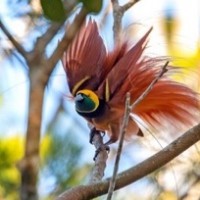
Photo credits: Banner: Mount Cook National Park, Greg Smith; Red-crowned Parakeet, Greg Smith; Lake Ohau, Greg Smith; Arthur's Pass, Peg Abbott; Salvin's Shy Albatross, Mark Hanger; Orakei Korako near Rotarua, Mark Hanger; Kea, Peg Abbott; Kiwi Crossing Sign near Arthur's Pass, Peg Abbott; Tui, Peg Abbot; Wild Spaniard Alpine in Mount Cook National Park, Mark Hanger; Hikers, Peg Abbott; Australasian Gannet, Greg Smith; Kaka, Greg Smith; Aoraki, Greg Smith; Red-crowned Parakeet, Greg Smith; Australasian Gannets, Greg Smith; Marlborough Sound, Greg Smith; Blue Duck, Greg Smith; Fantail, Greg Smith; Tui, Greg Smith; Spanish Grass, Greg Smith; White-capped Albatross, Greg Smith.
Like what we do?
Sign up for our weekly enews to stay up to date, get to know our favorite destinations each week. we promise no spam..
New Zealand - Comprehensive - ()
New zealand - comprehensive.
- Dates, Leaders and Pricing
- Trip Reports
- Tour Enquiry
New Zealand supports a host of unusual endemic land birds and a rich assemblage of marine birds and mammals. Our comprehensive tour is designed to seek almost every possible endemic and take full advantage of New Zealand’s oceanic diversity. Beginning in Auckland, we target North Island Brown Kiwi, amongst a multitude of other species that will no doubt be lifers. The first of our several pelagic excursions then takes place in the Hauraki Gulf in search of the recently rediscovered New Zealand Storm Petrel and a myriad of other species. Continuing to the fabled Tiritiri Matangi Island, we will bird this predator-free reserve for the prehistoric South Island Takahe, strange North Island Kokako and Stitchbird, before combing the Miranda shoreline for the bizarre Wrybill and numerous migrant waders. We finish our time on North Island visiting Kapiti Island searching for the endangered Little Spotted Kiwi, migrant Long-tailed Cuckoo and Tomtit.
Crossing onto South Island, our first stop is Blumine Island Bird Sanctuary, where the dazzling South Island Saddleback and New Zealand Robin will no doubt entertain us, before we embark on another pelagic adventure into the fantastic upwelling off Kaikoura, searching for an abundance of albatrosses, shearwaters and petrels. Travelling across South Island, we will seek the endemic flightless rail known as the Weka, as well as the critically endangered Black Stilt, before hiking through pristine Red Beech forest surrounded by breathtaking glacier-lined mountains, where Pipipi (Brown Creeper) and the massive Kea can be found. In Fiordland National Park our targets will include Blue Duck, the cute New Zealand Rockwren and New Zealand Falcon, before catching our ferry to the rugged Stewart Island in search of Southern Brown Kiwi and a variety of other specialities prior to another pelagic outing visiting several nearby islands. Our final destination will be Dunedin, where a visit to a Northern Royal Albatross colony and a Yellow-eyed Penguin breeding site will certainly be amongst the many highlights of this rewarding tour. With excellent lodging and meals, awe-inspiring scenery and fantastically friendly “Kiwis”, this is sure to be a tour of a lifetime!
Southern Brown, North Island Brown & Little Spotted Kiwis; Paradise Shelduck; Blue Duck; Brown Teal; New Zealand Scaup; Yellow-eyed, Fiordland & Little Penguins; New Zealand Storm Petrel; Wandering, Antipodean, Southern Royal, Northern Royal, Campbell, Shy, Salvin's & Buller's Albatrosses; Cook's, Westland & Black Petrels; Buller's & Hutton's Shearwater; New Zealand Grebe; Spotted, Rough-faced, Foveaux, Otago & Spotted Shags; Weka; South Island Takahe; South Island & Variable Oystercatchers; Black Stilt; Wrybill; New Zealand Plover; Black-billed Gull; White-fronted & Black-fronted Terns; New Zealand Pigeon; New Zealand Falcon; Kea; New Zealand Kaka; Yellow-crowned & Malherbe's Parakeets; Rifelman; New Zealand Rockwren; Tui; Grey Gerygone; North Island Kokako; North Island & South Island Saddlebacks; Stitchbird; Yellowhead; Whitehead; Pipipi; Tomtit; New Zealand Robin; New Zealand Fernbird; New Zealand Pipit.
Top Mammals
New Zealand Fur Seal; Hector's & Dusky Dolphins; Killer Whale
Habitats Covered
mudflats, estuary, river, pelagic, wetlands, islands, alpine grasslands, mountain beech forest, temperate rainforest
Expected Climate
subtropical to temperate. the south can get very cold. New Zealand often experiences four seasons in one day, so you should be prepared for sudden changes in weather and temperature.
Max Group Size
8 with 1 Rockjumper leader
Tour Pace & Walking
mostly very relaxed with some longer walks
Accommodation
very comfortable
Ease of Birding
mostly undemanding
Number of Species Expected
Photographic opportunities, what our clients say about us.

JP, New Zealand 2018
Beautiful country, good birding sites, good group of travelers. Eric Forsyth was an excellent guide, handling all situations very well, including weather-related activity cancellations that were beyond his control.
KB, New Zealand 2017
Erik Forsyth is not only extremely knowledgeable but also accommodating and fun.
JM, New Zealand 2018
Overall, a very good tour. Erik Forsyth got us onto all the most wanted birds and was attentive to everyone's needs. He was professional and kept the atmosphere fun and light.
RN, New Zealand 2017
The tour was well-planned and Erik Forsyth was an excellent leader. The accommodation, food and transportation were also excellent.
PP, New Zealand 2018
Erik Forsyth is not just totally knowledgeable about the birds, he makes the whole journey effortless and fun.
New Zealand - Comprehensive II 2024
22 Oct 2024 - 07 Nov 2024 (17 days)
NZD11,395 - No Spaces Available

Tour Leader: Erik Forsyth
Tour price (Per person): NZD11,395 * USD6,798 * GBP5,417 * EUR6,334 * AUD10,339
Single Supplement: NZD1,550 * USD925 * GBP737 * EUR862 * AUD1,406
New Zealand - Comprehensive III 2024
11 Nov 2024 - 27 Nov 2024 (17 days)
New Zealand - Comprehensive I 2025
07 Jan 2025 - 23 Jan 2025 (17 days)
NZD11,595 - No Spaces Available
Tour price (Per person): NZD11,595 * USD6,917 * GBP5,512 * EUR6,445 * AUD10,520
Single Supplement: NZD1,450 * USD865 * GBP689 * EUR806 * AUD1,316
New Zealand - Comprehensive II 2025
16 Oct 2025 - 01 Nov 2025 (17 days)
NZD11,595 - Spaces Available
New Zealand - Comprehensive III 2025
05 Nov 2025 - 21 Nov 2025 (17 days)
NZD11,595 - 2 Spaces Available
New Zealand - Comprehensive I 2024 - January 2024
New Zealand - South Island Endemics 2023 - December 2023
New Zealand - Comprehensive III 2023 - November 2023
New Zealand - Chatham Islands Extension II 2023 - November 2023
New Zealand - Comprehensive II 2023 - October 2023
Australia & New Zealand - Zhong 2023 - October 2023
Grand Pacific Odyssey - New Zealand to Japan 2023 - March 2023
New Zealand - Chatham Islands Extension I 2023 - January 2023
New Zealand - Comprehensive I 2023 - January 2023
New Zealand - Comprehensive III 2022 - November 2022
New Zealand - Comprehensive II 2022 - October 2022
New Zealand - Comprehensive I 2020 - January 2020
New Zealand - Comprehensive II 2019 - October 2019
New Zealand - Comprehensive III 2018 - November 2018
New Zealand - Comprehensive II 2018 - October 2018
New Zealand - Comprehensive I 2018 - January 2018
New Zealand - Comprehensive III 2017 - November 2017
New Zealand - Comprehensive II 2017 - October 2017
New Zealand - Comprehensive I 2017 - February 2017
ABA New Zealand - Subantarctic Island Cruise 2017 - January 2017
Your details
- Title Mr. Mrs. Ms. Dr. Prof. Sir.
- Name * First Last
- Your country Your country Afghanistan Albania Algeria American Samoa Andorra Angola Antigua and Barbuda Argentina Armenia Australia Austria Azerbaijan Bahamas Bahrain Bangladesh Barbados Belarus Belgium Belize Benin Bermuda Bhutan Bolivia Bosnia and Herzegovina Botswana Brazil Brunei Bulgaria Burkina Faso Burundi Cambodia Cameroon Canada Cape Verde Cayman Islands Central African Republic Chad Chile China Colombia Comoros Congo, Democratic Republic of the Congo, Republic of the Costa Rica Côte d'Ivoire Croatia Cuba Curaçao Cyprus Czech Republic Denmark Djibouti Dominica Dominican Republic East Timor Ecuador Egypt El Salvador Equatorial Guinea Eritrea Estonia Ethiopia Faroe Islands Fiji Finland France French Polynesia Gabon Gambia Georgia Germany Ghana Greece Greenland Grenada Guam Guatemala Guinea Guinea-Bissau Guyana Haiti Honduras Hong Kong Hungary Iceland India Indonesia Iran Iraq Ireland Israel Italy Jamaica Japan Jordan Kazakhstan Kenya Kiribati North Korea South Korea Kosovo Kuwait Kyrgyzstan Laos Latvia Lebanon Lesotho Liberia Libya Liechtenstein Lithuania Luxembourg Macedonia Madagascar Malawi Malaysia Maldives Mali Malta Marshall Islands Mauritania Mauritius Mexico Micronesia Moldova Monaco Mongolia Montenegro Morocco Mozambique Myanmar Namibia Nauru Nepal Netherlands New Zealand Nicaragua Niger Nigeria Northern Mariana Islands Norway Oman Pakistan Palau Palestine, State of Panama Papua New Guinea Paraguay Peru Philippines Poland Portugal Puerto Rico Qatar Romania Russia Rwanda Saint Kitts and Nevis Saint Lucia Saint Vincent and the Grenadines Samoa San Marino Sao Tome and Principe Saudi Arabia Senegal Serbia Seychelles Sierra Leone Singapore Sint Maarten Slovakia Slovenia Solomon Islands Somalia South Africa Spain Sri Lanka Sudan Sudan, South Suriname Swaziland Sweden Switzerland Syria Taiwan Tajikistan Tanzania Thailand Togo Tonga Trinidad and Tobago Tunisia Turkey Turkmenistan Tuvalu Uganda Ukraine United Arab Emirates United Kingdom United States Uruguay Uzbekistan Vanuatu Vatican City Venezuela Vietnam Virgin Islands, British Virgin Islands, U.S. Yemen Zambia Zimbabwe
- Hidden Tour of Interest
- Tour of Interest Select Tour of Interest New Zealand - Comprehensive II 2024 New Zealand - Comprehensive III 2024 New Zealand - Comprehensive I 2025 New Zealand - Comprehensive II 2025 New Zealand - Comprehensive III 2025
- Your Enquiry *
Contact permission
We would love to send you Newsletters (twice yearly).via Type a message, Promotions/Discounts (weekly), Blog Articles/Image of the Month (monthly) and other content that we think you would find interesting. If you are happy with this then please select your preferences below. If you would like to unsubscribe from previous subscriptions, or leave our mailing list entirely, then please do so by visiting the Preference Centre link at the bottom of these emails.
- Yes, I would like to receive this content of interest and to better filter the content sent to me, I am a :
- Hardcore (target focussed with a strong desire to see as many species as possible on each trip)
- Middle of the road (target focussed but more relaxed by nature and do not expect to see everything)
- Relaxed (enjoy birds but am happy seeing whatever we see)
- Photographer
- No thanks, I don't want to hear about any of these offers or content
- Name This field is for validation purposes and should be left unchanged.
Tour Route Map
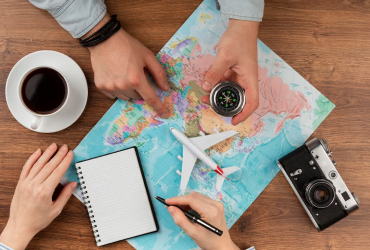
Get Special Offers From Rockjumper Birding
Sign up now and get the best deals straight in your inbox!
- Email This field is for validation purposes and should be left unchanged.
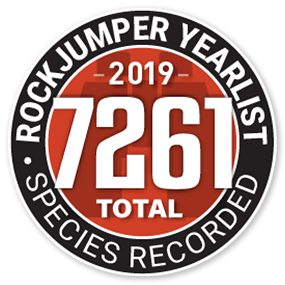
Modal title
Enquire about booking a tour.
- Tell us about your dream tour
- How many people do you expect to be on the tour? (optional)
- What are the date ranges you are looking at for this tour? (optional)
- How many days would you like the tour for? (optional)
- What is your price range for the tour? (optional)
- Comments This field is for validation purposes and should be left unchanged.
Enquire about booking a tour 5
Your passport.
Add Attachment
Arrival Tour Information
Departure tour information.

Roadrunner Birding Tours
We hit the ground running!
New Zealand | North, South and Stewart Islands

National bird
We will start in Auckland with travels through the North, South and Stewart Islands. Our tour will conclude in Dunedin.
December 5th – 21st 2024
Number of participants
Maximum of 8, plus one guide.
Description
Our guided tour departs from Auckland and ends in Dunedin and will visit some of New Zealand’s best birding locations, including Tiritiri Matangi, Kaikoura and Stewart Island (to name a few).
New Zealand is loaded with spectacular coastlines, mountains and most importantly for us – unique birds, such as Kiwi, Kea, Stitchbird and Wrybill! We will partake in both land-based and pelagic excursions to maximise our birding opportunities.
What species can be spotted?
New Zealand is home to a very diverse set of birds and some of the species to be encountered on our tours are: NZ grebe, Morepork, Wrybill (only bird worldwide with a laterally curved bill), Saddleback, Tui, Kaka, Kea, Weka, Whitehead, Yellowhead, Takahe, Spotted shag, Whio (blue duck), Paradise shelduck, NZ falcon, Black stilt, NZ plover, Fairy tern, NZ pigeon, Red-crowned kakariki (parakeet), Malherbe’s (Orange-fronted) parakeet, Rifleman, NZ pipit, NZ robin, Kiwi and Bellbird. On ferry crossings and/or pelagic trips you can expect to see an assortment of albatross, shearwaters and petrels.
This is a guide only – our tours can be modified to suit your needs.

Kiwi Conservation and Cultural Eco Tours Māori owned and operated

Welcome to Ōmataroa Eco Tours located in the stunning Eastern Bay of Plenty, Aotearoa New Zealand. Get ready to embark on an extraordinary journey inspired by the renowned Ōmataroa Kiwi Bird Project.
We invite you to discover the true essence of this taonga (treasure) as we share our captivating stories, immersive experience s, and conservation aspirations that reflect our role as kaitiaki (guardians).
Prepare to be enchanted as we connect you with the rich history, vibrant culture, and tangata whenua (local Māori people) of our region. Choose from our captivating Māori cultural experiences or embark on an u nforgettable Kiwi bird encounter.
Located just inland from Whakatāne and within an hour's reach from Rotorua and Tauranga, our guided eco tours provide exclusive access to breathtaking scenic views and pristine native bush.
Join us at Ōmataroa Eco Tours and unlock the secrets of this enchanting land!

Te Pātaka ō Ngā Tūpuna
Nau mai haere mai ki Te Pātaka ō Ngā Tūpuna, the sacred ancestral treasure trove that awaits you. Embark on our immersive four-hour eco-tour, guided by tāngata whenua (people of the land). Let our knowledgeable kaiārahi (local guide) transport you through the hidden corners of privately owned and secluded Ōmataroa forest lands, where culture, nature, and native wildlife intertwine in perfect harmony.

Kaitiaki Kiwi
Immerse yourself in the world of Kiwi conservation with Kaitiaki Kiwi. We invite you to become a Kiwi guardian, explore Ōmataroa forest, and engage in unique experiences, from Kiwi encounters to Māori knowledge. Book now for an unforgettable adventure!

Kaitautoko Kiwi
Be the ultimate Kiwi hero with Kaitautoko Kiwi, our ultra-exclusive sponsorship package. Experience the incredible journey of sponsoring your own Kiwi, from egg to adulthood. Join us for a range of immersive experiences and enjoy the perks of being a Kiwi champion!
- Skip to content
The Cornell Lab of Ornithology builds the eBird global platform for communities and partners around the world to advance data-driven science, education, and conservation.
Change Region
- News & Resources
- Recent Checklists
- Trip Reports
- Illustrated Checklist
- Hotspot Map
- Rare Bird Alerts
- Printable Checklist
Recent Trip Reports
Waitara wetlanda 23 dec 2023.
- Susanna Angelo
Team Taranaki Global Big Day May 2023 13 May 2023
- New Plymouth District
- South Taranaki District
- Vaughan Turner
- Peter Fryer
- Steve Purdon
BirdsNZ Taranaki March 2023 Field Trip 5 Mar 2023
North egmont birds nz field trip 11 sep 2022, balsom-audrey gale reserve trip 7 aug 2022, birds nz taranaki - field trip - huatoki walkway 10 jul 2022.
- Stephen MCGILL
BirdsNZ Taranaki Filed trip - Meeting of the Waters 12 Jun 2022
Big bird day - 14 may 2022 - taranaki 14 may 2022, birdsnz taranaki field trip - barrett domain 8 may 2022, birds nz taranaki - atlassing 10 april 2022 10 apr 2022.

IMAGES
COMMENTS
A better way to travel. Browse and book award-winning tours to New Zealand by Firebird! Browse award-winning tours and pick your next journey-of-a-lifetime!
Private Guides; Custom Itinerary; Unique Experiences. New Zealand's Best Tailored For You. Hand-Picked Hotels & Lodges, Hidden Gems, 24/7 In-Country Support & Unbeatable Value.
The recently rediscovered New Zealand storm-petrel, refound for the first time in 150+ years by Brent Stephenson and Sav Saville from Wrybill Birding Tours, NZ is a key target species. Our Hauraki Gulf pelagic not only finds several other endemic breeding seabirds, but specifically targets this species.
Our once-in-a-lifetime New Zealand Birding tours visit all three major islands as well as several of the smaller, offshore islands. New Zealand is approximately 1,200 miles (2,000 kilometers) to the east of Australia across the Tasman Sea and about 600 miles (1,000 kilometers) to the south of the islands of New Caledonia , Fiji, and Tonga.
Birding Ecotours is one of the BEST birding tour companies in New Zealand, combining an incredible overall experience with a competitive price. Their typical birding tour focuses on small groups of between 6-8 people, along with staying at exceptional lodging and vehicles.
Dave Howes is one of the top New Zealand birders and bird tour guides and a great person to travel with. Birdquest has operated New Zealand birding tours since 1990. This tour can be taken together with SUBANTARCTIC ISLANDS OF NEW ZEALAND & AUSTRALIA. Accommodation & Road Transport: The hotels/motels are of good standard throughout.
A birding tour to New Zealand is packed full of highlights: albatrosses so close you can count the droplets of water on their feathers, the deafening calls of New Zealand Bellbirds ringing through the forest at dawn, a confiding New Zealand Robin standing guard on a forest path, a Kiwi snuffling through the leaf litter.
Our New Zealand birding tour covers key sites for endemic families such as kiwis, NZ wattlebirds & NZ wrens as well as pelagics for mega diverse sea birding. ... RN, New Zealand 2017. The tour was well-planned and Erik Forsyth was an excellent leader. The accommodation, food and transportation were also excellent. KB, New Zealand 2017.
New Zealand supports a host of unusual endemic land birds and a rich assemblage of marine birds and mammals. Our comprehensive tour is designed to seek almost every possible endemic and take full advantage of New Zealand's oceanic diversity. Beginning in Auckland, we target North Island Brown Kiwi, amongst a multitude of other species that ...
Tour Fee: Fee TBD / 2024=$8575. Enjoy looking through the 3 most recent Field Guides triplists for this tour linked below! Beautiful landscapes as a backdrop for nearly 50 endemic birds plus a great selection of seabirds. Kiwis, Saddleback, Stitchbird, Royal Albatross & more.
New Zealand Birding Tour. Join us on our birding tour across beautiful New Zealand. Leaving from Auckland and ending in Invercargill, this 14-day tour covers both the North and South Islands and takes in all the best birding spots. We aim to visit such places as Tiritiri Matangi, Miranda, the Central Plateau and Pureora Forest, Manawatu Estuary ...
Of course, the focus of our 21-day tours is always the endemic and native birds of New Zealand. But when you clean up pretty much all of them, with great views of most, and then get some incredible rarities along the way, you can't help but have a fantastic tour. Wedge-tailed shearwater, black-tailed native hen, Antarctic fulmar, Oriental ...
Download Itinerary New Zealand Birding Tour: Endemic Extravaganza November 2024/2025 . This New Zealand birding tour offers a once-in-a-lifetime experience and one that will live long in your memory. We really love visiting this top birdwatching destination, and we are sure you will too. New Zealand is one of the most remote places on earth, and during 8o million years of isolation a ...
We offer you small-group birding and nature tours, limited to just 8-10 persons led by expert guides. Learn and explore with like-minded people, enjoy local food and culture, and immerse yourself in birding and nature. Birding New Zealand. October 8 - 24, 2024, w/New Caledonia extension. Birding New Zealand.
Website. The New Zealand Birding Network is a group of operators located throughout New Zealand offering bird-watching orientated tours, excursions and accommodation. In addition to unique birds and fantastic scenery, New Zealand has a well-developed infrastructure, visitor facilities are up-to-date.
The New Zealand Birding Network is a group of operators located throughout New Zealand offering bird-watching orientated tours, excursions and accommodation. In addition to unique birds and fantastic scenery, New Zealand has a well-developed infrastructure, visitor facilities are up-to-date. It is a safe and easy place to travel with friendly ...
Many tours to New Zealand run in 21 days and cost over US$8000. In just 10 days we see 80-90% of the same birds at roughly half the price. The South Island 5 day extension program is more focused on some iconic birds like the Kea and Black Stilt, the Kaikoura pelagic, and a visit to Stewart Island. ITINERARY OUTLINE:
New Zealand is a land of ancient conifers, magnificent Kauri Pines so important in naval history, Southern Beech forests, magical rainforests of huge podocarps, splendid Tree Ferns, and fields of endemic sub-alpine shrubs and alpine flowers. Our New Zealand birding tour takes in both North and South Islands, and offshore Stewart Island, each ...
Arrival Tour Information Departure Tour Information Do you have booked your accommodation for the Tour: Yes, I booked my accommodation No, Please book it for me
October 8 - 24, 2024, w/New Caledonia extension. Discover the nature of New Zealand, a country of lush valleys, soaring peaks, white beaches, and turquoise lakes. Scenery is a true highlight of this tour; however New Zealand's wildlife is sure to inspire both nature enthusiasts and birders alike. The conservation story and determination of ...
AW & DW, New Zealand 2018 We thoroughly enjoyed the tour, which covered a wonderfully varied range of environments, scenery, birds, etc., and was a great introduction to New Zealand. Erik Forsyth did a good job of rearranging times and/or dates for two of the pelagics, which were ultimately successful--even given substantial rain and wind.
New Zealand supports a host of unusual endemic land birds and a rich assemblage of marine birds and mammals. Our comprehensive tour is designed to seek almost every possible endemic and take full advantage of New Zealand's oceanic diversity. Beginning in Auckland, we target North Island Brown Kiwi, amongst a multitude of other species that ...
Our tour will conclude in Dunedin. When. December 5th - 21st 2024. Number of participants. Maximum of 8, plus one guide. Cost. $6500 USD. Description. Our guided tour departs from Auckland and ends in Dunedin and will visit some of New Zealand's best birding locations, including Tiritiri Matangi, Kaikoura and Stewart Island (to name a few).
recorded. The Petrel Station pelagic seabird tours have a well-earned reputation as one of the best seabird birdwatching tours in New Zealand, and the world, for birders to see a rich diversity of stunning seabirds. Based out of Tutukaka (in Northland NZ) these tours are a birding dream, offering a very unique and memorable seabird experience ...
Welcome to Ōmataroa Eco Tours located in the stunning Eastern Bay of Plenty, Aotearoa New Zealand. Get ready to embark on an extraordinary journey inspired by the renowned Ōmataroa Kiwi Bird Project. We invite you to discover the true essence of this taonga (treasure) as we share our captivating stories, immersive experiences, and ...
Birds NZ Taranaki - Atlassing 10 April 2022 10 Apr 2022. Regions. South Taranaki District Taranaki New Zealand. People. Steve Purdon. Stephen MCGILL. Explore recent trip reports of birds species in this area.